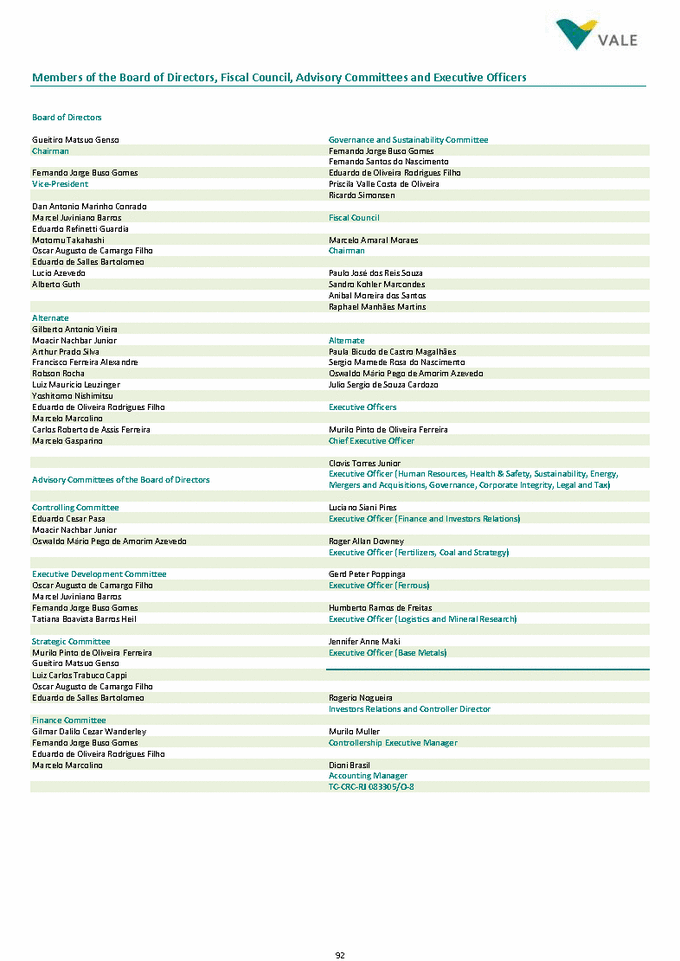- VALE Dashboard
- Financials
- Filings
-
Holdings
- Transcripts
- ETFs
-
Insider
- Institutional
- Shorts
-
6-K Filing
Vale (VALE) 6-KCurrent report (foreign)
Filed: 16 May 17, 12:00am
Exhibit 6
Financial Statements December 31, 2016 BRGAAP in R$ (English)
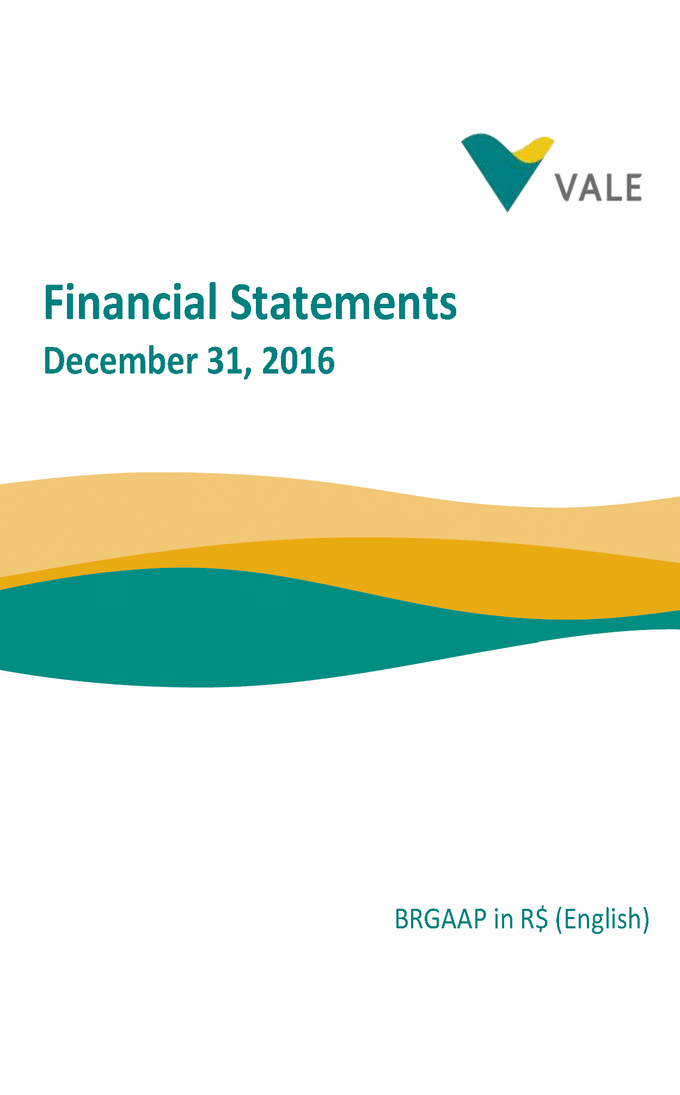
Vale S.A. Financial Statements Contents Page 3 Report of independent registered public accounting firm Consolidated and Parent Company Statement of Comprehensive Income 12 Consolidated and Parent Company Statement of Financial Position 14 Consolidated and Parent Company Value Added Statement 16 1. Corporate information 3. Information by business segment and by geographic area 5. Costs and expenses by nature 7. Deferred revenue - Gold stream transaction 9. Basic and diluted earnings (loss) per share 11. Inventories 13. Other financial assets and liabilities 15. Investments 17. Intangibles 19. Impairment and onerous contracts 21. Liabilities related to associates and joint ventures 23. Financial instruments classification 25. Derivative financial instruments 27. Asset retirement obligations 29. Employee benefits 31. Related parties 33. Additional information about derivatives financial instruments 2 Members of the Board of Directors, Fiscal Council, Advisory Committees and Executive Officers92 32. Commitments 30. Stockholders’ equity 28. Litigation 26. Provisions 24. Fair value estimate 22. Risk management 20. Loans, borrowings and cash and cash equivalents 18. Property, plant and equipment 16. Noncontrolling interest 14. Non-current assets and liabilities held for sale and discontinued operations 12. Recoverable taxes 10. Accounts receivable 8. Income taxes 6. Financial results 4. Special events occurred during the year 2. Basis for preparation of the financial statements Notes to the Financial Statements17 Statement of Changes in Equity15 Consolidated and Parent Company Statement of Cash Flows13 Consolidated and Parent Company Income Statement11
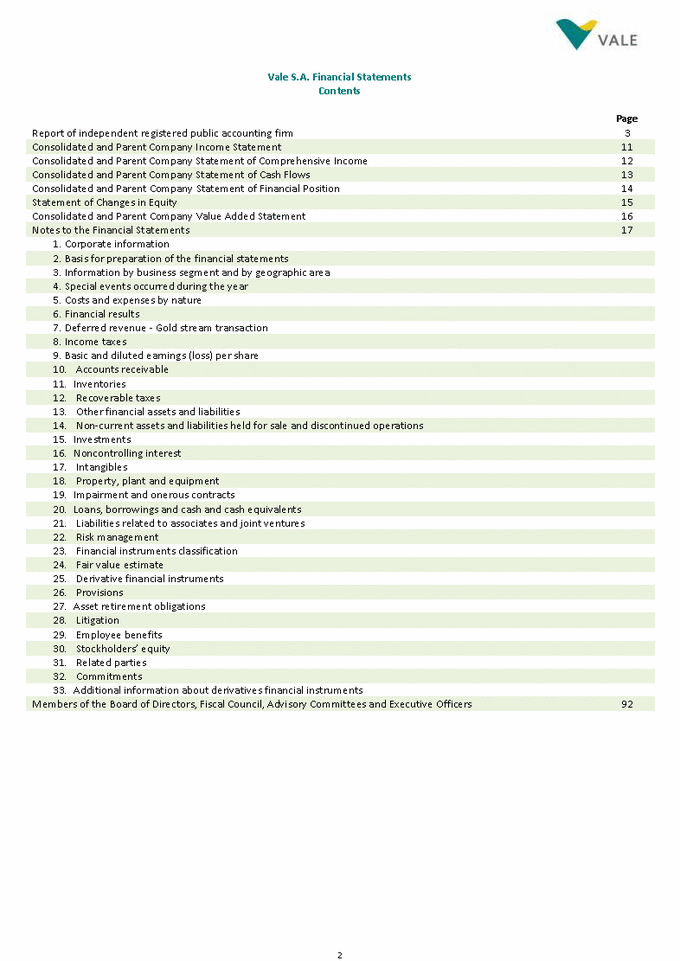
KPMG Auditores Independentes Av. Almirante Barroso, 52 - 4º 20031-000 - Rio de Janeiro, RJ - Brasil Caixa Postal 2888 20001-970 - Rio de Janeiro, RJ - Brasil Central Tel Fax Internet 55 (21) 3515-9400 55 (21) 3515-9000 www.kpmg.com.br Independent auditor’s report on the financial statements (A free translation of the original report in Portuguese as published in Brazil containing financial statement prepared in accordance with accounting practices adopted in Brazil and rules of the International Financial Reporting Standards - IFRS) To The Stockholders, Counselors and Management of Vale S.A. Rio de Janeiro - RJ Opinion We have audited the individual and consolidated financial statements of Vale S.A. (“the Company”), identified as Parent Company and Consolidated, respectively, which comprise the individual and consolidated balance sheet as of December 31, 2016, the statements of income, comprehensive income, changes in equity and cash flows for the year then ended, and notes comprising significant accounting policies and other explanatory information. In our opinion, the aforementioned financial statements present fairly, in all material respects, the individual and consolidated financial position of Vale S.A. as of December 31, 2016, and of its individual and consolidated financial performance and its individual and consolidated cash flows for the year then ended in accordance with accounting practices adopted in Brazil and in accordance with International Financial Reporting Standards (IFRS), as issued by the International Accounting Standards Board - IASB. Basis for Opinion We conducted our audit in accordance with Brazilian and International Standards on Auditing. Our responsibilities under those standards are further described in the Auditors’ Responsibilities for the Audit of the individual and consolidated Financial Statements section of our report. We are independent of the Company and its subsidiaries in accordance with the ethical requirements of Ethics Standards Boards for Accountants and Professional Standard issued by Federal Accounting Council, and we have fulfilled our other ethical responsibilities in accordance with these requirements. We believe that the audit evidence we have obtained is sufficient and appropriate to provide a basis for our opinion. Key Audit Matters Key audit matters are those matters that, in our professional judgment, were of most significance in our audit of the current period. These matters were addressed in the context of our audit of the individual and consolidated financial statements as a whole, and in forming our opinion thereon, and we do not provide a separate opinion on these matters. 3
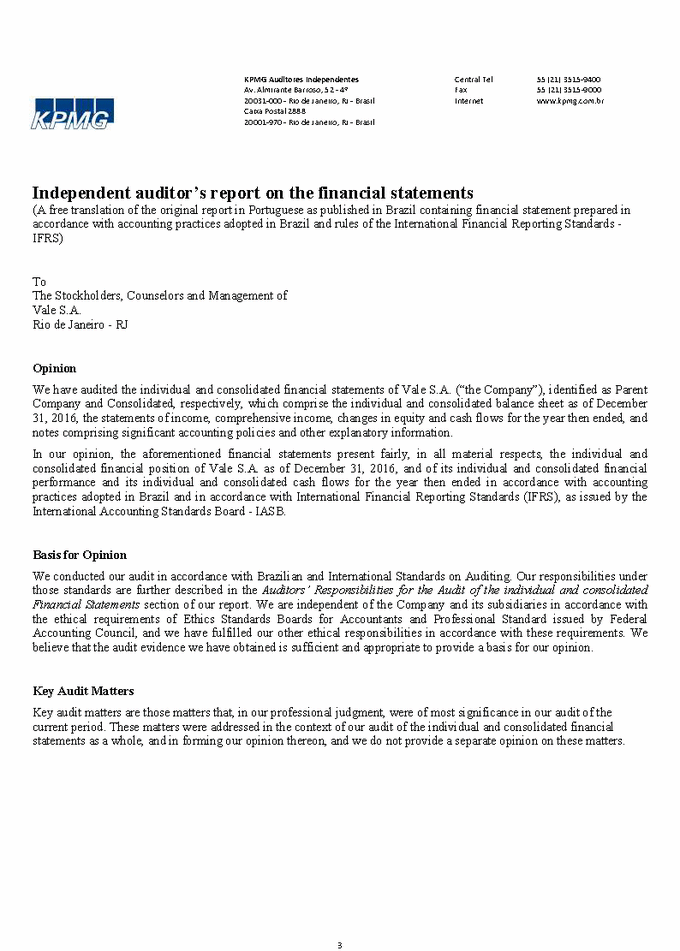
Design, implementation and operating goodwill, and definition of Cash-Generating control on the valuation of the judgments concerning factors related to the at identifying the need for recording or price, production cost and economic where the Company operates. Due to the assumptions and estimates to determine goodwill, and to the level of uncertainty for including the ones related to production, may impact the value of those assets in the discount rates and exchange rates; Assessment of the definition and value of the investment recorded under the Generating Units (CGUs); company's financial statements, we matter for the audit. specialists in economic and financial 4 1 – Impairment – Individual and consolidated financial statements As per Notes 17,18 and 19 to the financial statements The assessment with respect to theOur procedures included, among others, the recoverability of property, plant andfollowing ones: equipment (“PP&E”), intangible assets and Units (CGUs) encompasses significanteffectiveness testing of the internal level of future production, commoditiesCompany's assets, including those aimed assumptions such as discount rates, inflationreversing impairment; rates and exchange rates of the countries Assessment of the Company's materiality of PP&E, intangible assets andthe recoverable value of its assets, determining the related impairment, whichproduction cost, capital investments, consolidated financial statements and the equity method pick-up in the parentidentification criteria for Cash-considered this subject as a significant Assessment, with the support of our assumptions, of the cash flow forecast, reasonableness and consistency of the assumptions used in the preparation of the cash flow forecasts and comparison of those assumptions with market information. Based on our knowledge of the Company and Industry, preparation of sensitivity analysis; Arithmetic checking of the economic models regarding future cash flows and forecast results, combining them with accounting information and management reports and approved business plans; and Appropriateness assessment of the disclosure in relation to the testing of the value in use and the comparison of the latter with the fair value, net of costs to sell, in the applicable cases. MatterProcedures Performed
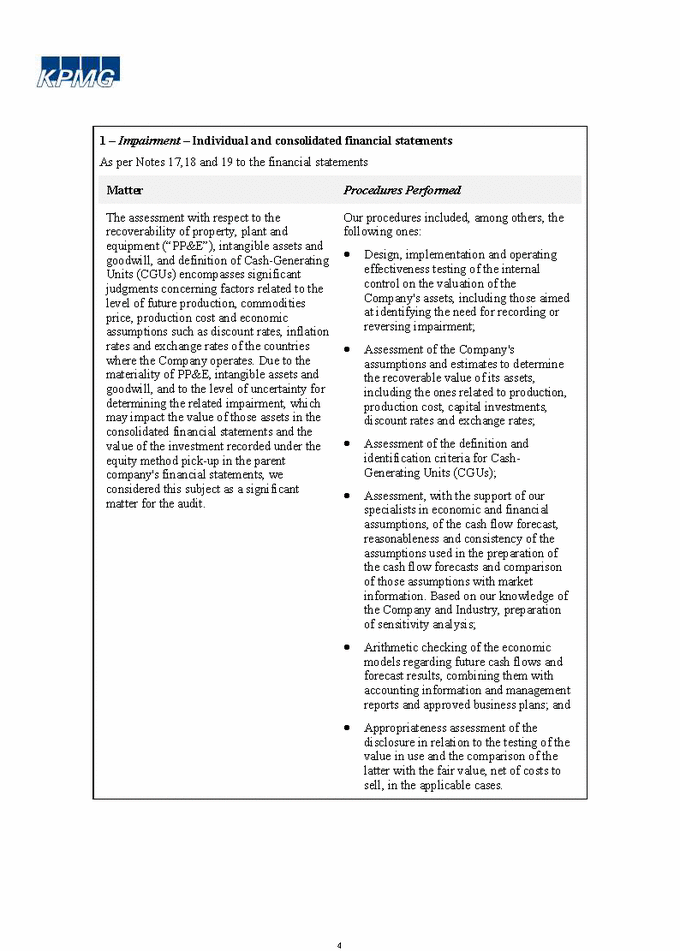
Design, implementation and and environment rehabilitation is required by the internal control related to the and the Company's policies. Estimating costs the asset retirement obligation considerable judgement in relation to factors rehabilitate areas commercially time required to rehabilitate and certain relevance of the asset retirement obligation and including the base cost of the its estimate, which may impact the amount of discount rates and risk rates; Analysis of the provision statements and the amount of the investment the retired, restored/rehabilitated financial statements of the parent company, We environmental obligation, aiming the audit 5 2 – Asset Retirement Obligation (ARO) – Individual and consolidated financial statements As per Notes 26 and 27 to the financial statements As a result of its operations, the CompanyOur procedures included, among others, incurs in obligations to restore and rehabilitatethe following ones: the environment on retiring the areas. The areas the combination of both the legislation in forceoperating effectiveness testing of related to those future activities requiresdetermination of estimates for such as how long a certain area will be used, theprovision to restore and economic assumptions such as the discount rateexploited by the Company; and foreign currency exchange rates. Due to the Analysis of assumptions used, the level of uncertainty for the determination ofareas to be left, inflation rates, this provision in the consolidated financial recorded under the equity method pick-up in themovement for the year related to consider this subject as a significant matter forareas, and the relevant at verifying the primary inputs such as costs, inflation and discount rates, as well as an approved retirement plan; and Appropriateness assessment of the disclosure in relation to the obligations to rehabilitate the environment on retiring the areas. MatterProcedures Performed
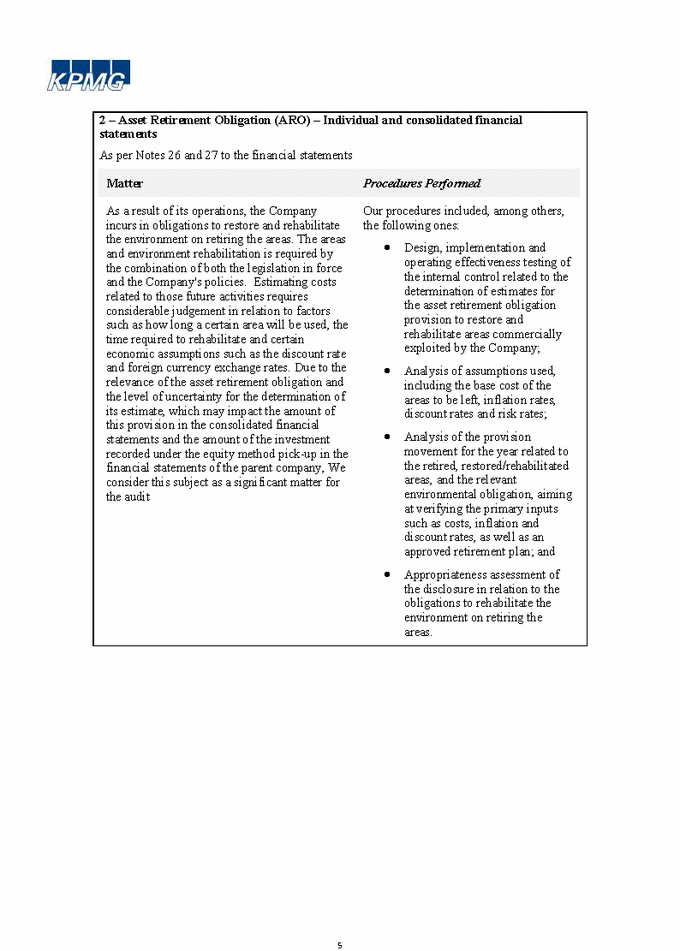
Design, implementation and activities triggers various tax liabilities, internal control related to the contributions, royalties and taxes on recording the amounts of provisions commodities export operations also create by the Company; transfer pricing issues. Applying tax specialized activity, which requires the tax department, we assess the exposure estimates and for quantification of paying taxes, and the assumptions uncertainty and judgment involved in the provisions and amounts disclosed the amount recorded in the consolidated the Company with the tax legislation investment recorded under the equity relation to market practices and financial statements, we consider this based on our knowledge of and 6 3 – Income taxes – Individual and consolidated financial statements As per Notes 8 to the financial statements. The Company has operations in variousOur procedures included, among others, the countries, each one with its own taxationfollowing ones: regime. The nature of the Company's including tax on income, socialoperating effectiveness testing of the revenue. The nature of the Company'sdetermination of estimates for complexities related to internationalfor taxes payable and taxes to offset legislation is a complex and highly With the help of our specialists from judgement for the assessment of taxcriteria used for determining and contingent liabilities. Due to the level ofused by the Company to determine determining this estimate that may impactas tax exposure and contingencies; financial statements and the amount of the We compare the assumptions used by method pick-up in the parent company'sapplicable to each jurisdiction, and in subject as a significant matter for the audit.assessments performed by ourselves, experience in the Company's operations in the use of the aforementioned legislation and on applicable precedents and sentences; and Assessment of the appropriateness of the Company's disclosures, particularly disclosures regarding current and deferred taxes and possible tax exposure. MatterProcedures Performed
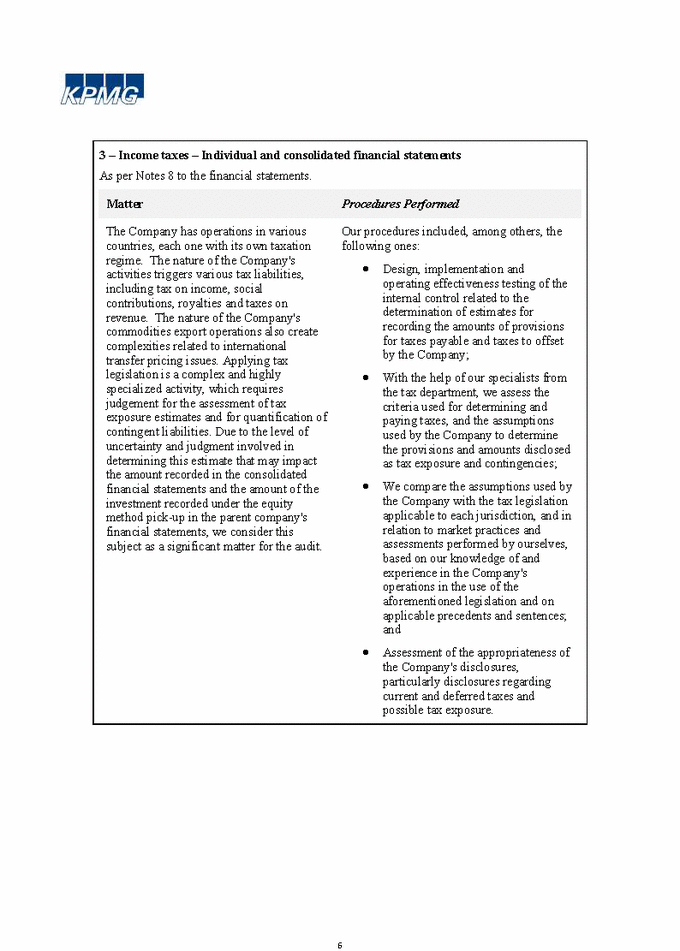
Design, implementation and operating its activities. The measurement, accounting control related to the determination of of Provisions and Contingent Liabilities, accordance with the loss prognosis for require judgement from the Company´s cases, the appropriateness of the provisions provisions recognized and contingency disclosures. Due to the materiality, of criteria and assumptions used for assessment and measurement of the provision and/or amounts disclosed, and may impact the amount recorded in the prepared by the Company's internal and amount of the investment recorded under the with the existing precedents; Assess the analysis of chances of loss statements of the parent company, we information related to the principal for the audit. 7 4 – Provision for litigation and disclosure of contingent liabilities - Individual and consolidated financial statements As per Note 28 to the financial statements The Company is a party (as defendant) toOur procedures included, among others, the various litigation of tax, civil and laborfollowing ones: nature deriving from the ordinary course of recognition of a provision, and the disclosureeffectiveness testing of the internal related to the aforementioned litigation,estimates for recording the amounts in professionals and from its legal advisorsthe lawsuits; with respect to the integrity of the existing Assessment of the sufficiency of recorded and their correspondingamounts disclosed, by means of analysis complexity and judgement involved in themeasuring amounts recorded as Provisions and Contingent Liabilities, whichtook into account the assessments consolidated financial statements and theexternal legal advisors, and comparison equity method pick-up in the financial consider this subject as a significant matterregarding existing documentation and proceedings and complaints involving the Company through external confirmation of balances with external legal advisors; Assessment of the appropriateness of the Company's disclosures in relation to lawsuits provided for and those lawsuits with a possible loss prognosis. MatterPerformed Procedures
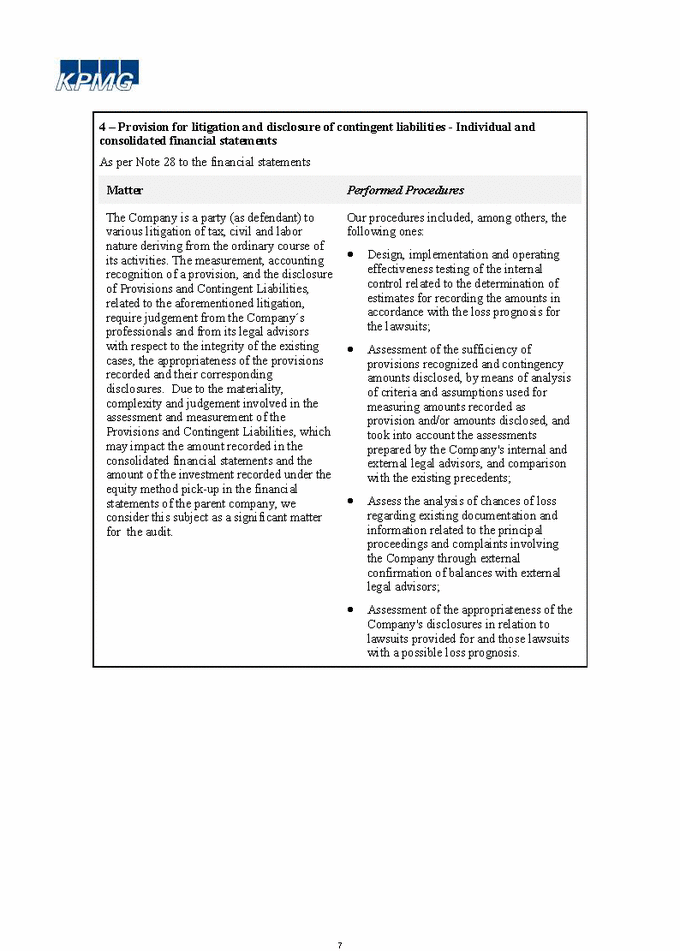
Design, implementation and operating derivative financial instruments, forward control related to the process of operations and zero cost-collars - as a instruments; value of financial instruments not traded on judgement from the Company when Company, with the help of our assumptions such as the classification of fair determine fair values and reasonableness calculating present value, taking the existing included in the pricing models used, reporting date. Due to the materiality, and compared the assumptions used to assessing and measuring the financial operations performed in the marketplace; instruments or not, which may impact the Company's disclosures, regarding financial statements and the amount of the foreign exchange risk, and the method pick-up in the financial statements others. subject as a significant matter for the audit. 8 5 – Financial Instruments – Individual and consolidated financial statements As per Note 23, 24 and 25 to the financial statements. The Company contracts financialOur procedures included, among others, the instruments which much be measured andfollowing ones: assessed at their fair value - including operations, swap operations, futureseffectiveness testing of the internal strategy to hedge equity. Estimating the fairidentifying and valuing financial active markets requires considerable We tested the models developed by the determining prices or parameters andspecialists in financial instruments, to value hierarchy, discount rates forof data, parameters and information market conditions into account as of therecalculated the amount of operations, complexity and judgement involved indetermine fair values with similar instruments, whether derivative financialand amount recorded in the consolidated Assessment of the appropriateness of the investment recorded under the equitysensitivity analyses, interest rate risk and of the parent company, we consider thisclassification of instruments, among MatterPerformed Procedures
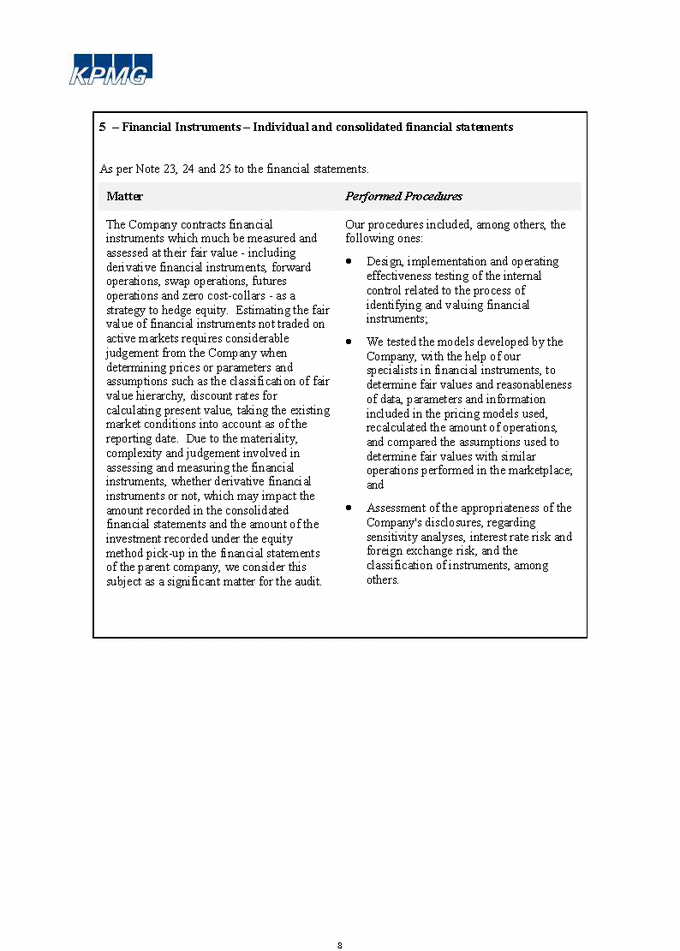
Other Information – Statement of Added Value The individual and consolidated statements of value added (DVA) for the year ended December 31, 2016, prepared under the responsibility of the Company's management, and presented as supplementary information for IFRS purposes, was submitted for the auditing procedures jointly with audit of the Company's financial statements. For the purposes of forming our opinion, we evaluate whether these statements are reconciled with the financial statements and accounting records, as applicable, and if their form and content are in accordance with the criteria as defined in Technical Pronouncement CPC 09 - Statement of Added Value. In our opinion, this statement of value added have been properly prepared, in all material respects, in accordance with the criteria defined in this Technical Pronouncement and is consistent with the individual and consolidated financial statements taken as a whole. Other information accompanying the individual and consolidated financial statements and the auditor's report Management is responsible for the other information, which comprises the Management report. Our opinion on the individual and consolidated financial statements does not cover the other information and we do not express any form of assurance conclusion thereon. In connection with our audit of the individual and consolidated financial statements, our responsibility is to read the Management Report and, in doing so, consider whether the other information is materially inconsistent with the financial statements or our knowledge obtained in the audit, or otherwise appears to be materially misstated. If, based on the work we have performed, we conclude that there is a material misstatement of this Management Report, we are required to report that fact. We have nothing to report regarding this matter. Responsibilities of management and those charged with governance for the individual and consolidated financial statements Management is responsible for the preparation and fair presentation of the individual and consolidated financial statements in accordance with accounting practices adopted in Brazil and in accordance with International Financial Reporting Standards (IFRS), as issued by the International Accounting Standards Board (IASB) , and for such internal control as management determines is necessary to enable the preparation of individual and consolidated financial statements that are free from material misstatement, whether due to fraud or error. In preparing the individual and consolidated financial statements, management is responsible for assessing the Company’s ability to continue as a going concern, disclosing, as applicable, matters related to going concern and using the going concern basis of accounting unless management either intends to liquidate the Company or to cease operations, or has no realistic alternative but to do so. Those charged with governance are responsible for overseeing the Company’s financial reporting process. Auditors’ responsibilities for the audit of the individual and consolidated financial statements Our objectives are to obtain reasonable assurance about whether the individual and consolidated financial statements as a whole are free from material misstatement, whether due to fraud or error, and to issue an auditors’ report that includes our opinion. Reasonable assurance is a high level of assurance, but is not a guarantee that an audit conducted in accordance with Brazilian and International Standards on Auditing will always detect a material misstatement when it exists. Misstatements can arise from fraud or error and are considered material if, individually or in the aggregate, they could reasonably be expected to influence the economic decisions of users taken on the basis of these individual and consolidated financial statements. 9
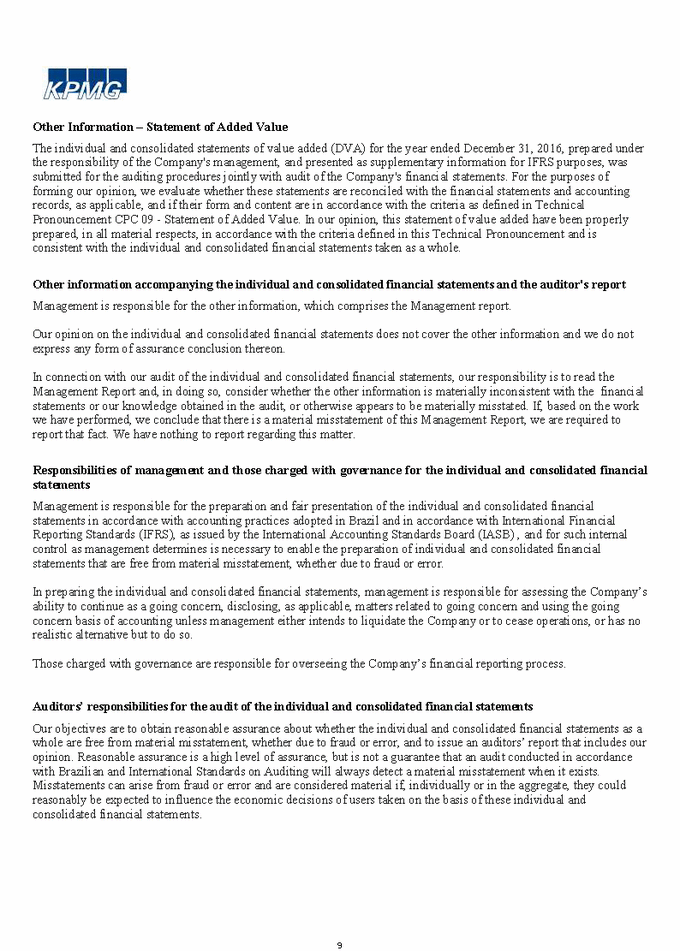
As part of an audit in accordance with Brazilian and International Standards on Auditing, we exercise professional judgment and maintain professional skepticism throughout the audit. We also: Identify and assess the risks of material misstatement of the individual and consolidated financial statements, whether due to fraud or error, design and perform audit procedures responsive to those risks, and obtain audit evidence that is sufficient and appropriate to provide a basis for our opinion. The risk of not detecting a material misstatement resulting from fraud is higher than for one resulting from error, as fraud may involve collusion, forgery, intentional omissions, misrepresentations, or the override of internal control. Obtain an understanding of internal control relevant to the audit in order to design audit procedures that are appropriate in the circumstances, but not for the purpose of expressing an opinion on the effectiveness of the Company’s internal control. Evaluate the appropriateness of accounting policies used and the reasonableness of accounting estimates and related disclosures made by management. Conclude on the appropriateness of management’s use of the going concern basis of accounting and, based on the audit evidence obtained, whether a material uncertainty exists related to events or conditions that may cast significant doubt on the Company’s ability to continue as a going concern. If we conclude that a material uncertainty exists, we are required to draw attention in our auditors’ report to the related disclosures in the individual and consolidated financial statements or, if such disclosures are inadequate, to modify our opinion. Our conclusions are based on the audit evidence obtained up to the date of our auditors’ report. However, future events or conditions may cause the Company to cease to continue as a going concern. Evaluate the overall presentation, structure and content of the financial statements, including the disclosures, and whether the individual and consolidated financial statements represent the underlying transactions and events in a manner that achieves fair presentation. Obtain sufficient appropriate audit evidence regarding the financial information of the entities or business activities within the Company to express an opinion on the consolidated financial statements. We are responsible for the direction, supervision and performance of the group audit. We remain solely responsible for our audit opinion. We communicate with those charged with governance regarding, among other matters, the planned scope and timing of the audit and significant audit findings, including any significant deficiencies in internal control that we identify during our audit. We also provide those charged with governance with a statement that we have complied with relevant ethical requirements regarding independence, and communicate with them all relationships and other matters that may reasonably be thought to bear on our independence, and where applicable, related safeguards. From the matters communicated with those charged with governance, we determine those matters that were of most significance in the audit of the (consolidated) financial statements of the current period and are therefore the key audit matters. We describe these matters in our auditors’ report unless law or regulation precludes public disclosure about the matter, or, when in extremely rare circumstances, we determine that a matter should not be communicated in our report because the adverse consequences of doing so would reasonably be expected to outweigh the public interest benefits of such communication. Rio de Janeiro, February 22, 2017 /s/KPMG Auditores Independentes KPMG Auditores Independentes CRC SP-014428/O-6 F-RJ /s/Manuel Fernandes Rodrigues de Sousa Manuel Fernandes Rodrigues de Sousa Accountant CRC-RJ-052428/O-2 10
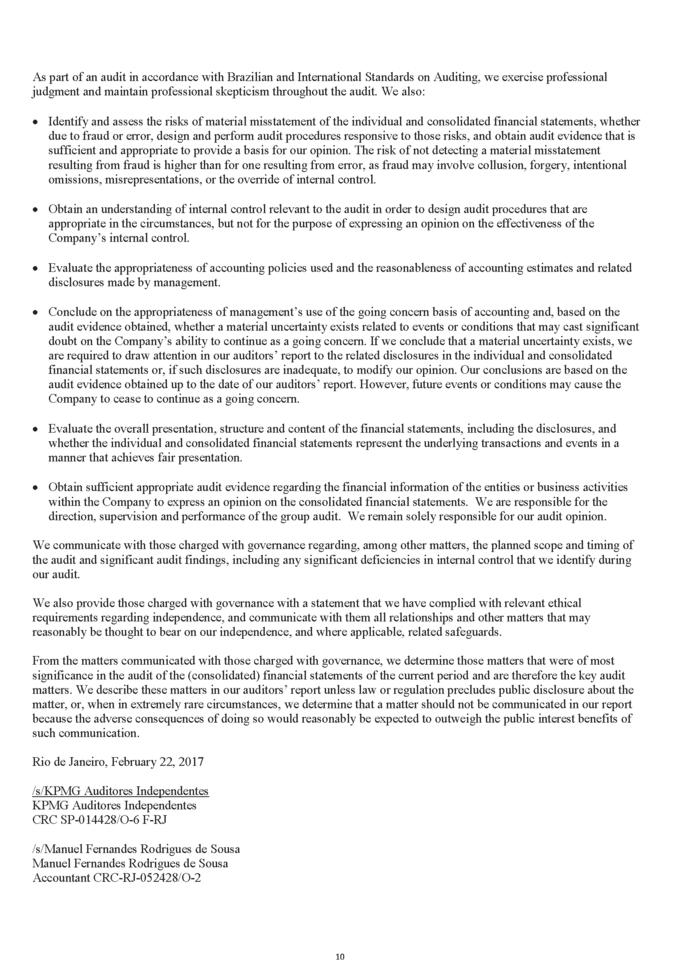
Income Statement In millions of Brazilian Reais, except earnings per share data Consolidated Parent Company Continuing operations Cost of goods sold and services rendered 5(a) (61,143) (62,780) (53,773) (29,663) (27,522) Selling and administrative expenses 5(b) (1,755) (2,009) (2,452) (1,021) (1,141) Pre operating and operational stoppage (1,570) (3,127) (2,299) (684) (618) Other operating income (expenses), net 5(c) (937) (588) (2,477) (1,166) 72 Impairment of non-current assets and onerous contracts 19 (3,940) (33,945) 87 205 270 Operating income (loss) 23,962 (25,666) 19,696 14,911 (21,938) Financial income 6 27,657 25,968 8,514 25,656 25,822 Equity results in associates and joint ventures 15 1,111 (1,526) 1,131 1,111 (1,526) Net income (loss) before income taxes 27,022 (64,676) 6,062 17.545 (55.047) Income taxes 8 Deferred tax (6,260) 20,487 (1,282) (2,048) 10,816 Loss attributable to noncontrolling interests (6) (1,815) (749) - - Loss from discontinued operations (4,159) (660) (2,185) - - Loss from discontinued operations attributable to Vale's stockholders (4,150) (691) (2,199) - - Net income (loss) 13,296 (45,997) 219 13,311 (44,213) Net income (loss) attributable to Vale's stockholders 13,311 (44,213) 954 13,311 (44,213) Earnings (loss) per share attributable to Vale's stockholders: Preferred share (R$) 2.58 (8.58) 0.19 2.58 (8.58) 2.58 (8.58) 0.19 2.58 (8.58) The accompanying notes are an integral part of these financial statements. 11 Common share (R$) 9 Basic and diluted earnings (loss) per share: (15) (1,784) (735) - - Loss attributable to noncontrolling interests (9) 31 14 - - Income (loss) attributable to noncontrolling interests 14 Discontinued operations Net income (loss) from continuing operations attributable to Vale's stockholders 17,461 (43,522) 3,153 13,311 (44,213) (44,213) 13,311 2,404 (45,337) 17,455 Net income (loss) from continuing operations (9,567) 19,339 (3,658) (4,234) 10,834 18 (2,186) (2,376) (1,148) (3,307) Current tax (4,353) (1,431) (139) (4,233) (455) 15, 19 and 21 Impairment and other results in associates and joint ventures (56,950) (19,900) (23,140) (62,021) (21,355) 6 Financial expenses (228) 52 (441) - 546 14 Results on measurement or sale of non-current assets (5,360) (7,050) (8,796) (2,055) (37,792) (35,338) 1,493 - - - 15 Equity results from subsidiaries (767) (677) (1,568) (1,326) (1,098) Research and evaluation expenses Operating (expenses) income Gross profit 33,490 15,277 28,846 16,761 15,038 42,560 46,424 82,619 78,057 94,633 3(d) Net operating revenue Notes 2016 2015 2014 2016 2015 Year ended December 31
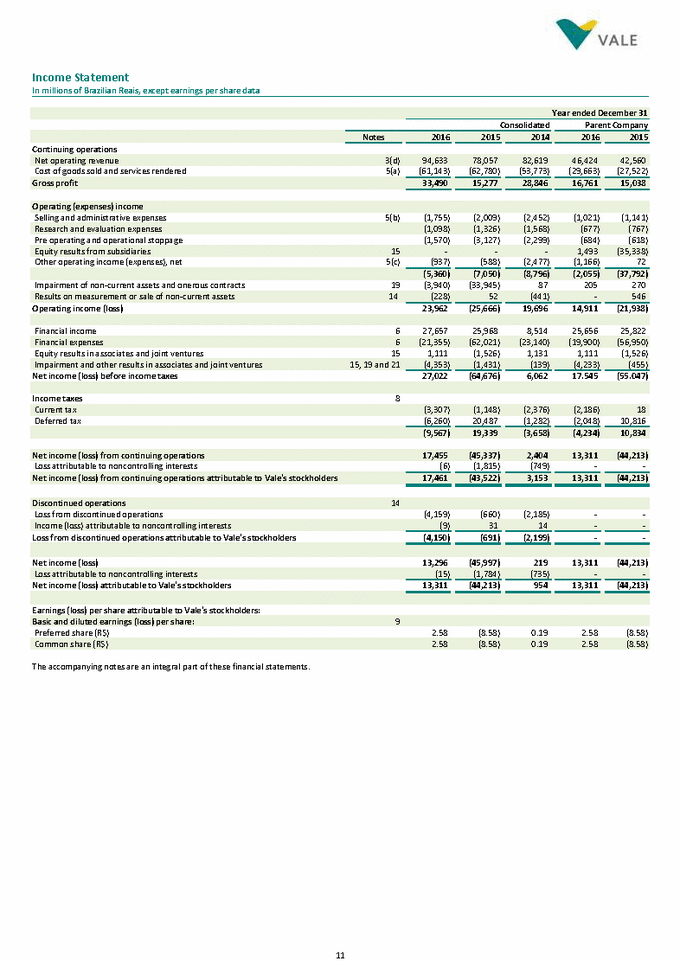
Statement of Comprehensive Income In millions of Brazilian Reais Consolidated Parent Company Net income (loss) 13,296 (45,997) 219 13,311 (44,213) Items that will not be reclassified subsequently to the income statement Gross balance for the year (419) 261 (661) (163) (136) Equity results in associates and joint ventures, net of taxes - - 4 (155) 350 Total items that will not be reclassified subsequently to the income statement (266) 257 (453) (263) 260 Items that may be reclassified subsequently to the income statement Gross balance for the year (13,879) 32,444 8,771 (13,283) 34,409 Transfer of realized results to net income (266) - - (266) - Gross balance for the year 4 2 (8) - - Transfer of realized results to net income, net of taxes - - 8 - - Cash flow hedge Effect of taxes (3) (23) (6) - - Transfer of realized results to net income, net of taxes (10) (1,157) (303) - - Total of items that may be reclassified subsequently to the income statement (14,424) 37,404 7,727 (13,519) 35,869 Comprehensive income (loss) attributable to noncontrolling interests (923) (252) (444) The accompanying notes are an integral part of these financial statements. 12 (471) (8,084) 7,937 Comprehensive income (loss) attributable to Vale's stockholders Total comprehensive income (loss) (1,394) (8,336) 7,493 (471) (8,084) 26 1,458 (1,044) 26 1,458 1,458 26 (4) (17) 16 Equity results in associates and joint ventures - - (731) 2,655 23 Gross balance for the year 4 2 - 4 2 2 4 - - - Equity results from associates and joint ventures, net taxes Available-for-sale financial instruments (14,454) 35,944 8,771 (13,549) 34,409 - - - 3,500 (309) Effect of taxes Cumulative translation adjustments (266) 257 (453) (263) 260 46 55 204 (4) 153 Effect of taxes Retirement benefit obligations Other comprehensive income (loss): 2016 2015 2014 2016 2015 Year ended December 31
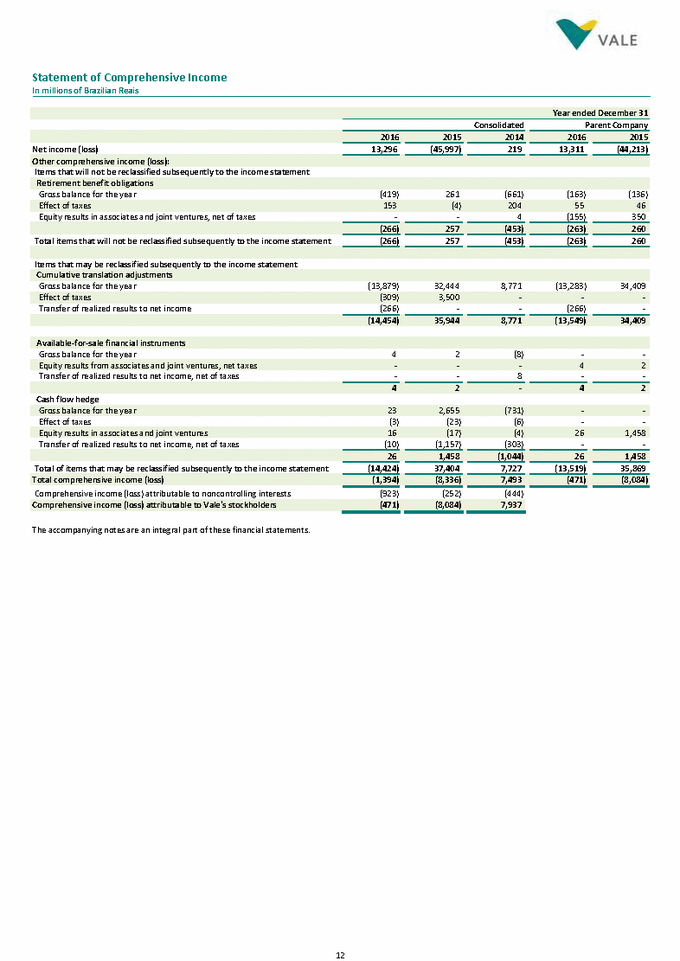
Statement of Cash Flows In millions of Brazilian Reais Consolidated Parent Company Cash flow from operating activities: Continuing operations adjustments for: Results on measurement or sale of non-current assets (253) (479) 673 - (546) Impairment of non-current assets and onerous contracts 3,940 33,945 (87) (205) (270) Financial results, net (6,302) 36,053 14,626 (5,756) 31,128 Accounts receivable (9,863) 5,212 5,360 4,503 6,404 Suppliers and contractors 768 2,143 2,289 243 1,550 Other taxes assets and liabilities, net (371) (687) (633) (227) (79) Other assets and liabilities, net 2,706 (469) (524) (1,923) (1,021) Interest on loans and borrowings paid (5,894) (4,812) (3,515) (5,905) (4,756) Interest on participative stockholders' debentures paid (268) (209) (280) (268) (209) Income taxes - Settlement program (1,426) (1,284) (1,161) (1,397) (1,257) Net cash provided by operating activities from discontinued operations 498 1,928 286 - - Financial investments redeemed (invested) 45 932 (392) 15 373 Guarantees and deposits - net receipts (payments) (141) (246) 199 (127) (197) Additions to property, plant and equipment and intangible (note 3(b)) (17,343) (26,931) (26,254) (11,494) (16,094) Proceeds from disposal of assets and investments 1,785 5,211 2,597 169 4,366 Net cash used in investing activities from continuing operations (15,673) (19,180) (22,399) (12,050) (15,841) - - Net cash used in investing activities (16,639) (20,116) (22,360) (12,050) (15,841) Cash flow from financing activities from continuing operations: Loans and borrowings (i) Additions 25,667 16,603 5,947 18,094 19,571 Repayments (26,630) (9,949) (4,515) (16,264) (14,749) Transactions with stockholders: Dividends and interest on capital paid to Vale's stockholders (857) (5,026) (9,739) (857) (5,026) Dividends and interest on capital paid to noncontrolling interest (972) (46) (164) - - Transactions with noncontrolling stockholders (69) 3,875 - 19 - Net cash provided by (used in) financing activities from continuing operations (2,861) 5,457 (8,471) 992 (204) Net cash provided by (used in) financing activities from discontinuing operations (59) (207) (163) - - Net cash provided by (used in) financing activities (2,920) 5,250 (8,634) 992 (204) Increase (decrease) in cash and cash equivalents 2,076 853 (3,202) 685 (167) Cash and cash equivalents in the beginning of the year 14,022 10,555 12,465 518 685 Effect of exchange rate changes on cash and cash equivalents (2,207) 2,614 1,292 - - Cash and cash equivalents at end of the year 13,891 14,022 10,555 1,203 518 Non-cash transactions: Additions to property, plant and equipment - capitalized loans and borrowing costs 2,291 2,531 1,387 1,679 1,258 (i) Includes transactions with related parties: Bradesco, Banco do Brasil and Banco Nacional do Desenvolvimento Econômico e Social - BNDES. The accompanying notes are an integral part of these financial statements. 13 39 (936) (966) Net cash used in investing activities from discontinued operations - - - 1,156 885 Proceeds from gold stream transaction 881 1,591 1,302 1,064 669 Dividends and interest on capital received from associates and joint ventures (5,330) (1,918) (632) (332) (875) Additions to investments 160 (286) 781 (34) (698) Loans and advances - net receipts (payments) Cash flow from investing activities continuing: Net cash provided by operating activities 21,635 15,719 27,792 11,743 15,878 Net cash provided by operating activities from continuing operations 21,137 13,791 27,506 11,743 15,878 (58) (69) (1,149) (1,790) (1,401) Income taxes (769) (2,215) (521) (3,771) (5,604) Derivatives received (paid), net (note 25) Cash provided from operations 35,730 25,657 34,132 21,597 22,927 - - - 1,670 1,683 Deferred revenue - Gold stream (note 7) (1,317) 714 (293) (1,713) 435 Payroll and related charges 228 (135) (1,477) (749) 616 Inventories Changes in assets and liabilities: 4,578 5,209 9,128 12,450 12,107 Depreciation, amortization and depletion 455 4,233 139 1,431 4,353 Impairment and others results in associates and joint ventures 36,864 (2,604) (1,131) 1,526 (1,111) Equity results in associates and joint ventures (55,047) 17,545 6,062 (64,676) 27,022 Net income (loss) before income taxes from continuing operations 2016 2015 2014 2016 2015 Year ended December 31
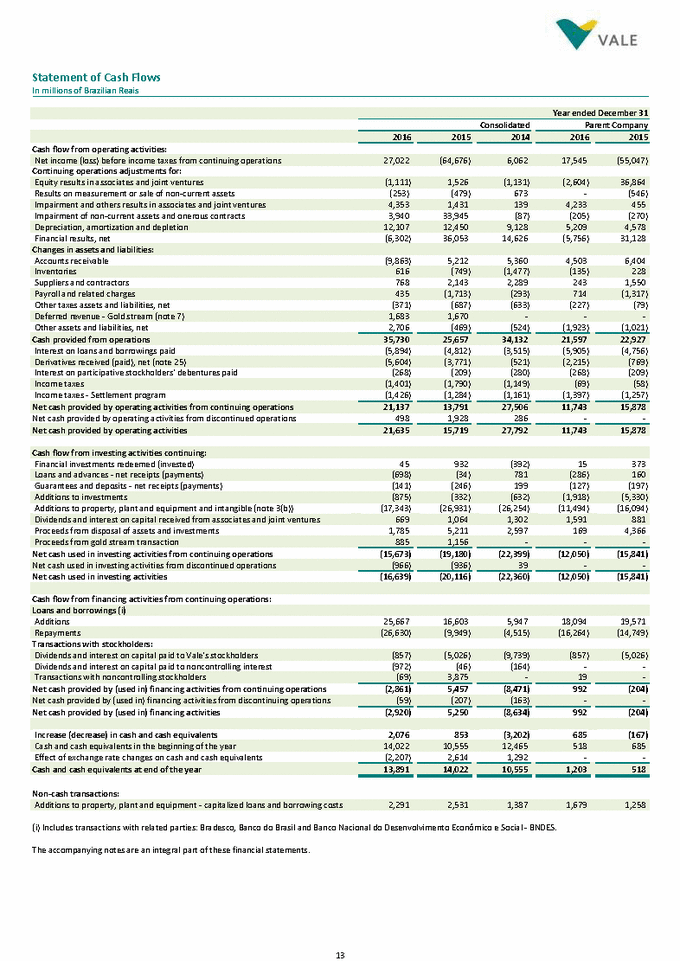
Statement of Financial Position In millions of Brazilian Reais Consolidated Parent Company 2015 Assets Cash and cash equivalents 20 13,891 14,022 1,203 518 Other financial assets 13 1,184 856 1,231 1,048 Prepaid income taxes 518 3,513 312 3,176 45,553 44,626 37,507 48,531 Non-current assets held for sale 14 27,994 15,792 8,936 - Non-current assets Other financial assets 13 2,046 1,100 2,178 1,867 Recoverable taxes 12 2,368 1,956 2,223 1,457 Others 894 2,392 618 765 Intangibles 17 22,395 20,789 11,314 8,557 249,149 285,129 243,908 257,049 Current liabilities Loans and borrowings 20 5,410 9,788 4,171 4,736 Taxes payable 2,144 2,325 1,883 1,780 Liabilities related to associates and joint ventures 21 951 - 951 - Dividends and interest on capital 2,602 - 2,602 - 33,056 40,766 29,901 25,719 3,554 416 - - 36,610 41,182 29,901 25,719 Non-current liabilities Loans and borrowings 20 90,154 102,878 47,877 55,986 Other financial liabilities 13 6,932 8,298 59,681 70,469 Taxes payable 16,170 15,953 15,838 15,626 Deferred income taxes 8(a) 5,540 6,520 - Provisions 26 18,730 20,867 4,396 4,103 Liabilities related to associates and joint ventures 21 2,560 - 2,560 - Deferred revenue - Gold stream 7 6,811 6,830 - - Others 5,487 3,600 2,857 2,517 152,384 164,946 133,209 148,701 Total liabilities 188,994 206,128 163,110 174,420 Stockholders' equity 30 Equity attributable to Vale's stockholders 127,241 131,160 127,241 131,160 Equity attributable to noncontrolling interests 6,461 8,259 - - Total stockholders' equity 133,702 139,419 127,241 131,160 Total liabilities and stockholders' equity 322,696 345,547 290,351 305,580 The accompanying notes are an integral part of these financial statements. 14 14 Liabilities associated with non-current assets held for sale 2,921 2,448 914 774 Others 1,012 1,792 2,159 3,103 26 Provisions - - 943 556 Provision for income taxes 10,333 10,845 9,963 3,539 13 Other financial liabilities 7,084 6,743 13,140 11,830 Suppliers and contractors Liabilities Total assets 322,696 345,547 290,351 305,580 96,887 102,056 180,616 211,259 18 Property, plant and equipment 127,517 107,539 11,481 12,046 15 Investments 34,092 41,600 22,999 24,088 17,292 15,299 30,867 23,931 8(a) Deferred income taxes - - 1,840 1,718 Prepaid income taxes 2,707 2,681 3,445 3,135 28(c) Judicial deposits 73,547 60,418 46,443 48,531 3,352 581 5,296 1,814 5,482 3,962 1,215 594 12 Recoverable taxes Others 3,830 3,982 13,775 10,913 11 Inventories 36,026 26,223 5,763 11,937 10 Accounts receivable Current assets December 31, 2016 December 31, December 31, 2016 December 31, 2015 Notes
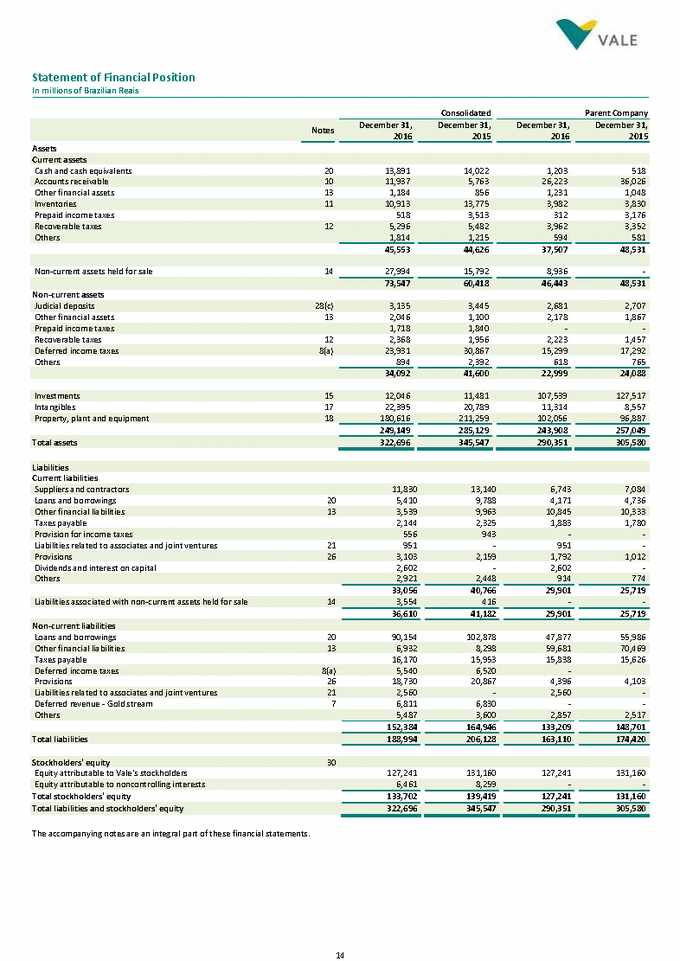
Statement of Changes in Equity In millions of Brazilian Reais Balance at December 31, 2013 75,000 50 (840) 69,262 (7,838) (2,815) 15,527 - 148,346 3,775 152,121 Other comprehensive income: Cash flow hedge - - - - - (1,044) - - (1,044) - (1,044) Transactions with stockholders: Dividends of noncontrolling interest - - - - - - - - - (18) (18) Capitalization of noncontrolling interest advances - - - - - - - - - 302 302 Cancellation of treasury stock - - - (5,092) 5,092 - - - - - - Appropriation to undistributed retained earnings - - - 209 - - - (209) - - - Loss - - - - - - - (44,213) (44,213) (1,784) (45,997) Retirement benefit obligations - - - - - 260 - - 260 (3) 257 - - - 1,458 - - 1,458 - 1,458 Available-for-sale financial instruments - - - - - 2 - - 2 - 2 Translation adjustments - - - - - (1,040) 35,449 - 34,409 1,535 35,944 Transactions with stockholders: Dividends and interest on capital of Vale's stockholders - - - (5,026) - - - - (5,026) - (5,026) Dividends of noncontrolling interest - - - - - - - - - (123) (123) Acquisitions and disposal of participation of noncontrolling interest - - (911) - - - (1,233) - (2,144) 5,317 3,173 Capitalization of noncontrolling interest advances - - - - - - - - - 130 130 Appropriation to undistributed retained earnings - - - (44,213) - - - 44,213 - - - Balance at December 31, 2015 77,300 50 (1,881) 3,846 (2,746) (3,873) 58,464 - 131,160 8,259 139,419 Net income (loss) - - - - - - - 13,311 13,311 (15) 13,296 Other comprehensive income: Retirement benefit obligations - - - - - (263) - - (263) (3) (266) Cash flow hedge - - - - - 26 - - 26 - 26 Available-for-sale financial instruments - - - - - 4 - - 4 - 4 Translation adjustments - - - - - 367 (13,916) - (13,549) (905) (14,454) Transactions with stockholders: Dividends and interest on capital of Vale's stockholders - - - - - - - (3,459) (3,459) - (3,459) Acquisitions and disposal of participation of noncontrolling interest - - 11 - - - - - 11 (4) 7 Dividends of noncontrolling interest - - - - - - - - - (961) (961) Capitalization of noncontrolling interest advances - - - - - - - - - 90 90 Appropriation to undistributed retained earnings - - - 9,852 - - - (9,852) - - - Balance at December 31, 2016 77,300 50 (1,870) 13,698 (2,746) (3,739) 44,548 - 127,241 6,461 133,702 The accompanying notes are an integral part of these financial statements. 15 - - Cash flow hedge Other comprehensive income: Balance at December 31, 2014 77,300 50 (970) 53,085 (2,746) (4,553) 24,248 - 146,414 3,187 149,601 - - - 8,994 - - - (8,994) - - - Realization of reserves - - - - - - - (2,300) - - 2,300 Capitalization of reserves (558) (428) (130) - - - - - (130) - - Acquisitions and disposal of participation of noncontrolling interest (9,739) - (9,739) (9,739) - - - - - - - Dividends and interest on capital of Vale's stockholders 8,771 291 8,480 - 8,721 (241) - - - - - Translation adjustments (453) - (453) - - (453) - - - - - Retirement benefit obligations Net income (loss) - - - - - - - 954 954 (735) 219 Retained earnings Treasury stocks Profit reserves Total stockholder's equity Equity attributable to noncontrolling interests Equity attributable to Vale’s stockholders Cumulative translation adjustments Unrealized fair value gain (losses) Results from operation with noncontrolling interest Results on conversion of shares Share capital
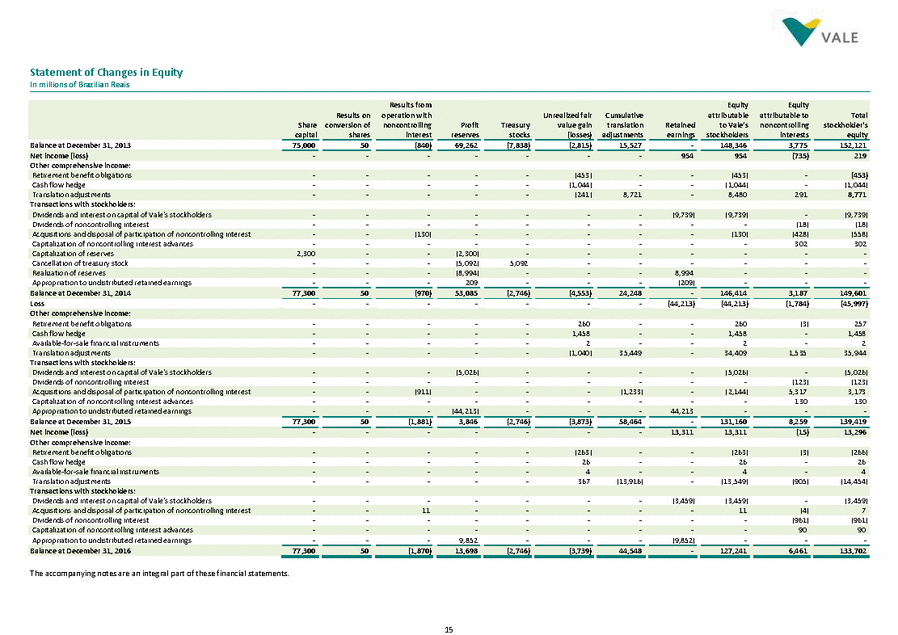
Value Added Statement In millions of Brazilian Reais Consolidated Parent Company Gross revenue Results on measurement or sale of non-current assets (1,074) 348 (597) 601 Allowance for doubtful accounts (9) 46 (3) (9) Less: Material, service and maintenance (29,819) (43,128) (19,328) (25,850) Energy (2,414) (1,643) (1,040) (941) Impairment of non-current assets and others results (7,447) (35,672) (3,431) (240) Gross value added 42,531 2,726 28,344 30,974 Net value added 30,424 (9,724) 23,135 26,396 Received from third parties Financial income 606 4,730 345 3,377 Total value added from continuing operations to be distributed 25,350 5,468 19,686 5,737 Total value added to be distributed 27,789 9,398 19,686 5,737 Personnel 7,699 9,004 3,082 4,573 Current income tax 3,307 1,148 2,186 (18) Financial expense (excludes capitalized interest) 10,169 16,796 9,987 11,050 Other remunerations of third party funds (2,606) 1,686 (245) 2,496 Net income (loss) attributable to noncontrolling interest (15) (1,784) - - Distributed value added from discontinued operations 2,439 3,930 - - The accompanying notes are an integral part of these financial statements. 16 Distributed value added 27,789 9,398 19,686 5,737 Distributed value added from continuing operations 25,350 5,468 19,686 5,737 (44,213) 13,311 (44,213) 13,311 Reinvested net income (absorbed loss) 36,282 (17,807) 37,097 (17,610) Monetary and exchange variation of liabilities (10,816) 2,048 (20,487) 6,260 Deferred income tax 6,383 7,124 6,221 4,835 Taxes and contributions - - 3,930 2,439 Value added from discontinued operations to be distributed 12,828 (6,398) 11,988 (6,791) Monetary and exchange variation of assets (36,864) 2,604 (1,526) 1,111 Equity results from entities (4,578) (5,209) (12,450) (12,107) Depreciation, amortization and depletion (1,087) (1,390) (10,347) (12,118) Other costs and expenses - (71) (11,877) (8,641) Freight (2,629) (2,720) (4,104) (4,284) Oil and gas (684) (821) (2,527) (1,758) Acquisition of products 569 387 1,894 1,459 Other revenues 17,948 10,185 30,314 12,721 Revenue from the construction of own assets 43,296 47,173 79,422 95,915 Revenue from products and services Generation of value added from continuing operations 2016 2015 2016 2015 Year ended December 31
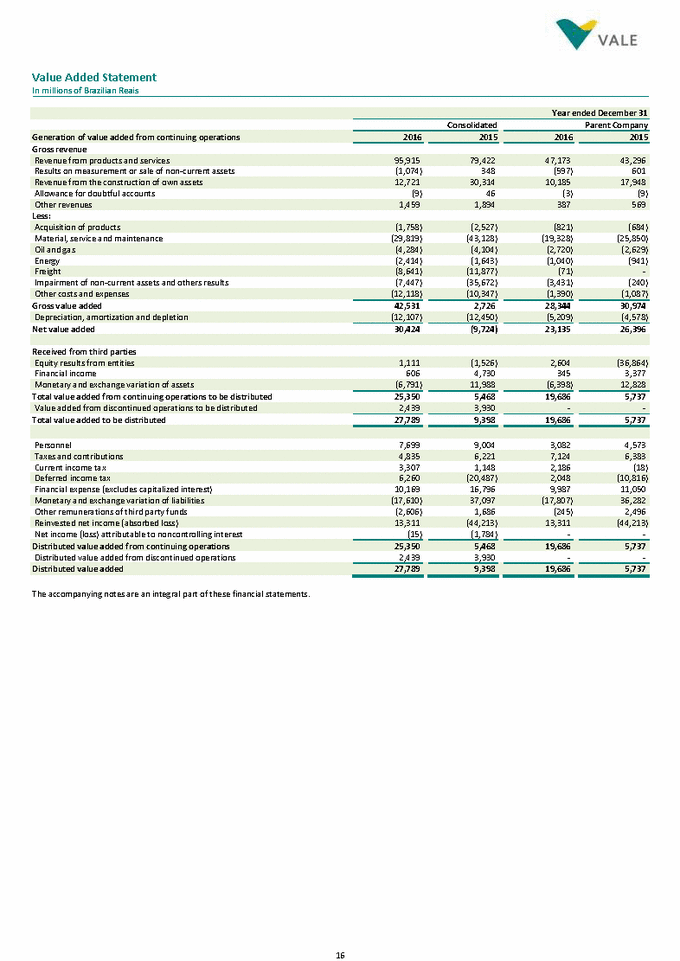
Notes to the Financial Statements Expressed in millions of Brazilian Reais, unless otherwise stated 1. Corporate information Vale S.A. (the “Parent Company”) is a public company headquartered at 700, Avenida das Américas, Rio de Janeiro, Brazil with securities traded on the stock exchanges of São Paulo - BM&F BOVESPA (Vale3 and Vale5), New York - NYSE (VALE and VALE.P), Paris - NYSE Euronext (Vale3 and Vale5) and Madrid – LATIBEX (XVALO and XVALP). Vale and its direct and indirect subsidiaries (“Vale”, “Group” or “Company”) are global producers of iron ore and iron ore pellets, key raw materials for steelmaking, and producers of nickel, which is used to produce stainless steel and metal alloys employed in the production of several products. The Group also produces copper, metallurgical and thermal coal, potash, phosphates and other fertilizer nutrients, manganese ore, ferroalloys, platinum group metals, gold, silver and cobalt. The information by segment is presented in note 3. 2. Basis for preparation of the financial statements a) Statement of compliance The consolidated and individual financial statements of the Company (“financial statements”) have been prepared in accordance with the International Financial Reporting Standards (“IFRS”) as implemented in Brazil by the Brazilian Accountant Pronouncem ents Committee ("CPC"), approved by the Brazilian Securities Exchange Commission ("CVM") and by the Brazilian Federal Accounting Council (“CFC”). All relevant information from its own financial statements, and only this information, are being presented a nd correspond to those used by the Company's Management. The consolidated financial statements present the accounts of the Group. b) Basis of presentation The financial statements have been prepared under the historical cost convention as adjusted to reflect: (i) the fair value o f financial instruments measured at fair value through income statement or available-for-sale financial instruments measured at fair value through the statement of comprehensive income; and (ii) impairment of assets. The comparative information for the years ended December 31, 2015 and 2014 was re-presented for the purposes of applying IFRS 5 "Non-current assets held for sale and discontinued operations" after approval by the Board of Directors of the sale of the fertilizers assets, as presented in Note 14. Subsequent events were evaluated through February 22, 2017, which is the date the financial statements were approved by the Board of Directors. c) Consolidation and investments The financial statements reflect the assets, liabilities and transactions of the Parent Company and its direct and indirect controlled entities (“subsidiaries”). Intercompany balances and transactions, which include unrealized profits, are eliminated. Subsidia ries over which control is achieved through other means, such as stockholders agreement, are also consolidated even if the Company does not own a majority of the voting capital. The entities over which the Company has joint control (“joint ventures”) or significant influence, but not control (“associat es”) are presented in note 15. Those investments are accounted for using the equity method. For interests in joint arrangements not classified as ‘joint ventures’ (“joint operations”), the Company recognizes its share of assets, liabilities and net income. Unrealized gains on downstream or upstream transactions between the Company and its associates and joint ventures are eliminated fully or proportionately to the Company’s interest. 17
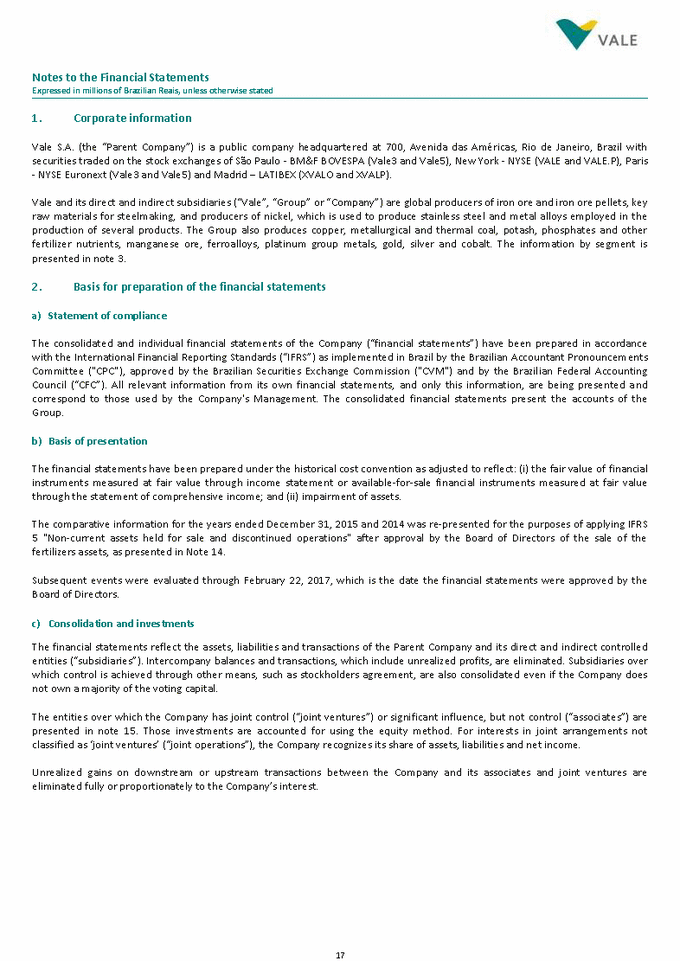
The material consolidated entities in each business segment of are as follows: Direct and indirect subsidiaries Mineração Corumbaense Reunida S.A. Brazil Iron ore and manganese 100.0% 100.0% 0.0% Salobo Metais S.A. Brazil Copper 100.0% 100.0% 0.0% PT Vale Indonesia Indonesia Nickel 59.2% 59.2% 40.8% Vale Canada Limited Canada Nickel 100.0% 100.0% 0.0% Vale Malaysia Minerals Sdn. Bhd. Malaysia Iron ore 100.0% 100.0% 0.0% Vale Moçambique S.A. Mozambique Coal 95.0% 95.0% 5.0% Vale Oman Distribution Center LLC Oman Iron ore and pelletizing 100.0% 100.0% 0.0% Investments held by investors in Vale’s subsidiaries are classified as noncontrolling interests. The Company treats transacti ons with noncontrolling interests as transactions with equity owners of the Group and as described in note 16. For purchases of noncontrolling interests, the difference between any amount paid and the portion acquired of the carrying va lue of net assets of the subsidiary is recorded in stockholders’ equity. Gains or losses on disposals of noncontrolling interest are also recorded in stockholders’ equity. As explained in note 14, the Fertilizer Segment is presented as discontinued operations, which includes the following subsidiaries: % Noncontrolling interest or other investors Location Principal activity % ownership % Voting capital Compañia Minera Miski Mayo S.A.C. Peru Fertilizers 40.0% 51.0% 60.0% d) Functional currency and presentation currency The financial statements of the Group and its associates and joint ventures are measured using the currency of the primary economic environment in which the entity operates (“functional currency”), which in the case of the Parent Company is the Brazilian real (“BRL” or “R$”). For presentation purposes, these financial statements are presented in Brazilian Reais. Operations in other currencies are translated into the functional currency using the actual exchange rates in force on the respective transactions dates. The foreign exchange gains and losses resulting from the translation at the exchange rates in force at th e end of the year are recognized in the income statement as financial expense or income. The exceptions are transaction s for which gains and losses are recognized in the statement of comprehensive income. The income statement and balance sheet of the Group’s entities which functional currency is different from the presentation currency are translated into the presentation currency as follows: (i) assets, liabilities and stockholders’ equity (except components described in item (iii) are translated at the closing rate at the balance sheet date; (ii) income and expenses are translated at the average exchange rates, except for specific transactions that, considering their significance, are translated at the rate at the transaction date and; (iii) capital, capital reserves and treasury stock are translated at the rate at the date of each trans action. All resulting exchange differences are recognized in the comprehensive income as cumulative translation adjustment, and transferred to the income statement when the operations are realized. The exchange rates used by the Group for major currencies to translate its operations are as follows: Closing rate Average rate for the year ended US dollar ("US$") 3.2591 3.9048 2.6562 3.4833 3.3387 2.3547 Australian dollar ("AUD") 2.3560 2.8532 2.1765 2.5876 2.4979 2.1205 18 3.1205 3.6999 3.8543 3.2270 4.2504 3.4384 Euro ("EUR" or "€") 2.1308 2.6020 2.6280 2.2920 2.8171 2.4258 Canadian dollar ("CAD") 2016 2015 2014 2016 2015 2014 0.0% 100.0% 100.0% Fertilizers Brazil Vale Fertilizantes S.A. Direct and indirect subsidiaries 30.0% 70.0% 70.0% Pelletizing Oman Vale Oman Pelletizing Company LLC 5.0% 95.0% 95.0% Nickel New Caledonia Vale Nouvelle Caledonie S.A.S. 0.0% 100.0% 100.0% Manganese and ferroalloys Brazil Vale Manganês S.A. 0.0% 100.0% 100.0% Trading and holding Switzerland Vale International S.A. 0.0% 100.0% 100.0% Holding and research Austria Vale International Holdings GmbH 0.0% 100.0% 100.0% Coal Netherlands Nacala Corridor Holding Netherlands B.V. 37.5% 98.3% 62.5% Iron ore Brazil Minerações Brasileiras Reunidas S.A. (“MBR”) 0.0% 100.0% 100.0% Iron ore Brazil Companhia Portuária da Baía de Sepetiba % Noncontrolling interest or other investors Location Principal activity/Business % ownership % Voting capital

e) Significant accounting policies The accounting policies applied in financial statements are consistent with those adopted and disclosed in the financial statements of prior years. The Company has not early adopted any standards and interpretations that have been issued or amended but which are not yet in force. The accounting policies of subsidiaries, affiliates and joint ventures are adjusted to ensure consistency with the policies adopted by Vale. Significant and relevant accounting policies for the understanding of the financial statements were included in the respectiv e notes, with a summary of the recognition and measurement basis used by the Company. The brief description of the recent accounting pronouncements issued by the IASB, which are not yet in force, and the current assessment did by the Company of the impacts on its financial statements, subject to changes due to the more analyzes in progres s, are detailed below: – IFRS 9 Financial instrument – In July 2014, the IASB issued the final version of IFRS 9 Financial Instruments that replaces IAS 39 Financial Instruments: Recognition and Measurement. This standard brings new approaches about: (i) classification and measurement of financial assets and liabilities, (ii) impairment and (iii) hedge accounting. This standard shall apply for annual periods beginning on or after January 1, 2018. The Company does not plan the early adoption of this new standard. Based on the history of financial instruments traded by the Company, it is not expected significant impacts on financial statements by applying the IFRS 9 requirements. – IFRS 15 Revenue from Contracts with Customers – In May 2014, the IASB issued IFRS 15, which replaces IAS 18 Revenues and the related interpretations. IFRS 15 introduces the five-step model for revenue recognition from contract with a customer. The new standard is based on the principle that revenue is recognized when the control of a good or service to be transferred to a customer in an amount that reflects the consideration to which the entity expects to be entitled in exchange for those goods or servic es. This standard shall apply for annual periods beginning on or after January 1, 2018. The Company plans to adopt the new standard on the required effective date using the full retrospective method with the pract ical expedients approach for concluded contracts. During 2016, the Company performed a preliminary assessment of IFRS 1 5, which is subject to changes arising from a more detailed analysis of the contracts that are in process. Based on these preliminary ana lyzes, management is evaluating whether the freight service should be considered a separate performance obligation or n ot. The Company expects to disclose quantitative information, if any, prior to the adoption of the standard. – IFRS 16 Lease – In January 2016, the IASB issued IFRS 16, which replaces IAS 17 Leases and related interpretations. The IFRS 16 set forth that in all leases with a maturity of more than 12 months, with limited exceptions, the lessee must recognize the lease liability in the balance sheet at the present value of the payments, plus costs directly allocated and at the same time that it recogni zes a right of use corresponding to the asset. During the term of the lease, the lease liability is adjusted to reflect interest an d payment made and the right to use is amortized, similar to the financial lease settled up in accordance with IAS 17. This standar d shall apply for annual periods beginning on or after January 1, 2019. The Company has not yet quantified the impact of adopting IFRS 16 on its assets and liabilities. The quantitative effect of t he adoption of IFRS 16 will depend specifically on the Company´s decision related to the method of transition, the use of practical expedients approach and exemptions for recognition, and any additional leases that Company will hold. The Company expects to disclose its transition approach and quantitative information prior to adoption, planned for January 1, 2019. – IAS 7 Amendments (Disclosure Initiative) – The amendments to IAS 7 Statement of Cash Flows are part of the IASB’s Disclosure Initiative and require an entity to provide disclosures that enable users of financial statements to evaluate cash flows and non-cash changes in liabilities arising from financing activities. On initial application of the amendment, entities are not required to provide comparative information for preceding periods. These amendments are effective for annual periods beginning on or after 1 Janu ary 2017, with early application permitted. Application of the amendments will result in additional disclosures provided by the Group. The Company did not early adopt this amendment. 19
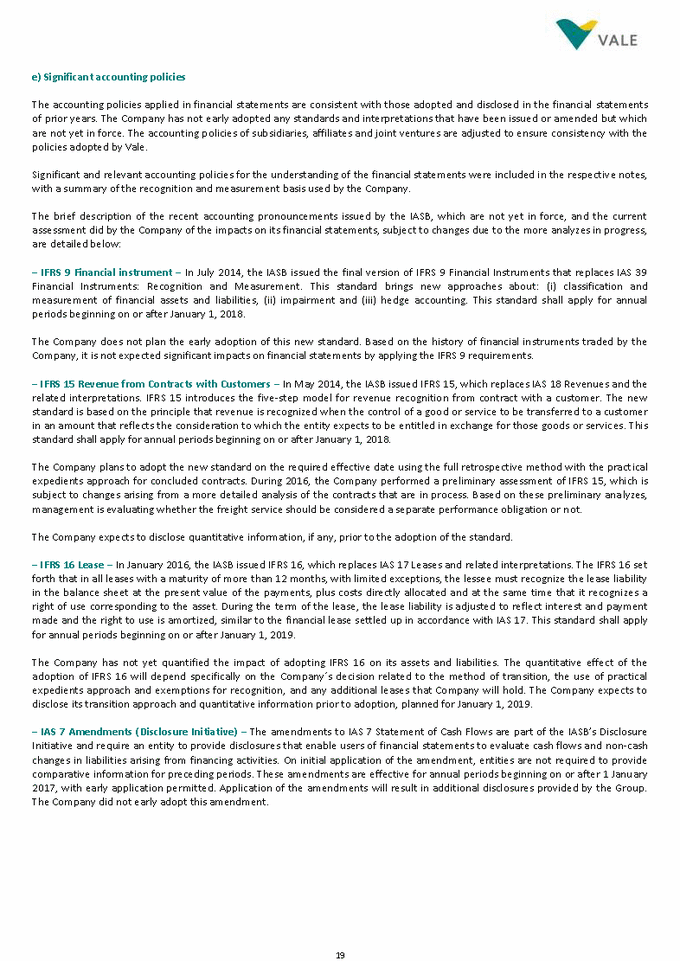
f) Critical accounting estimates and judgments The preparation of financial statements requires the use of certain critical accounting estimates, assumptions and judgments by the management of the Company. These estimates are based on the best knowledge and information existing at the balance sheet date . Changes in facts and circumstances may lead to the revision of these estimates. Actual future results may differ from the estimates. The significant estimates, assumptions and judgments used by Company in these financial statements are as follows: 3(c) Consolidation 8 Deferred income taxes 19 Impairment of non-current assets 24 Fair values of derivatives and others financial instruments 28 Litigation 3. Information by business segment and by geographic area The Company divided its operations into five reportable segments: Ferrous Minerals, Coal, Base Metals, Fertilizers (presented as discontinued operations) and Others. The segments are aligned with products and reflect the structure used by Management to evaluate group performance. The responsible bodies for making operational decisions, allocating resources and evaluating performance include the Executive Boards and the Board of Directors, which use adjusted EBITDA as a measure of performance. The information presented to the Executive Board on the performance of each segment is derived from the accounting records, adjusted for reallocations between segments. The main activities of the operating segments are as follows: Ferrous minerals - Ferrous minerals comprises the production and extraction of ferrous minerals, as iron ore fines, iron ore pellets and its logistic services (railroads, ports and terminals), manganese and ferroalloys and others ferrous products and services. Coal - Coal comprises the extraction of metallurgical and thermal coal and its logistic services (railroads, ports and terminals). Base metals - Base metals include the production and extraction of non-ferrous minerals, and are presented as nickel and its by-products (ferro-nickel, copper, gold, precious metals and others) and copper (copper concentrated). Fertilizers (Discontinued operations) - Fertilizers include the production of the three major groups of nutrients (potash, phosphate and nitrogen) and other fertilizers products. The group of assets related to this segment is classified as "Non-current assets and liabilities held for sale" (note 14). Others - The segments of others comprise sales and expenses of other products, services and investments in joint ventures and associate in other business. 20 29Post-retirement benefits for employees 27Asset retirement obligation 21Liabilities related to associates and joint ventures 18Mineral reserves and mine useful life 7Deferred revenue - Gold stream NoteSignificant estimates, assumptions and judgments
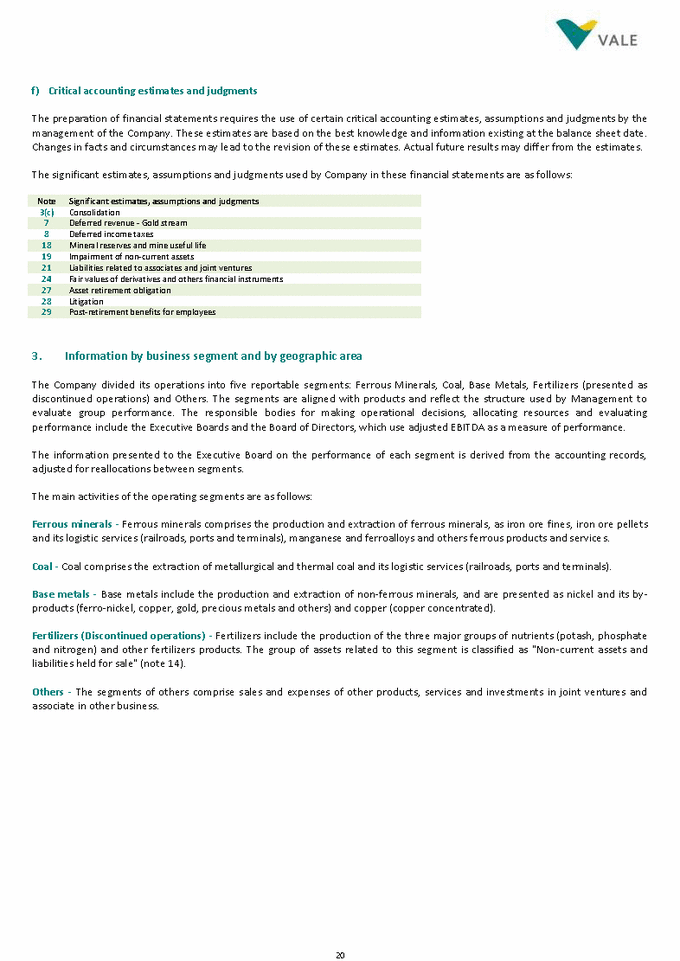
a) Adjusted EBITDA The definition of adjusted EBITDA for the Company is the operating income or loss excluding (i) the depreciation, depletion a nd amortization, (ii) results on measurement or sales of non-current assets, (iii) impairment, (iv) onerous contracts and plus (v) dividends received from associates and joint ventures. Year ended December 31, 2016 Sales, administrative and other operating expenses Dividends received from associates and joint ventures Net operating revenue Cost of goods sold and services rendered Research and evaluation expenses Pre operating and operational stoppage Adjusted EBITDA Iron ore 54,187 (22,817) (1,712) (308) (521) 35 28,864 Ferroalloys and manganese 1,031 (793) (11) (1) (39) - 187 1,513 (26) (12) 537 69,929 (31,475) (2,000) (359) (649) 394 35,840 Coal 2,882 (3,090) 150 (50) (137) - (245) Base metals Copper 5,770 (3,198) (82) (17) - - 2,473 - 480 - 480 21,274 (14,343) 67 (285) (399) 13 6,327 548 (529) (4) (1,016) Total of continuing operations 94,633 (49,797) (2,312) (1,098) (1,189) 669 40,906 Discontinued operations (Fertilizers) 6,470 (5,315) (298) (75) (58) 12 736 21 Total 101,103 (55,112) (2,610) (1,173) (1,247) 681 41,642 262 (404) (889) Others - - - Other base metals products 3,374 13 (399) (268) (331) (11,145) 15,504 Nickel and other products - (5) (933) Other ferrous products and services 6,252 359 (77) (45) (251) (6,932) 13,198 Pellets Ferrous minerals
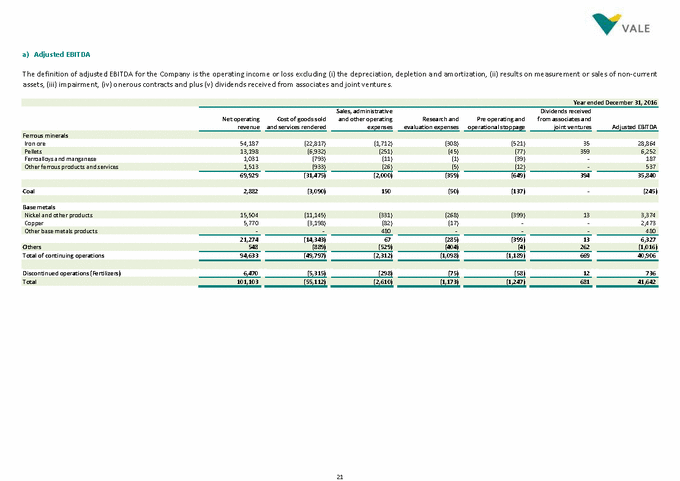
Year ended December 31, 2015 Ferrous minerals Pellets 11,916 (7,008) 34 (13) (81) 708 5,556 Other ferrous products and services 1,552 (1,115) 22 (9) (6) 25 469 Nickel and other products 15,534 (11,378) (506) (348) (1,359) - 1,943 Other base metals products - - 722 - - - 722 414 (543) (2) (916) Total of continuing operations 78,057 (51,959) (1,959) (1,326) (2,136) 1,064 21,741 Discontinued operations (Fertilizers) 7,442 (4,896) (124) (277) (232) - 1,913 Year ended December 31, 2014 Sales, administrative and other operating expenses Dividends received from associates and joint ventures Net operating revenue Cost of goods sold and services rendered Research and evaluation expenses Pre operating and operational stoppage Adjusted EBITDA Iron ore 45,341 (22,515) (3,037) (758) (376) 108 18,763 Ferroalloys and manganese 933 (618) (27) (1) (54) - 233 1,724 7 - 401 60,395 (30,840) (3,099) (782) (518) 1,206 26,362 Coal 1,740 (2,514) (764) (43) (89) 75 (1,595) Base metals Copper 3,434 (2,079) (35) (10) (38) - 1,272 2,347 (759) (403) (14) 21 (216) Total of continuing operations 82,619 (45,597) (4,408) (1,568) (1,868) 1,302 30,480 Discontinued operations (Fertilizers) 5,656 (4,406) (226) (170) (200) - 654 Total 88,275 (50,003) (4,634) (1,738) (2,068) 1,302 31,134 22 (1,408) Others 18,137(10,835)214(340)(1,247)-5,929 4,657 - (1,209) (330) 249 (8,756) 14,703 Nickel and other products 1 (21) (1,310) Other ferrous products and services 6,965 1,097 (88) (2) (42) (6,397) 12,397 Pellets Ferrous minerals Total 85,499 (56,855) (2,083) (1,603) (2,368) 1,064 23,654 135 (456) (464) Others 20,491(14,427)102(379)(1,361)-4,426 1,761 - (2) (31) (114) (3,049) 4,957 Copper Base metals (1,725) 109 (208) (73) (435) (2,857) 1,739 Coal 55,413(34,211)(1,083)(418)(565)82019,956 (126) - (61) (1) 1 (583) 518 Ferroalloys and manganese 14,057 87 (417) (395) (1,140) (25,505) 41,427 Iron ore Sales, administrative and other operating expenses Dividends received from associates and joint ventures Net operating revenue Cost of goods sold and services rendered Research and evaluation expenses Pre operating and operational stoppage Adjusted EBITDA
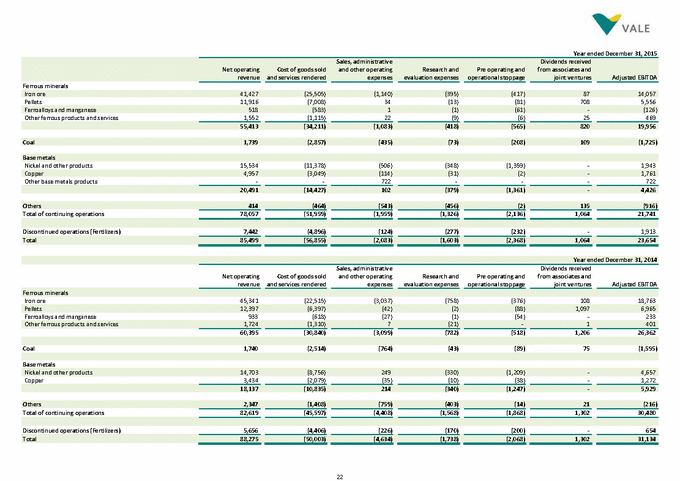
Adjusted EBITDA is reconciled to net income (loss) as follows: Year ended December 31 Adjusted EBITDA from continuing operations 40,906 21,741 30,480 Dividends received from associates and joint ventures (669) (1,064) (1,302) Impairment of non-current assets and onerous contracts (3,940) (33,945) 87 Equity results in associates and joint ventures 1,111 (1,526) 1,131 Income taxes (9,567) 19,339 (3,658) Loss attributable to noncontrolling interests (6) (1,815) (749) Year ended December 31 Adjusted EBITDA from discontinued operations 736 1,913 654 Dividends received from associates and joint ventures (12) - - (5,899) (2,800) Operating income (loss) (6,372) 266 (3,126) Financial results, net 69 (485) (127) Income taxes 2,134 (460) 1,058 Income (loss) attributable to noncontrolling interests (9) 31 14 b) Assets by segment Year ended December 31, 2016 Coal 412 929 6,216 2,136 652 Others 7 5,183 7,096 150 71 Additions to property, plant and equipment and intangible (ii) Property, plant and equipment and intangible assets (i) Depreciation, depletion and amortization (iii) Product inventory Investments Ferrous minerals 4,044 5,775 110,123 16,399 5,562 Base metals 4,552 66 91,849 5,162 6,161 Discontinued operations (Fertilizers) 1,156 292 15,096 853 1,039 (i) Goodwill is allocated mainly in iron ore and nickel segments in the amount of R$4,060 e R$5,981, respectively. (ii) Includes only cash effect. (iii) Refers to amounts recognized in the income statement. 23 Total 9,968 11,481 232,048 27,784 13,489 57 262 7,905 4,153 10 Others 670 5,108 7,075 1,195 206 Coal Year ended December 31, 2015 Total 7,733 12,046 203,011 17,343 12,107 5,791 3,673 76,173 40 3,617 Base metals 5,593 11,384 113,526 5,894 3,697 Ferrous minerals Additions to property, plant and equipment and intangible (ii) Property, plant and equipment and intangible assets (i) Depreciation, depletion and amortization (iii) Product inventory Investments Loss attributable to Vale's stockholders (4,150) (691) (2,199) Loss from discontinued operations (4,159)(660)(2,185) 10 19 10 Equity results in associates and joint ventures (608) Results on measurement or sale of non-current assets Depreciation, depletion and amortization (1,197)(1,039)(980) 2016 2015 2014 Income (loss) attributable to Vale's stockholders 17,461 (43,522) 3,153 Income (loss) from continuing operations 17,455(45,337)2,404 (139) (1,431) (4,353) Impairment and others results in associates and joint ventures (14,626) (36,053) 6,302 Financial results, net Operating income (loss) 23,962(25,666)19,696 (441) 52 (228) Results on measurement or sale of non-current assets Depreciation, depletion and amortization (12,107) (12,450) (9,128) 2016 2015 2014
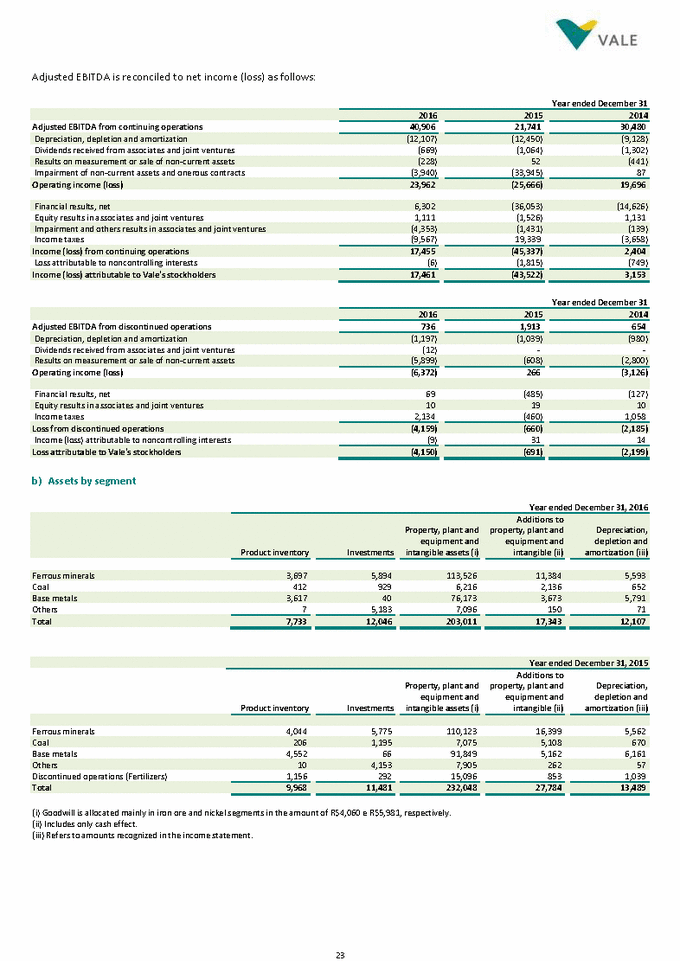
c) Investment, intangible and property, plant and equipment by geographic area Property, plant and equipment Property, plant and equipment Investments Intangible Total Investments Intangible Total Canada - 6,524 33,460 39,984 8 7,964 41,346 49,318 Europe - - 2,084 2,084 - - 2,375 2,375 Australia - - 139 139 - - 290 290 Mozambique - 484 5,589 6,073 - - 1,727 1,727 Other regions - - - - 24 - - 24 d) Revenues by geographic area Year ended December 31, 2016 United States of America 792 - 2,602 81 3,475 Middle East/Africa/Oceania 4,266 329 72 1 4,668 China 41,135 223 2,420 - 43,778 Brazil 6,154 51 491 407 7,103 Year ended December 31, 2015 United States of America 95 - 2,640 69 2,804 Middle East/Africa/Oceania 3,323 314 273 - 3,910 China 28,477 149 2,186 - 30,812 Brazil 5,457 75 683 345 6,560 Year ended December 31, 2014 United States of America 55 - 2,590 565 3,210 275 6,105 30 15,525 Middle East/Africa/Oceania 3,794 259 350 - 4,403 Japan 6,031 453 2,030 16 8,530 China 28,077 178 1,507 - 29,762 Asia, except Japan and China 5,170 550 1,934 1 7,655 Brazil 6,624 18 391 1,690 8,723 Net operating revenue 60,395 1,740 18,137 2,347 82,619 24 9,115 Europe 4,811 45 3,230 7 1,529 Americas, except United States and Brazil Ferrous minerals Coal Base metals Others Total Net operating revenue 55,413 1,739 20,491 414 78,057 7,423 - 3,325 553 3,545 Asia, except Japan and China 6,498 - 1,223 237 5,038 Japan 15,104 - 6,464 347 8,293 Europe 4,946 - 3,697 64 1,185 Americas, except United States and Brazil Ferrous minerals Coal Base metals Others Total Net operating revenue 69,929 2,882 21,274 548 94,633 8,230 - 4,053 1,052 3,125 Asia, except Japan and China 6,019 - 1,123 432 4,464 Japan 16,042 59 6,434 723 8,826 Europe 5,318 - 4,079 72 1,167 Americas, except United States and Brazil Ferrous minerals Coal Base metals Others Total Total 12,046 22,395 180,616 215,057 11,481 20,789 211,259 243,529 3,916 3,916 - - 3,117 3,117 - - Oman 13,749 13,749 - - 10,062 10,062 - - New Caledonia 21,811 20,378 - 1,433 14,703 13,599 - 1,104 Asia 2,394 1,781 - 613 702 98 - 604 Americas, except Brazil and Canada Brazil 10,338 15,387 112,468 138,193 9,403 12,825 125,697 147,925 December 31, 2016 December 31, 2015
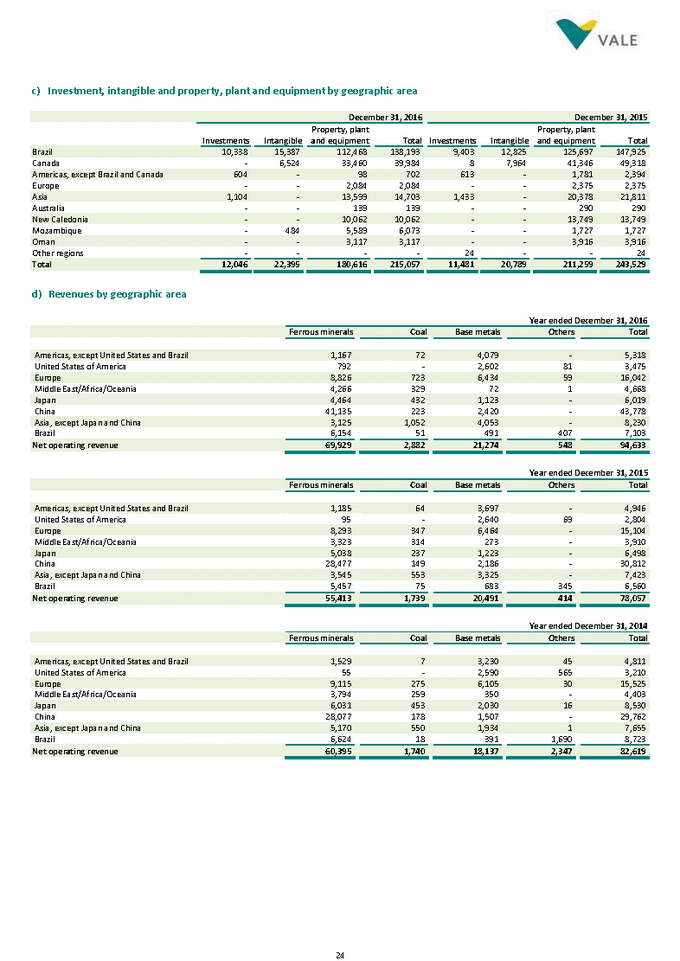
Accounting policy Revenue is recognized when Vale transfers to its customers all of the significant risks and rewards of ownership of the product sold or when the services are rendered. Net revenue excludes any applicable sales taxes and is recognized at the fair value of the consideration received or receivable to the extent that it is probable that economic benefits will flow to Vale and the revenues c an be reliably measured. Depending on the contract, sales can be recognized when the product is available at the loading port, loa ded on the ship, at the port of discharge or on the costumer warehouse. Service revenues are recognized in the amount by which the services are rendered a nd accepted by the customer. In some cases, the sale price is determined on a provisional basis at the date of sale and adjustments to the sales price subsequently occur based on movements in quoted market or contractual prices up to the date of final pricing. Revenue is recognized based on the estimated fair value of the total consideration receivable, and the provisionally priced sales mechanism embedded within these sale arrangements is characterized as a derivative. Therefore, the fair value of the final sales price adjustment is re-estimated continuously and changes in fair value are recognized as operational revenue in the income statement. As of December 31, 2016 , R$1,344 of revenues (2015: R$(1,070)) were still not settled and were provisionally measured based on iron ore fines and copper forward prices. Amounts billed to customers for shipping related to products sold by the Company are recognized as revenue when the Company is responsible for shipping. Shipping costs are recognized as operating costs. 4. Special events occurred during the year The special events occurred during the year are those that, in the Company’s judgment, significantly impacted the income statement due to their size and nature. To determine whether an event or transaction is non -recurring, the Company considers quantitative and qualitative factors, such as frequency and impact on the result of the year. The special events identified by the Company are as follows: Consolidated Parent Company Samarco Provision (3,967) - - - - Impairment of non-current assets and onerous contracts (3,940) (33,945) 87 205 270 Deferred income tax in foreign jurisdiction - 11,729 - - - 2016 Samarco – In June 2016, the Company recognized in the income statement the amount of R$3,733 which represented its best estimate of the obligation to comply with the reparation and compensation programs under the Agreement related to the dam failure of Samarco Mineração S.A. The Company also expensed an amount of R$234 applied by Samarco to funds its working capital requirements. For more details, see note 21. Fertilizers assets - In December 2016, the Company approved the sale of fertilizers assets and the acquisition of a minority interest in The Mosaic Company (“Mosaic”). Vale assessed the net assets of the fertilizer business segment for impairment purposes and a loss in the amount of R$5,899 was recognized. The fertilizers segment is presented as discontinued operations see note 14. Impairment of non-current assets and onerous contracts – In 2016, the Company recognized an impairment loss of R$3,940 mainly by the reduction in the nickel price projections, see note 19. Gold stream transaction – In 2016, the Company recognized a gain of the result on sale of mineral rights in the amount of R$480, see note 7. 25 Total (13,326)(21,494)87205270 - - - 722 480 Gold stream transaction - - - - (5,899) Results on measurement of non-current assets - Fertilizers business 2016 2015 2014 2016 2015 Year ended December 31
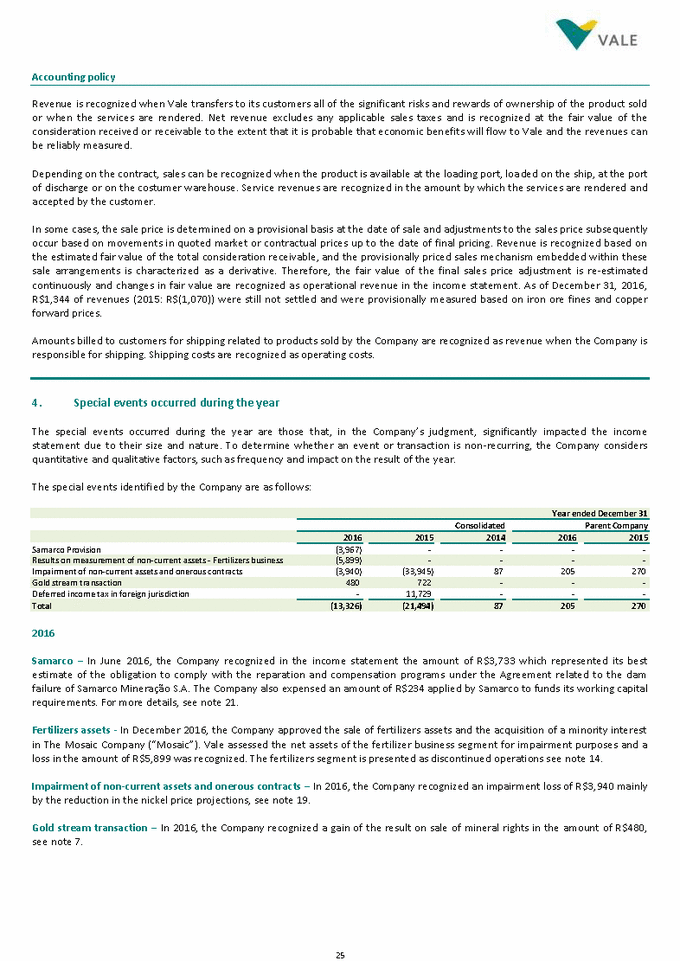
2015 Impairment of non-current assets and onerous contracts – In 2015, the Company recognized an impairment loss of R$33,945 mainly by: (i) the reduction in estimated future coal prices combined with the increase of logistics costs and (ii) the reduction the recoverable values of the VNL and VNC CGUs, see note 19. Gold stream transaction – In 2015, the Company recognized a gain of the result on sale of mineral rights in the amount of R$722, see note 7. Deferred income tax - In 2015, in the first adoption of the Law 12.973, the Company recognized assets deferred income tax related to accumulated losses of subsidiaries abroad in the amount of R$11,729, see note 8. 5. Costs and expenses by nature a) Cost of goods sold and services rendered Consolidated Parent Company Materials and services 10,808 9,827 10,246 5,438 5,619 Maintenance 9,487 8,520 5,464 6,068 5,397 Acquisition of products 1,762 2,531 3,780 821 684 Freight 8,641 11,877 8,514 71 - Total 61,143 62,780 53,773 29,663 27,522 Cost of goods sold 59,409 61,072 51,579 28,601 26,467 Total of continuing operations 61,143 62,780 53,773 29,663 27,522 Discontinued operations (Fertilizers) 6,495 5,878 5,314 - - b) Selling and administrative expenses Year ended December 31 2016 2015 2014 2016 2015 Services 248 354 441 148 194 Depreciation and amortization 414 437 514 300 321 Taxes and rents 46 52 66 18 22 Total of continuing operations 1,755 2,009 2,452 1,021 1,141 Discontinued operations (Fertilizers) 195 134 151 - - 26 Total 1,950 2,143 2,603 1,021 1,141 46 44 299 270 265 Others 19 17 55 36 29 Travel expenses 30 21 96 38 26 Advertising and publicity Personnel 727 822 981 473 509 Consolidated Parent Company Total 67,638 68,658 59,087 29,663 27,522 1,055 1,062 2,194 1,708 1,734 Cost of services rendered 4,562 5,270 6,415 6,535 5,191 Others 4,147 4,808 8,176 10,821 11,346 Depreciation and depletion 926 1,028 1,170 1,602 2,406 Energy 2,590 2,714 3,426 4,037 4,280 Fuel oil and gas 3,597 3,445 6,582 7,030 7,222 Personnel 2016 2015 2014 2016 2015 Year ended December 31
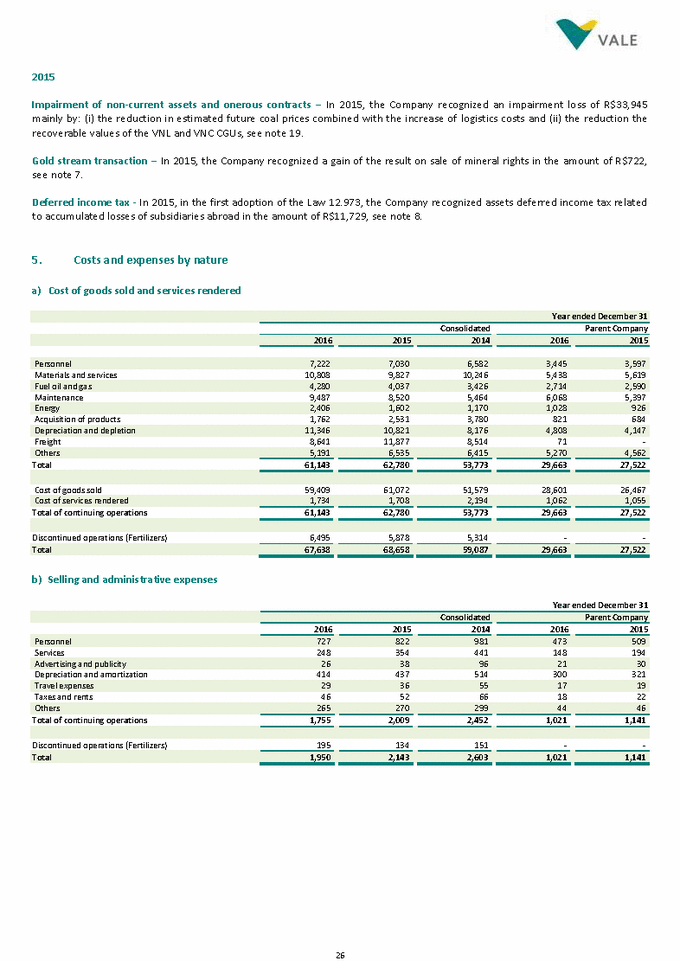
c) Others operational expenses (incomes), net Consolidated Parent Company Provision for litigation 487 46 406 524 (53) Profit sharing program 252 52 278 137 41 Gold stream transaction (note 7) (480) (722) - - - Total of continuing operations 937 588 2,477 1,166 (72) Discontinued operations (Fertilizers) 113 (2) 83 - - 6. Financial result Year ended December 31 Financial expenses 2016 2015 2014 2016 2015 Capitalized loans and borrowing costs 2,291 2,531 1,387 1,679 1,258 (21) Derivative financial instruments (1,655) (11,969) (4,885) (957) (7,471) (9,612) Participative stockholders' debentures (1,456) 3,039 (665) (1,456) 3,039 (1,751) Others (2,146) (1,785) (1,576) (1,452) (697) Financial income 209 Derivative financial instruments 5,827 3,885 1,461 4,290 2,994 21,021 Others 270 354 486 136 107 Financial results, net 6,302 (36,053) (14,626) 5,756 (31,128) Summary of indexation and exchange rate variation 17,715 Others (7,066) 9,516 2,751 (6,306) 10,256 As from January 1, 2017 (subsequent event), the Company starts to apply net investment hedge accounting in foreign operation considering Vale International S.A. and Vale International Holding GmbH investments as the hedging objects and designated as hedging instruments the Parent Company third party loans and borrowings (excluding interest) in different currencies denominated in US dollar and euro, amounting to US$8,067 (R$26,291) and EUR1,500 (R$5,159) as the hedging instrument, respectively. Accordingly, the Company plans to mitigate part of its foreign exchange risk, since foreign exchange gains or losses on the h edging instrument (effective portion) will be recognized in other comprehensive income, thus offsetting same of the gains and losses generated from translating of the net investments in the aforementioned controlled companies. If the hedge relationship is no t considered effective, the hedging instrument’s exchange variations will be allocated to income statement for the year . 27 Net (a) + (b) 10,819 (25,109) (5,377) 11,409 (23,454) (33,710) (8,128) (34,625) 17,885 Loans and borrowings 27,657 25,968 8,514 25,656 25,822 22,445 6,144 21,237 21,224 Indexation and exchange rate variation (b) 276 423 492 336 Short-term investments (21,355) (62,021) (23,140) (19,900) (56,950) (1,758) (1,603) (1,795) (1,787) Expenses of REFIS (45,899) (11,521) (46,346) (10,405) Indexation and exchange rate variation (a) (127) (218) (193) (45) Labor, tax and civil lawsuits Loans and borrowings gross interest (6,152) (5,503) (4,059) (6,330) (5,295) Consolidated Parent Company Total 1,050 586 2,560 1,166 (72) (901) 418 982 (17) 884 Others 74 (56) 476 501 (349) Disposal of materials and inventories 767 143 335 728 143 Provision for loss with VAT credits (ICMS) 2016 2015 2014 2016 2015 Year ended December 31
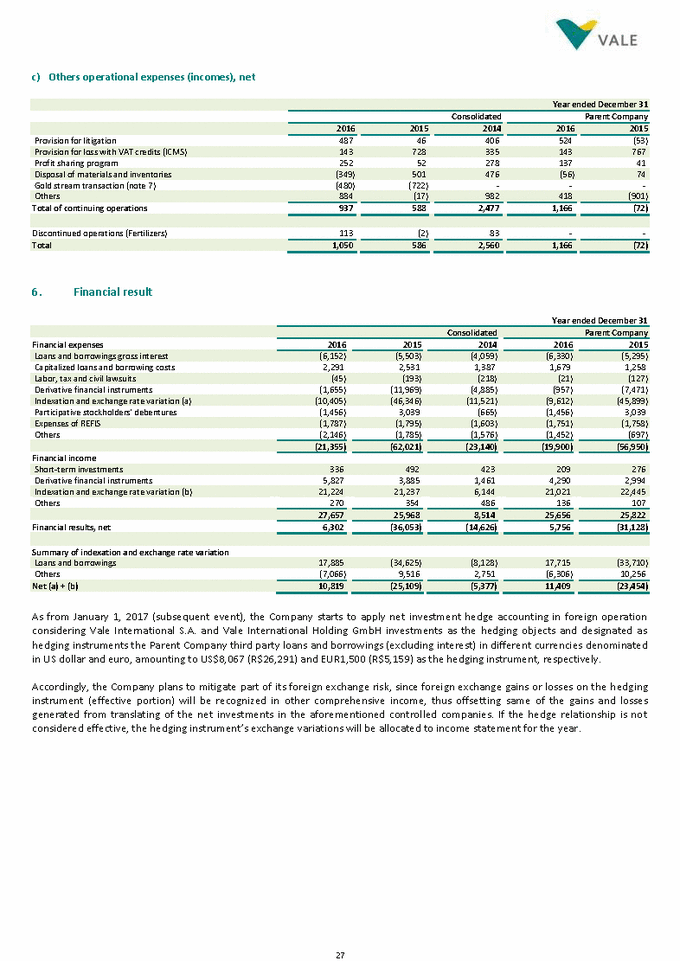
7. Deferred revenue - Gold stream transaction In 2013, the Company entered into a gold transaction with Silver Wheaton Corp. ("SLW") to sell 25% of the gold extracted as a by-product over the life of the Salobo copper mine and 70% of the gold extracted as a by-product of Sudbury nickel mines over the next 17 years. The Company received up-front cash proceeds of R$4,060 (US$1,900). The original transaction was amended in March 2015 and August 2016 to include in each contract an additional 25% of the gold extracted as by-product over a lifetime of the Salobo copper mine. In the first additive, the Company received up -front proceeds of R$2,826 (US$900) and in the second additive, (i) an initial cash payment of R$2,568 (US$800) and (ii) an option value resulting from the reduction of the exercise price from R$211.00 (US$65.00) to R$142.00 (US$43.75) on 10 million warrants from SLW held by the Company since 2013 and maturing in 2023. Hence, in December 31, 2016 SLW holds the rights to 75% of the contained gold in the copper concentrated from the Salobo mine and 70% of the gold extracted as a by-product of the Sudbury nickel mines. As the gold is delivered to SLW, Vale receives payment equal to the lesser of: (i) US$400 per ounce of refined gold delivered (which payments are subject to an annual increase of 1% per year commencing on January 1, 2017 for the original and additional transactions and each subsequent year and (ii) the market reference price on the delivery date. Vale may also receive an additional cash payment contingent on its decision to expand its capacity to process Salobo copper o res to more than 28 Mtpy before 2036. Salobo, that were still in ramp-up until September, 2016, and will have a total capacity to process 24 Mtpy of run-of-mine (ROM). The contingent additional cash payment could range from US$113 to US$953 depending on ore grade, timing and size of the expansion. The transactions were bifurcated into two identifiable components (i) the sale of the mineral rights and, (ii) the services for gold extraction on the portion in which Vale operates as an agent for SLW gold extraction. The deferred revenue is recognized based on the units of gold mined compared to the total p roven and probable reserves of gold traded with SLW. During the year ended December 31, 2016, 2015 and 2014, the Company recognized R$717, R$361 and R$151, respectively, in the statement of income relating to services rendered in the original and additional transactions. The result on sale of mineral rights from the additional transactions of R$480 and R$722 was recognized in the year ended December 31, 2016 and 2015, respectively, under "Other operating expenses, net". Critical accounting estimates and judgments Defining the gain on sale of mineral interest and the deferred revenue portion of the transaction requires the use of critical accounting estimates as follows: - Discount rates used to measure the present value of future inflows and outflows; - Allocation of costs between nickel or copper and gold based on relative prices; - Expected margin for the independent elements (sale of mineral rights and service for gold extraction) based on Company’s best estimate. 28
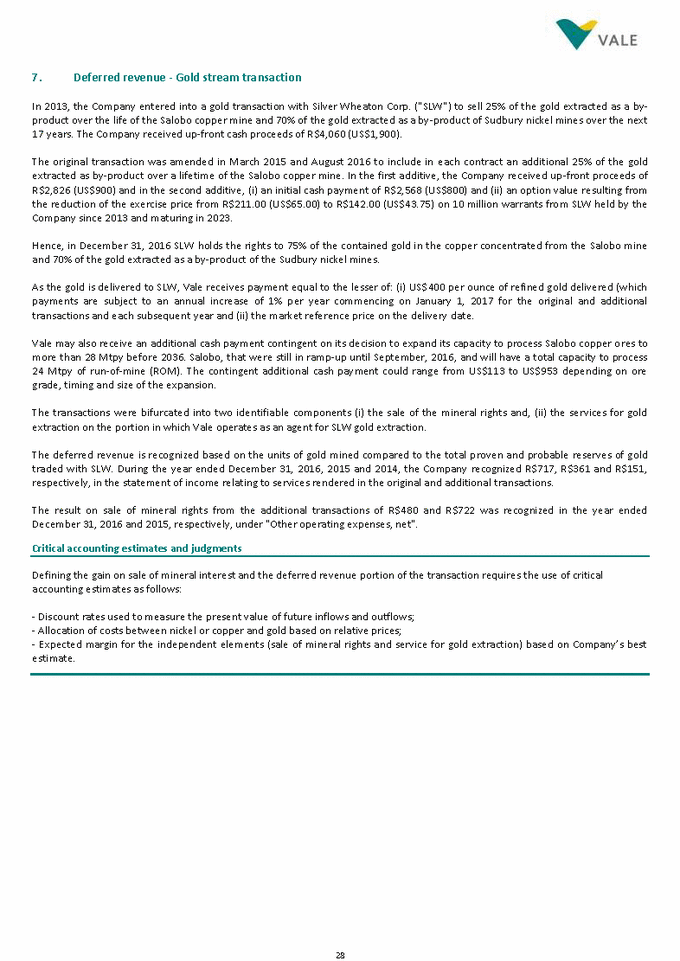
8. Income taxes a) Deferred income tax assets and liabilities December 31, 2016 December 31, 2015 December 31, 2016 December 31, 2015 Taxes losses carryforward 20,188 25,171 10,310 12,294 Employee post retirement obligations 2,022 2,291 483 365 Provision for assets losses 4,119 2,701 3,264 1,479 Allocated goodwill (7,325) (8,871) - - (1,797) (824) 4,989 4,998 Liabilities (5,540) (6,520) - - Changes in deferred tax are as follows: Assets Liabilities Total Assets Taxes losses carryforward 16,800 (141) 16,941 11,919 Fair value of financial instruments (398) - (398) 156 Others (584) 93 (677) (1,226) Transfers between asset and liabilities 548 548 - - Other comprehensive income 3,522 49 3,473 46 Effect of discontinued operations Balance at December 31, 2015 30,867 6,520 24,347 17,292 Provision for assets losses 1,182 157 1,025 1,785 Allocated goodwill - (1,206) 1,206 - Effect in income statement (6,925) (665) (6,260) (2,048) Translation adjustment (1,876) (899) (977) - Effect of discontinued operations Transfer to net assets held for sale (687) - (687) - Law 12.973 - The Brazilian corporate tax law was amended at the end of 2014 and became effective as from fiscal year 2015. The change provided that profits from foreign subsidiaries are taxable in Brazil, on an accrual basis, applying the differential between the nominal local tax rate and the Brazilian tax rates (34%) considering the profit before tax in local GAAP (Generally Accepted Accounting Principles) and local currency. Accordingly, from January 1st, 2015 the results from foreign subsidiaries are recognized on that basis. In accordance with article 77 of law 12.973, the losses generated by the foreign subsidiaries, before income taxes and the equity results, may be offset against their future profits, subject to certain conditions. In 2015, in the first adoption, the Company recognized deferred income tax assets related to accumulated losses of subsidiari es abroad in the amount of R$11,729. The Company projections shows deferred tax assets substantially being realized in the next five years. The tax loss carryforward do not expire and in the Brazilian jurisdiction the compensation is limited to 30% of the taxable income for the year. For local results there is no restriction to compensated profits from foreign subsidiaries against previously recorded deferred tax assets. 29 Balance at December 31, 2016 23,931 5,540 18,391 15,299 - 2,127 - 2,127 Income tax 55 (159) 38 (121) Other comprehensive income - - 546 546 Transfers between asset and liabilities (556) (969) 89 (880) Others (1,294) (2,722) - (2,722) Fair value of financial instruments Taxes losses carryforward (4,505) 295 (4,800) (1,983) - (261) - (261) Income tax - (31) - (31) Acquisition of subsidiary - (1,007) 2,049 1,042 Translation adjustment Effect in income statement 15,487 (5,000) 20,487 10,816 - 4,853 (4,853) - Allocated goodwill (33) (232) (99) (331) Provision for assets losses Balance at December 31, 2014 10,560 8,874 1,686 6,430 Parent Company Consolidated 18,391 24,347 15,299 17,292 17,292 15,299 30,867 23,931 Assets Total 18,391 24,347 15,299 17,292 (806) (1,340) (1,052) (1,861) Others 3,215 1,921 3,215 546 Fair value of financial instruments 745 661 892 702 Provision for litigation Temporary differences: Parent Company Consolidated
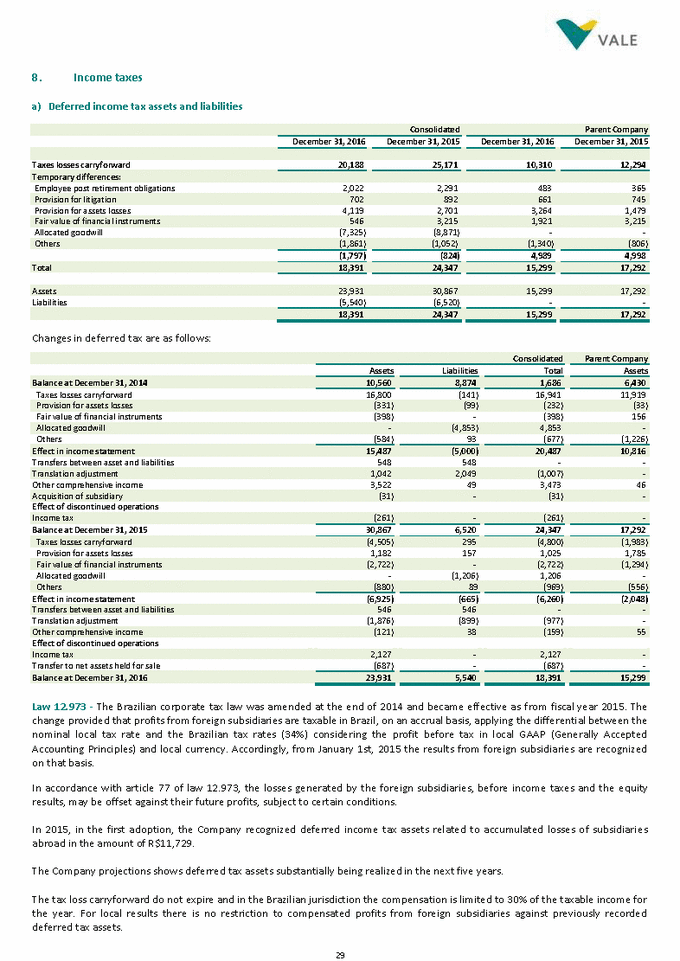
b) Income tax reconciliation – Income statement The total amount presented as income taxes in the income statement is reconciled to the rate established by law, as follows: Consolidated Parent Company Net income (loss) before income taxes 27,022 (64,676) 6,062 17,545 (55,047) Adjustments that affect the basis of taxes: Tax incentives 1,130 204 209 953 - Equity results 378 (518) 385 886 (12,713) Unrecognized tax losses of the year (2,465) (3,021) - - - Others 1,563 941 (469) 937 (853) c) Tax incentives In Brazil, Vale has tax incentives to partially reduce the income tax generated by the operations conducted in the North and Northeast regions which includes iron ore, copper, and nickel. The incentive is calculated based on the taxable income of the incentive activity (tax operating income) and takes into account the allocation of tax operating income into different incentives applicable to different tranches of production during the periods specified for each product, generally 10 years. Most of our incentives are expected to expire up to 2024. An amount equal to that obtained with the tax saving must be appropriated in retained earnings reserve account in stockholders’ equity, and cannot be distributed as dividends to stockholders. In addition to those incentives, 30% of the income tax due based on the tax operating income can be reinvested on the purchas e of machinery and equipment, subject to subsequent approval by the regulatory agency responsible, Superintendência do Desenvolvimento da Amazonia (SUDAM) and the Superintendência do Desenvolvimento do Nordeste (SUDENE). The reinvestment is accounted in retained earnings reserve account, which restricts the distribution as dividends to stockholders. Vale is subject to the revision of income tax by local tax authorities in a range up to 10 years depending on jurisdiction where we operate. d) Income taxes - Settlement program (“REFIS”) In 2013, the Company elected to participate in the REFIS, a federal tax settlement program, to settle most of the claims related to the collection of income tax and social contribution on equity gains of foreign subsidiaries and affiliates from 2003 to 2012. At December 31, 2016, the balance of R$17,662 (R$1,492 as current and R$16,170 as non-current) is due in 142 remaining monthly installments, bearing interest at the SELIC rate (Special System for Settlement and Custody) and at December 31, 2015, the balance of R$17,301 (R$1,348 as current and R$15,953 as non-current) was due in 154 remaining monthly installments. Accounting policy The recognition of income taxes as deferred taxes is based on temporary differences between carrying value and the tax basis of assets and liabilities as well as taxes losses carryforwards. The deferred income taxes assets and liabilities are offset when there is a legally enforceable right on the same taxable entity. The deferred taxes assets arising from taxes losses and temporary differences are not recognized when their recover y amount are not probable. Income taxes are recognized in the income statement, except for items recognized directly in stockholders’ equity. The provision for income tax is calculated individually for each entity in the Group based on Brazilian tax rates, on an accrual basis, by appl ying the differential between the nominal local tax rates (based on rules in force in the location of the entity) and the Brazilian tax rate. 30 Income taxes (9,567) 19,339 (3,658) (4,234) 10,834 - - (1,119) (7,222) (325) Nondeductible effect of impairment 4,651 (1,336) (410) 5,911 (952) Additions (reversals) of tax loss carryforward - - (2,827) - - Results of overseas companies taxed by different rates which differs from the parent company rate 1,033 291 2,634 1,054 291 Income tax benefit from interest on stockholders' equity 18,716 (5,965) (2,061) 21,990 (9,187) Income taxes at statutory rates - 34% 2016 2015 2014 2016 2015 Year ended December 31
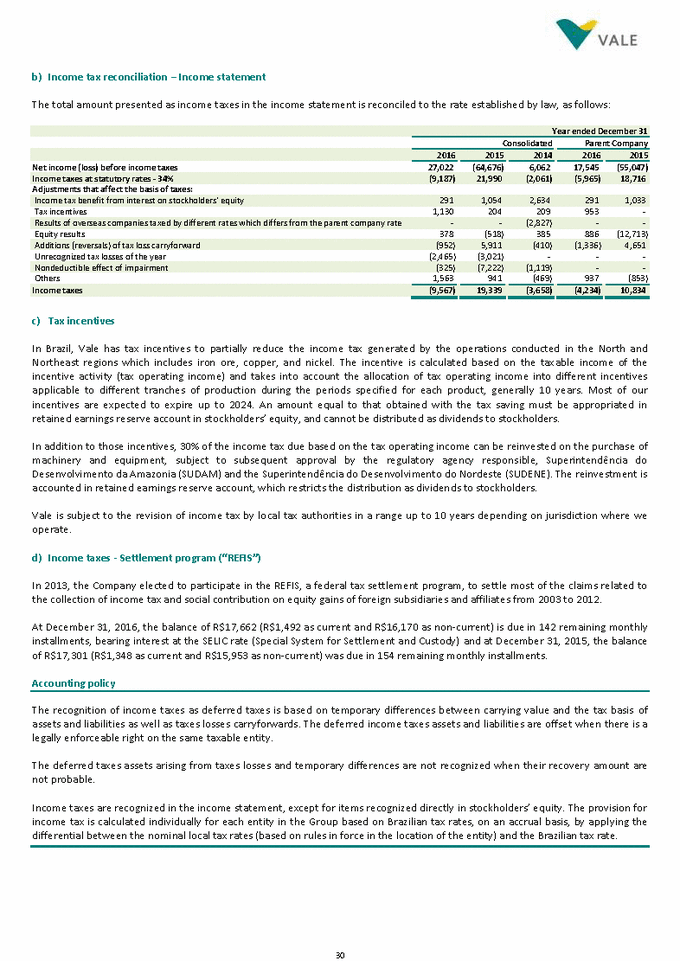
Critical accounting estimates and judgments Deferred tax assets arising from tax losses, negative social contribution basis and temporary differences are registered taking into account the analysis of future performance, considering economic and financial projections, prepared based on internal assumptions and macroeconomic, trade and tax scenarios that may be subject to changes in the future. The assumptions of future profits are based on production and sales planning, commodity prices, operational costs, restructuring plans, reclamation and planned capital costs. 9. Basic and diluted earnings (loss) per share The value of basic earnings (loss) per shares and diluted were calculated as follows: 2016 2015 2014 Income (loss) available to preferred stockholders 6,667 (16,618) 1,204 Total 17,461 (43,522) 3,153 Basic and diluted loss per share from discontinued operations: Loss available to common stockholders (2,565) (427) (1,359) Income (loss) available to preferred stockholders 5,082 (16,882) 364 Total 13,311 (44,213) 954 Thousands of shares Weighted average number of shares outstanding - common shares 3,185,653 3,185,653 3,185,653 Preferred share (R$) 3.39 (8.45) 0.61 Preferred share (R$) (0.81) (0.13) (0.43) Preferred share (R$) 2.58 (8.58) 0.19 The Company does not hold dilutive potential ordinary shares outstanding that could result in dilution of earnings per share. 31 0.19 (8.58) 2.58 Common share (R$) Basic and diluted earnings (loss) per share (0.43) (0.13) (0.81) Common share (R$) Basic and diluted loss per share from discontinued operations 0.61 (8.45) 3.39 Common share (R$) Basic and diluted earnings (loss) per share from continuing operations Total 5,153,375 5,153,375 5,153,375 1,967,722 1,967,722 1,967,722 Weighted average number of shares outstanding - preferred shares 590 (27,331) 8,229 Income (loss) available to common stockholders Basic and diluted earnings per share: Total (4,150) (691) (2,199) (840) (264) (1,585) Loss available to preferred stockholders 1,949 (26,904) 10,794 Income (loss) available to common stockholders Basic and diluted earnings (loss) per share from continuing operations: Year ended December 31
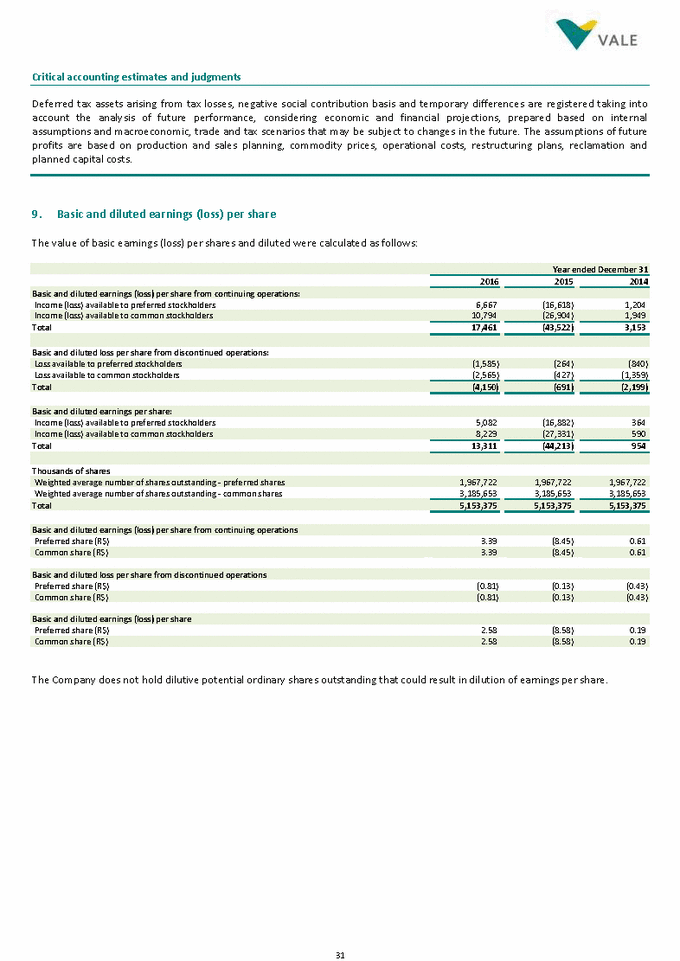
10. Accounts receivable Consolidated Parent Company Impairment of trade receivables (194) (225) (82) (81) Year ended December 31 2016 2015 2014 2016 2015 No individual customer represents over 10% of receivables or revenues. Accounting policy Account receivables are financial instruments classified in the category loan and receivables and represent the total amount due from sale of products and services rendered by the Company. The receivables are initially recognized at fair value and subsequently measured at amortized cost, net of impairment losses, when applicable. Commercial credit risk management - For the commercial credit exposure, which arises from sales to final customers, the risk management area, in accordance with the current delegation level, approves or request the approval of credit risk limits for each counterparty. Vale attributes an internal credit risk rating for each counterparty using its own quantitative methodology for credit risk analysis, which is based on market prices, external credit ratings and financial information of the counterparty, as well as qualitativ e information regarding the counterparty’s strategic position and history of commercial relations. Based on the counterparty’s credit risk, risk mitigation strategies may be used to manage the Company`s credit risk. The main credit risk mitigation strategies include non-recourse discount of receivables, insurance instruments, letters of credit, corporate and bank guarantees, mortgages, among others. Vale has a diversified accounts receivable portfolio from a geographical standpoint, with Asia, Europe and Brazil the regions with more significant exposures. According to each region, different guarantees can be used to enhance the credit quality of the receivables. 11. Inventories December 31, 2016 December 31, 2015 December 31, 2016 December 31, 2015 Product inventory 8,382 11,994 2,923 2,655 (649) 7,733 9,968 2,715 2,655 Consumable inventory 3,180 3,807 1,267 1,175 Product inventories by segments are presented in note 3(b). Accounting policy Inventories are stated at the lower of cost or the net realizable value. The inventory production cost is determined on the b asis of variable and fixed costs, direct and indirect costs of production, using the average cost method. An allowance for losses on obsolete or slow-moving inventory is recognized. 32 Total 10,913 13,775 3,982 3,830 - (208) (2,026) Impairment of product inventory Parent Company Consolidated Impairment of trade receivables recorded in the income statement (16) 44 (34) 3 (14) Consolidated Parent Company 88.83% 90.55% 75.32% 83.44% Trade receivables related to the steel sector - % 11,937 5,763 26,223 36,026 36,107 26,305 5,988 12,131 Trade receivables December 31, 2016 December 31, 2015 December 31, 2016 December 31, 2015
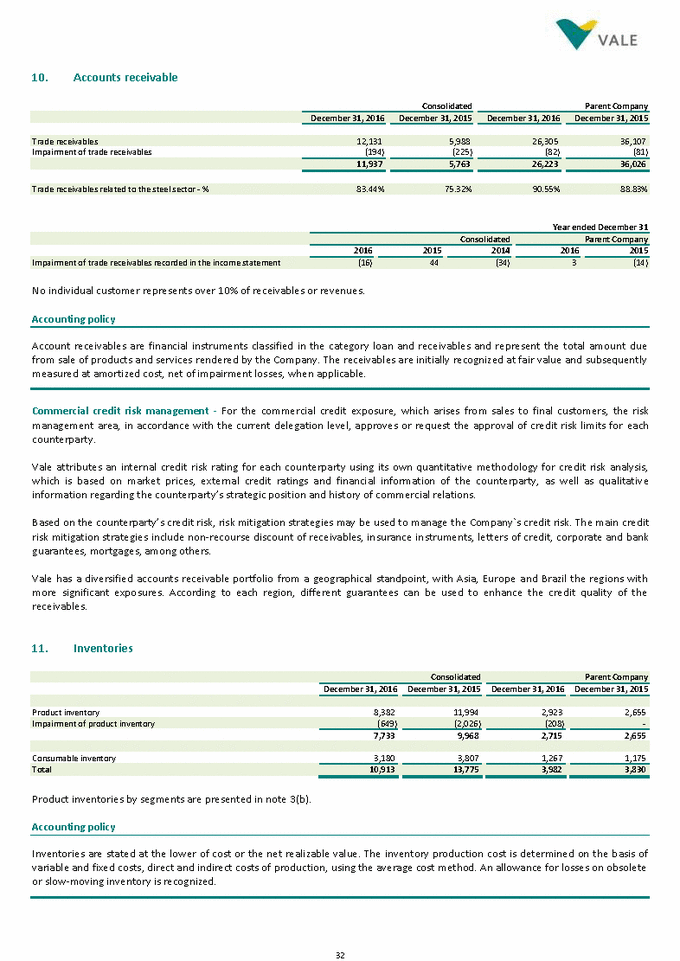
12. Recoverable taxes Recoverable taxes are presented net of provisions for losses on tax credits. Consolidated Parent Company Value-added tax 2,361 2,949 1,293 1,291 Others 91 97 67 38 Non-current 2,368 1,956 2,223 1,457 13. Other financial assets and liabilities Consolidated December 31, 2016 December 31, 2015 December 31, 2016 December 31, 2015 Financial investments 59 109 - - Derivative financial instruments (note 25) 892 474 1,454 363 1,184 856 2,046 1,100 Derivative financial instruments (note 25) 1,349 8,107 3,991 6,132 Participative stockholders' debentures (note 32(b)) - - 2,526 1,336 Parent Company December 31, 2016 December 31, 2015 December 31, 2016 December 31, 2015 Financial investments 4 18 - - Derivative financial instruments (note 25) 338 196 1,304 293 1,231 1,048 2,178 1,867 Derivative financial instruments (note 25) 1,033 3,559 3,427 5,296 Participative stockholders' debentures (note 32(b)) - - 2,526 1,336 33 10,845 10,333 59,681 70,469 63,837 53,728 6,774 9,812 Related parties (note 31) Others financial liabilities 1,468 760 834 889 Related parties (note 31) 106 114 - - Loans Others financial assets Current Non-Current 3,539 9,963 6,932 8,298 830 415 1,856 2,190 Related parties (note31) Others financial liabilities 5 5 273 233 Related parties (note 31) 732 587 - - Loans Others financial assets Current Non-Current Total 7,664 7,438 6,185 4,809 3,352 3,962 5,482 5,296 Current Total 7,664 7,438 6,185 4,809 3,480 4,825 4,392 5,212 Brazilian federal contributions December 31, 2016 December 31, 2015 December 31, 2016 December 31, 2015
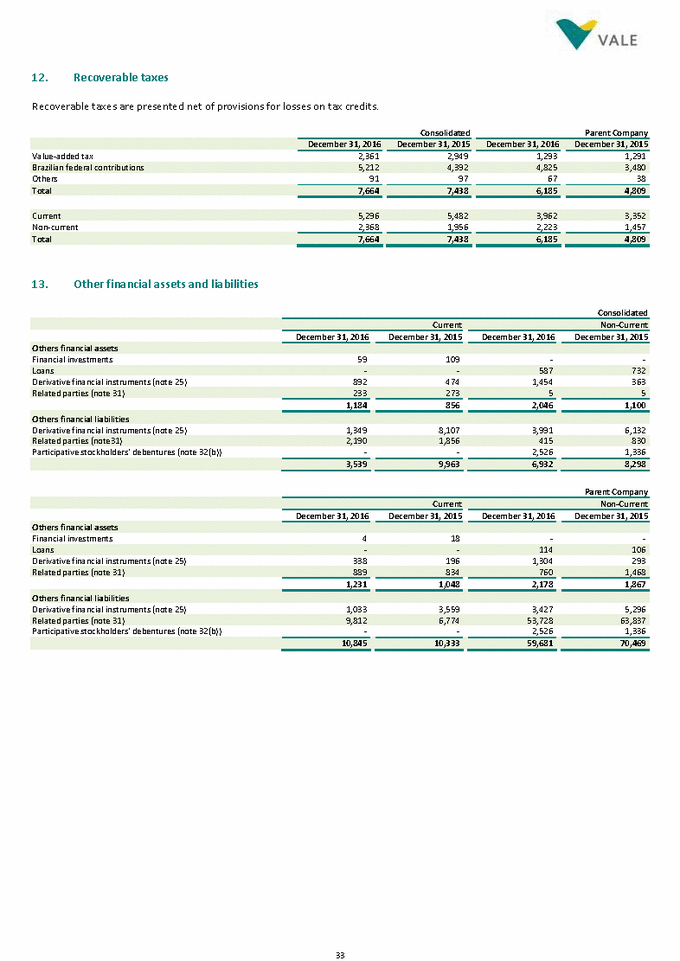
14. Non-current assets and liabilities held for sale and discontinued operations Consolidated Fertilizers assets (Discontinued operations) (i) Shipping assets Nacala Total Nacala Accounts receivable 279 21 - 300 13 Other current assets 348 370 - 718 522 Property, plant and equipment and Intangible, net 8,779 13,246 1,164 23,189 15,257 Total assets 13,178 13,652 1,164 27,994 15,792 Liabilities Other current liabilities 626 44 - 670 23 Total liabilities 3,360 194 - 3,554 416 (i) Include the nitrogen assets (R$1,265) and not include the noncontrolling interest (R$765 – note 16). a) Discontinued operations (Fertilizers assets) In December 2016, the Company entered into an agreement with The Mosaic Company (“Mosaic”) to sell (i) the phosphate assets located in Brazil, except those mainly related to nitrogen assets located in Cubatão (Brazil); (ii) the control of Compañia Minera Miski Mayo S.A.C., in Peru; (iii) the potassium assets located in Brazil; and (iv) the potash projects in Canada. The agreed transaction price is R$8,148 (US$2.5 billion), of which R$4,074 (US$1.25 billion) will be paid in cash and R$4,074 (US$1.25 billion) with 42.3 million common shares to be issued by Mosaic, which at the transaction date represents around 11% of Mosaic’s total outstanding common shares. Completion of the transaction is expected for the end of 2017 and is subject to th e spin-off of the nitrogen assets from Vale Fertilizantes S.A.; the fulfillment of usual precedent conditions, including the approval of the Administrative Council of Economic Defense (CADE) and other antitrust authorities; and other operational and regulatory matters. Vale may receive additional earn-out of the transaction up to R$847 (US$260) in circumstances where the phosphate price (MAP – Monoammonium Phosphate) and the Real exchange rate exceed certain levels during each of the twelve months periods after the completion of the transaction during two years. The assets located in Cubatão, which are mostly dedicated to the operation with nitrogen, will be transferred from Vale Ferti lizantes S.A. to an independent legal entity, for which the Company is actively seeking to identify potential buyers. Therefore, the fertilizer segment, including Cubatão, is presented as a discontinued operation and the related assets and lia bilities were classified as assets and liabilities held for sale, as established by IFRS 5. As consequence, the net assets of the fertilizers segment was adjusted to reflect the fair value less cost to sell and a loss of R$5,899 (R$3,893 net of tax) was recognized in the income statement from discontinued operations for the year ended December 31, 2016. At the completion of the transaction, the Company will recycle R$245 of the “Cumulative translation adjustments” to the income statement. For the years ended December 31, 2016, 2015 and 2014 the comprehensive income attributable to Vale’s stockholders regarding discontinued operations was a loss of R$458, a gain of R$355 and a loss of R$22, respectively. 34 Net non-current assets held for sale 9,818 13,458 1,164 24,440 15,376 1,821 16 - 1,837 28 Other non-current liabilities 365 1,047 - 134 913 Suppliers and contractors 2,216 8 2,224 Other non-current assets - 295 - - 295 Investments in associates and joint ventures - 1,268 - 7 1,261 Inventories Assets December 31, 2016 December 31, 2015
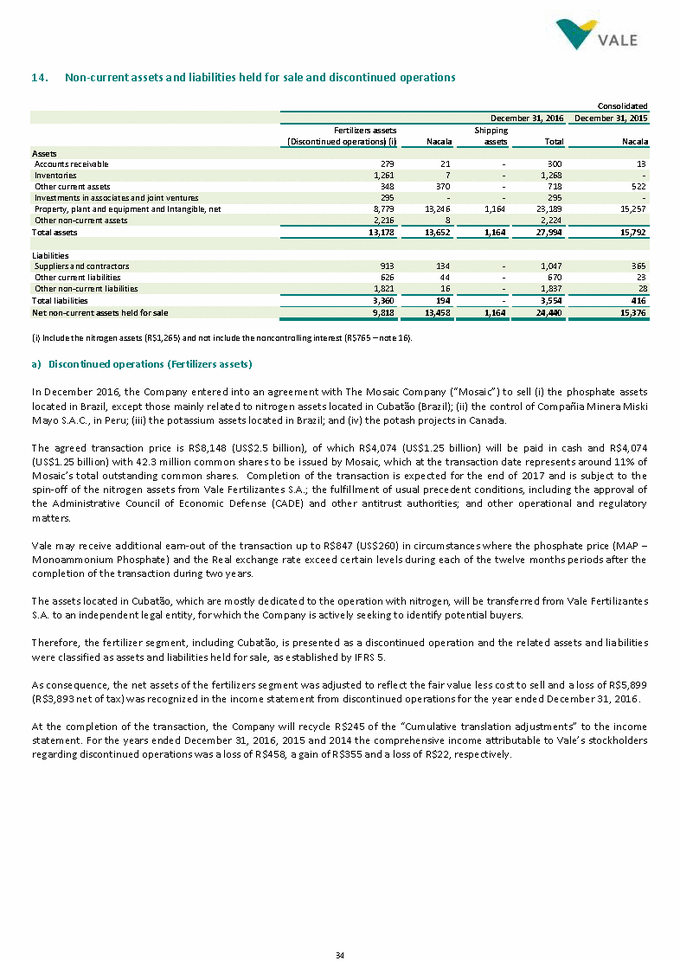
The results for the years and the cash flows of discontinued operations of the Fertilizer segment are presented as follows: Consolidated 2016 2015 2014 Net operating revenue 6,470 7,442 5,656 Operating expenses (448) (690) (668) (608) Operating income (loss) (6,372) 266 (3,126) Equity results in associates and joint ventures 10 19 10 Income taxes 2,134 (460) 1,058 Income (loss) attributable to noncontrolling interests (9) 31 14 Year ended December 31 Cash flow from discontinued operations Loss before income taxes (6,293) (200) (3,243) Equity results in associates and joint ventures (10) (19) (10) Results on measurement or sale of non-current assets 5,899 608 2,800 Increase (decrease) in assets and liabilities (226) 15 (366) Additions to property, plant and equipment (995) (853) (92) 29 Net cash provided (used) in investing activities (966) (936) 39 Financing activities (59) Net cash used in financing activities (59) (207) (163) b) Coal - Nacala logistic corridor (“Nacala”) In December 2014, the Company signed an agreement with Mitsui & Co., Ltd. (“Mitsui”) to sell 50% of its stake in the Nacala corridor and 15% of Vale´s stake in Vale Moçambique which holds the coal assets. After completion of the transaction, Vale will indirectly own 81% of the Moatize mine (Vale Moçambique) and approximately 50% of Nacala Corridor. Since Nacala will be jointly controlled by Vale and Mitsui the related assets and liabilities were classified as non-current assets held for sale with no impact in the income statement. In September 2016, the Company reviewed the terms related to this transaction, in which Mitsui agreed to contribute up to R$1,467 (US$450), being: (i) R$831 (US$255) for a 15% of Vale’s stake in the Moatize coal mine; and (ii) an additional contribution of up to R$636 (US$195) based on meeting certain conditions, including mine performance. Mitsui will also contribute R$1,134 (US$348) for a 50% stake in the equity and quasi-equity instruments of the Nacala and extend a long-term facility of R$538 (US$165). As at December 2016, completion of the transaction remains subject to successful completion of the Project Finance and certai n government approvals which are expected to occur in 2017. c) Shipping assets In June 2016, Vale approved a plan to dispose of its fleet of eleven ships. As a consequence, the referenced assets were reclassified to non-current assets held for sale and a loss of R$228 was recorded in the income statement as “Results on measurement or sale of non-current assets”. In the year ended December 31, 2016, the Company concluded the sale of three Very Large Ore Carriers (“VLOC’s”) for R$863 and four Capesize vessels for R$470. There are four vessels that are still held for sale as at December 31, 2016. 35 Net cash provided (used) by discontinued operations (527) 785 162 (163) (207) Repayments 131 (83) Others Investing activities Net cash provided by operating activities 498 1,928 286 125 485 (69) Others 980 1,039 1,197 Depreciation, amortization and depletion Adjustments: Operating activities 2016 2015 2014 Income (loss) attributable to Vale's stockholders(4,150)(691)(2,199) Income (loss) from discontinued operations(4,159)(660)(2,185) Income (loss) before income taxes(6,293)(200)(3,243) (127) (485) 69 Financial Results, net (2,800) (5,899) Results on measurement or sale of non-current assets (5,314) (5,878) (6,495) Cost of goods sold and services rendered Net income of discontinued operations Year ended December 31
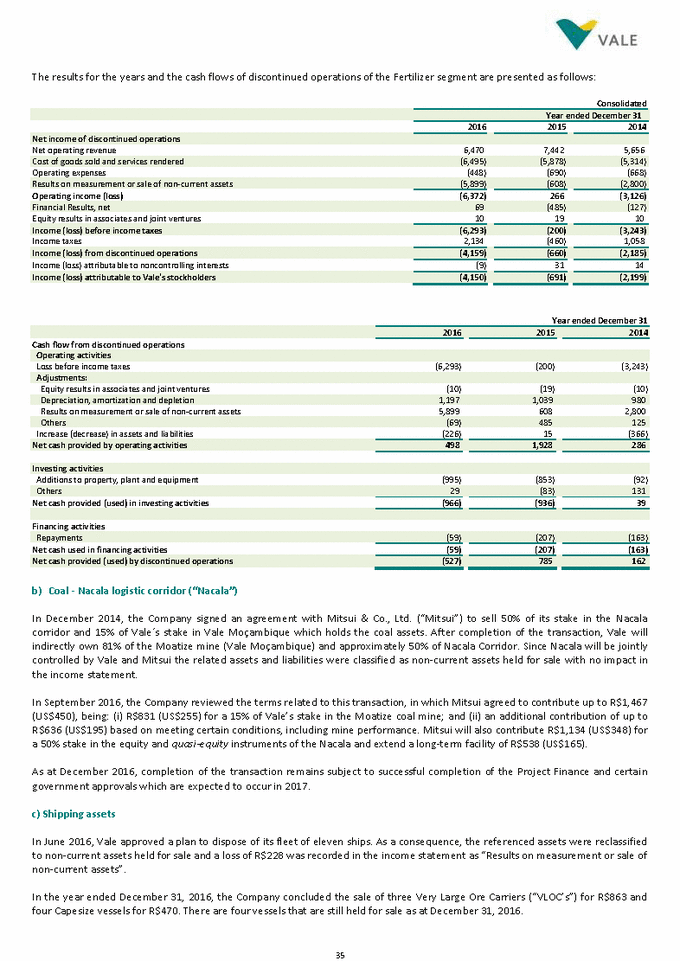
Accounting policy A non-current asset is classified as held for sale if its carrying amount will be recovered principally through a sale transaction rather than through continuing use. The criteria for recognition the non-current assets as held for sale are only considered satisfied when the sale is highly probable and the asset (or disposal group of assets) is available for immediate sale in its present condition. The Company measures the as sets held for sale (or group of assets) at the lower of its carrying amount and fair value less costs to sell. If the carrying amount exceeds the fair value less costs to sell an impairment loss is recognized against income. Any subsequent reversal of impairment is recognized only to the extent of the loss previously recognized. The assets and liabilities of a disposal group classified as held for sale are presented separately in the statement of financial position. The classification as a discontinued operation occurs through disposal, or when the operation meets the criteria to be classified as held for sale if this occurs earlier. A discontinued operation is a component of a Group business comprising cash flows and operations that may be clearly distinct from the rest of the Group and that represents an important separate li ne of business or geographical area of operations. The result of discontinued operations is presented in a single amount in the income statement, including the results after in come tax of these operations less any impairment loss. Cash flows attributable to operating, investing and financing activities of discontinued operations are described in a separate note. When an operation is classified as a discontinued operation, the income statements of the prior periods are re -presented as if the operation had been discontinued since the beginning of the comparative period. Any non-controlling interest relating to disposal group will be presented in the stockholders equity not being reclassified as a held for sale. 15. Investments The material non-consolidated entities for the Group are as follows: Joint ventures Companhia Coreano-Brasileira de Pelotização Brazil Pellets 50.0% 50.0% 50.0% Companhia Ítalo-Brasileira de Pelotização (i) Brazil Pellets 50.9% 51.0% 49.1% Companhia Siderúrgica do Pecém ("CSP") Brazil Steel 50.0% 50.0% 50.0% Samarco Mineração S.A. Brazil Pellets 50.0% 50.0% 50.0% Direct and indirect associates VLI S.A. Brazil Logistics 37.6% 37.6% 62.4% The composition of the relevant entities is presented in note 2(c). The associates and joint ventures are accounted for using the equity method. (i) Although the Company held majority of the voting capital, the entities are accounted under equity method due to sharehold ers’ agreements where relevant decisions are shared with other parties. 36 75.0% 25.0% 25.0% Coal China Henan Longyu Energy Resources Co., Ltd. 51.84% 46.75% 48.16% Logistics Brazil MRS Logística S.A. 49.0% 51.1% 51.0% Pellets Brazil Companhia Nipo-Brasileira de Pelotização (i) 49.1% 51.0% 50.9% Pellets Brazil Companhia Hispano-Brasileira de Pelotização (i) 45.0% 55.0% 55.0% Energy Brazil Aliança Geração de Energia S.A. (i) % Other investors % Voting capital % ownership Principal activity Location
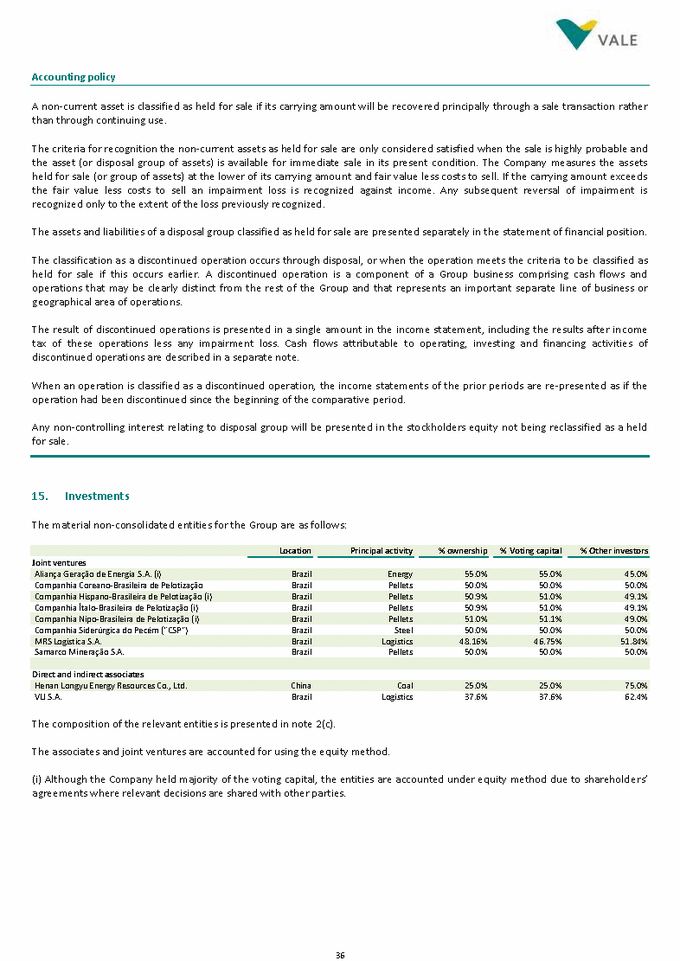
a) Changes during the year Changes in investments as follows: 2016 2015 2016 2015 Total Balance at January 1st, 5,166 6,315 11,481 5,469 5,509 10,978 127,517 128,615 Additions 2 889 891 - 90 90 1,918 5,265 Disposals (23) - (23) 241 - 241 - (4,000) Equity results in income statement 237 874 1,111 (506) (1,020) (1,526) 2,604 (36,864) Equity results in statement of comprehensive income - - - (17) - (17) (140) (460) Impairment (note 19) - - - (1,217) (510) (1,727) - (510) Others - (38) (38) (4) 255 251 32 289 The investments by segments are presented in note 3(b). b) Acquisitions and divestiture 2016 Thyssenkrupp Companhia Siderúrgica do Atlântico Ltd (“CSA”) – In April 2016, the Company sold 100% of its interest at CSA (26.87%) for a non-significant amount. The transaction resulted in R$266 loss on recycling the “Cumulative translation adjustments” recognized in the income statement as “Impairment and others results in associates and joint ventures”. Minas da Serra Geral S.A. ("MSG") – In March 2016, the Company completed the purchase option on additional 50% participation at MSG which was owned by JFE Steel Corporation ("JFE") in the amount of R$65. Vale now holds 100% of MSG’s shares. 2015 Energy generation assets - In December 2013, the Company signed agreements with CEMIG Geração e Transmissão S.A. (“CEMIG GT”) to incorporate two joint ventures, Aliança Norte Participações S.A. and Aliança Geração de Energia S.A and exchange of a ssets and shares. The transaction was completed in the first quarter of 2015, in which Vale received cash proceeds of R$306 and recognized a gain of R$55 as “Impairment and others results in associates and joint ventures” and a gain of R$546 as “Results on measurement or sales of non-current assets”. Divestiture of Shandong Yankuang International Coking Co., Ltd. (“Yankuang”) - The Company completed the sale of its participation in Yankuang, a producer of coking coal, methanol and other products. In this transaction, Vale recognized a gai n of R$241 as “Impairment and others results in associates and joint ventures”. The “Impairment and others results in associates and joint ventures” are as follows: Consolidated Parent Company Samarco provision (note 21) (3,967) - - (3,967) - Divestiture – Paragominas (i) (120) - - - - Energy generation assets - 55 - - 55 Impairment of investments (note 19) - (1,727) (71) - (510) (i) Mineração Paragominas shares were sold in 2011 and an accounts receivable of R$498 were outstanding. In December, 2016, the Company received R$378 and a loss of R$120 was recognized. 37 Total (4,353) (1,431) (139) (4,233) (455) - - (68) - Divestiture - Vale Florestar Fundo de Investimento em Participações - - - - 241 Divestiture - Shandong Yankuang International Coking Co., Ltd. - - (266) - - Divestiture - Thyssenkrupp Companhia Siderúrgica do Atlântico Ltd (266) 2016 2015 2014 2016 2015 Year ended December 31 Balance at December 31, 4,683 7,363 12,046 5,166 6,315 11,481 107,539 127,517 (30) (8,936) - - - (295) - (295) Transfer to held for sale (835) (1,672) (271) (47) (224) (707) (576) (131) Dividends declared - - 19 - 19 10 - 10 Equity results from discontinued operations 34,229 (13,791) 642 219 423 (384) (101) (283) Translation adjustment - 7 965 - 965 - - - Capitalizations Acquisitions - - - 17 1,819 1,836 - 1,818 Joint ventures Joint ventures Associates Associates Total Total Total Consolidated Parent Company
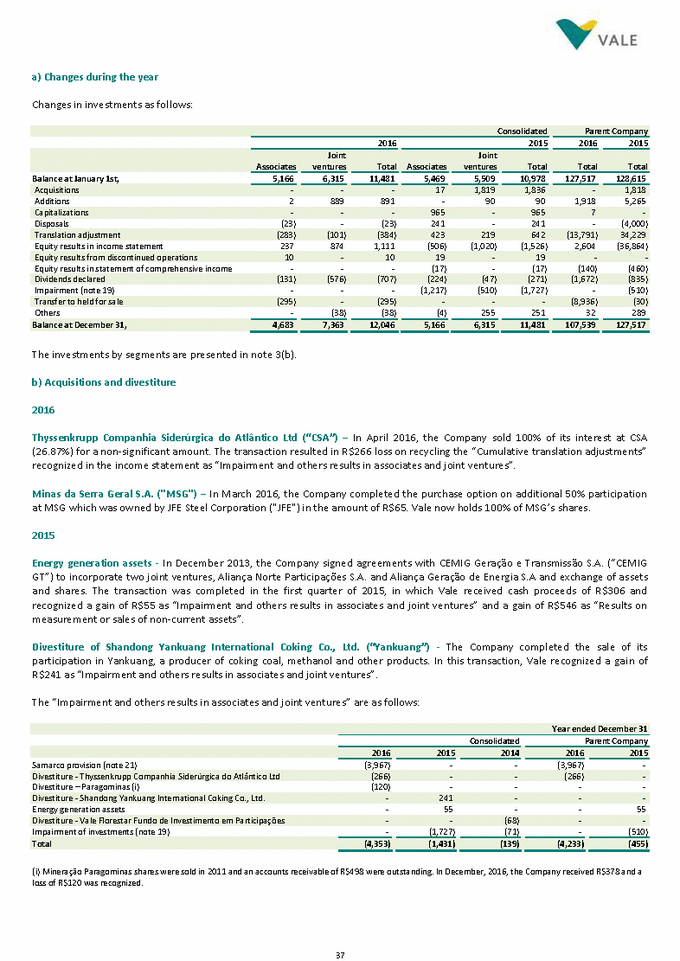
Investments (continued) Year ended December 31 Year ended December 31 Subsidiaries Biopalma da Amazônia S.A. 97.61 97.61 857 436 59 (593) (267) - - - Mineração Corumbaense Reunida S.A. 100.00 100.00 - 46 (117) (1,184) 394 - 147 456 Minerações Brasileiras Reunidas S.A. - Goodwill - - 4,060 4,060 - - - - - - Tecnored Desenvolvimento Tecnológico S.A. 100.00 100.00 39 - (38) - - - - - Vale Canada Limited 100.00 100.00 17,460 23,000 (4,889) (18,210) (586) - - - Vale International S.A. 100.00 100.00 34,172 27,290 13,854 (16,998) (8,626) - - - Vale Manganês S.A. 100.00 100.00 595 676 (81) (45) 57 - - - Others 1,307 875 (493) (784) 65 71 621 112 Joint ventures 115 - Aliança Norte Energia Participações S.A. 51.00 51.00 483 316 (21) 2 - - - - California Steel Industries, Inc. 50.00 50.00 604 613 107 (90) 27 13 - - Companhia Coreano-Brasileira de Pelotização 50.00 50.00 221 242 61 85 72 90 67 39 Companhia Hispano-Brasileira de Pelotização 50.89 51.00 191 222 50 50 60 95 44 25 Companhia Ítalo-Brasileira de Pelotização 50.90 51.00 223 194 56 69 60 33 36 13 Companhia Nipo-Brasileira de Pelotização 51.00 51.11 353 406 101 152 152 141 102 114 Companhia Siderúrgica do Pecém 50.00 50.00 1,716 879 135 (1,047) (101) - - - MRS Logística S.A. 48.16 46.75 1,592 1,436 201 143 179 34 87 108 Samarco Mineração S.A. (ii) 50.00 50.00 - - - (533) 884 - 459 906 Others 86 142 27 (11) (15) 1 2 1 7,365 6,326 874 (1,007) 1,318 544 912 1,206 Associates Henan Longyu Energy Resources Co., Ltd. 25.00 25.00 929 1,194 (18) (13) 76 - 109 75 Mineração Rio Grande do Norte S.A. 40.00 40.00 421 364 172 144 17 111 12 21 Teal Minerals Inc. 50.00 50.00 - - (11) (482) (81) - - - Thyssenkrupp Companhia Siderúrgica do Atlântico Ltd. - - - - (274) (142) - - - VLI S.A. 37.60 37.60 3,158 3,038 120 156 114 - 25 - Zhuhai YPM Pellet Co. 25.00 25.00 70 92 - 1 1 - - - Others 103 467 (26) (51) (172) 14 6 - 4,681 5,155 237 (519) (187) 125 152 96 Total of joint ventures and associates 12,046 11,481 1,111 (1,526) 1,131 669 1,064 1,302 Total 107,539 127,517 2,604 (36,864) (13,026) 2,782 2,344 2,211 (i) Dividends received by the Parent Company during the year ended at December 31, 2016 were R$1,591. (ii) Note 21. 38 137 - 173 157 1,876 1,896 55.00 55.00 Aliança Geração de Energia S.A. 95,493 116,036 1,493 (35,338) (14,157) 2,113 1,280 909 - - - 528 (99) 32 10,945 9,161 100.00 100.00 Vale Shipping Holding Pte. Ltd. - - - (100) (467) 394 4,201 3,904 100.00 100.00 Vale Malaysia Minerals Sdn. Bhd. - - - (2,100) (736) (6,166) 15,563 - Vale Fertilizantes S.A. - - - (4,238) 2,069 (2,694) 13,359 8,345 100.00 100.00 Vale International Holdings GmbH - - 258 142 696 598 8,166 8,557 100.00 100.00 Salobo Metais S.A. - 324 1,329 225 557 716 6,549 6,262 98.32 58.93 Minerações Brasileiras Reunidas S.A. 341 188 455 349 456 318 531 430 100.00 100.00 Companhia Portuária da Baía de Sepetiba - - - - - - 339 344 100.00 100.00 Aços Laminados do Pará S.A. % ownership % voting capital December 31, 2016 December 31, 2015 2016 2015 2014 2016 2015 2014 Investments Equity results in Income statement Dividends received (i)
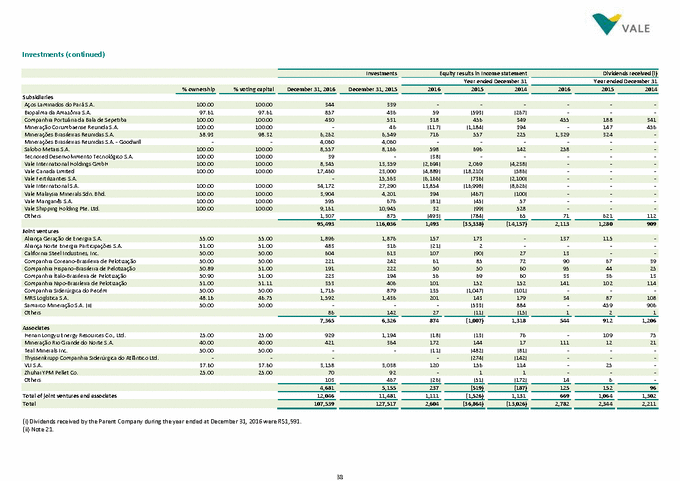
c) Summarized financial information The summarized financial information about relevant associates and joint-ventures are as follows: Joint ventures Associates Current assets 376 2,422 1,278 759 2,942 1,269 Total assets 4,311 14,837 2,314 7,573 4,428 14,856 Current liabilities 537 2,166 355 1,410 652 2,206 Total liabilities 863 11,406 366 4,268 714 6,457 Joint ventures Associates Current assets 255 1,036 1,369 1,263 3,447 1,963 3,572 6,674 Total assets 3,827 12,973 2,591 7,937 5,512 13,560 Current liabilities 138 2,060 462 1,529 421 1,994 277 3,426 Total liabilities 415 11,216 496 4,955 732 5,480 (i) Aggregate entity information: Companhia Coreano-Brasileira de Pelotização, Companhia Hispano-Brasileira de Pelotização, Companhia Ítalo-Brasileira de Pelotização, Companhia Nipo-Brasileira de Pelotização. Stand alone number may differ from number reported herein, since they may be adjusted, when necessary to Vale’s accounting policies including eventual goodwill, provisional price adjustment, etc. Accounting policy Joint arrangements investments - Joint arrangements are all entities over which the Group has shared control with one or more parties. Joint arrangement investments are classified as either joint operations or joint ventures depending on the contractu al rights and obligations of each investor. The joint operations are recorded in the financial statements to represent the Group's contractual rights and obligations. Accordingly, any jointly held assets, liabilities, revenues and expenses are accounted for individually in the financial stat ements. The Company does not have material joint operations. Interests in joint ventures are accounted for using the equity method, after initially being recognized at cost in the consol idated balance sheet. The Group's investment in joint ventures includes the goodwill identified in the acquisition, net of any accumulated impairment loss. The Group's interest in the profits or losses of its joint ventures is recognized in the income statement and participation i n the changes in reserves is recognized in the Group's reserves. When the Group's interest in the losses of an associate or joint venture is equal to or greater than the carrying amount of the investment, including any other receivables, the Group does not recognize additional losses, unless it has incurred obligations or made payments on behalf of the joint venture. d) Commitments and guarantees The commitments and guarantees issued the affiliates and joint ventures are presented in note 32. 39 414 (51) 297 703 (2,094) 314 Net income (loss) Stockholders'equity 3,412 1,757 2,095 2,982 4,780 8,080 3,486 311 34 9,156 Non-current liabilities 11,597 2,065 1,222 11,937 Non-current assets Aliança Geração de Energia Henan Longyu CSP Pelletizing (i) MRS Logística VLI S.A. December 31, 2015 318 (72) 417 531 270 285 Net income (loss) Stockholders'equity 3,448 3,431 1,948 3,305 3,714 8,399 4,251 62 2,858 11 9,240 326 Non-current liabilities 13,587 1,486 6,814 1,036 12,415 3,935 Non-current assets Aliança Geração de Energia Henan Longyu CSP Pelletizing (i) MRS Logística VLI S.A. December 31, 2016
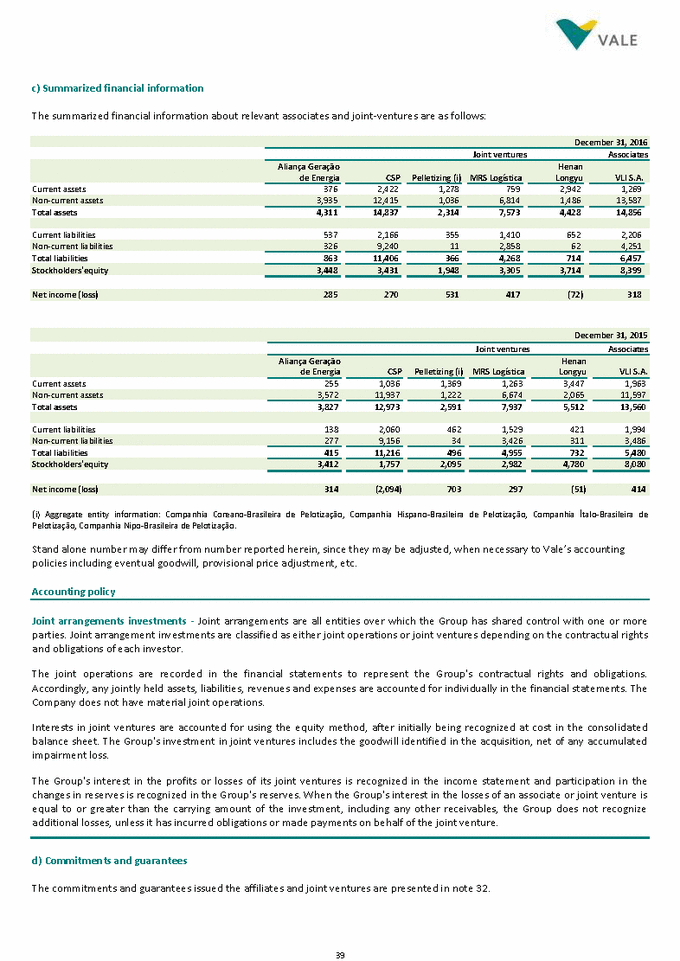
16. Noncontrolling interest a) Summarized financial information The summarized financial information, prior to the eliminations of the intercompany balances and transactions, about subsidiaries with material noncontrolling interest are as follows: Compañia Mineradora Miski Mayo S.A.C. (i) MBR PTVI VNC Others Total Non-current assets 10,370 5,435 6,848 1,400 Non-current liabilities 647 851 3,497 322 Equity attributable to noncontrolling interests 4,853 2,416 130 765 (1,703) 6,461 Net income (loss) 1,393 6 (2,627) 16 Compañia Mineradora Miski Mayo S.A.C. (i) MBR PTVI VNC Others Total Non-current assets 11,372 6,758 9,325 1,880 Non-current liabilities 608 1,208 10,603 395 Equity attributable to noncontrolling interests 5,311 2,894 215 1,018 (1,179) 8,259 Net income (loss) 911 141 (7,480) 51 Compañia Mineradora Miski Mayo S.A.C. (i) MBR PTVI VNC Others Total Net income (loss) 350 537 (2,609) 24 (i) Discontinued operation Stand alone number may differ from number reported herein, since they may be adjusted, when necessary to Vale’s accounting policies including eventual goodwill, provisional price adjustment, etc. 40 - - - - 109 - Dividends paid Income (loss) attributable to noncontrolling interests 6 219 (509) 14 (465) (735) December 31, 2014 - - 208 - - 324 Dividends paid Income (loss) attributable to noncontrolling interests 255 57 (1,458) 31 (669) (1,784) 12,932 7,176 (2,332) 1,697 Stockholders' equity Total liabilities 1,341 1,796 12,627 718 323 2,024 588 733 Current liabilities Total assets 14,273 8,972 10,295 2,415 Current assets 2,901 2,214 970 535 December 31, 2015 - - 177 - - 2,215 Dividends paid Income (loss) attributable to noncontrolling interests 572 3 (131) 9 (468) (15) 11,159 5,990 3,935 1,275 Stockholders' equity Total liabilities 1,111 1,324 4,418 473 151 921 473 464 Current liabilities Total assets 12,270 7,314 8,353 1,748 Current assets1,9001,8791,505348 December 31, 2016
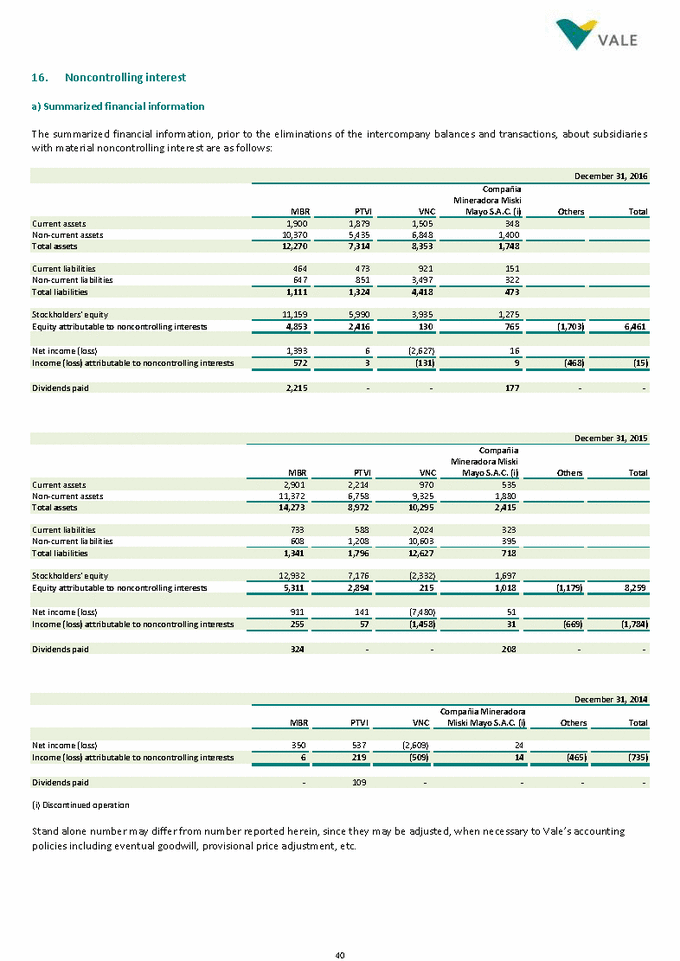
b) Acquisitions and divestments 2016 There were no significant changes in equity interest in subsidiaries in 2016. 2015 Sale of minority interest in Minerações Brasileiras Reunidas S.A. - In September 2015, the Company sold 36.4% of the total capital of subsidiary Minerações Brasileiras Reunidas S.A. (‘‘MBR’’) to an affiliate of Banco Bradesco S.A. (related party) for R$4,000. After the sale, Vale holds 62.5% of the total capital. Vale has an option to repurchase the shares after an initial period. 17. Intangibles Changes in intangibles are as follows: Goodwill Concessions Right of use Software Total Additions - 1,770 - 397 2,167 Amortization - (498) (141) (508) (1,147) Translation adjustment 1,769 - 163 - 1,932 Balance at December 31, 2015 11,544 7,084 811 1,350 20,789 Accumulated amortization - (3,025) (1,003) (2,647) (6,675) Additions - 3,926 3 46 3,975 Amortization - (842) (8) (534) (1,384) Translation adjustment (1,295) 361 (63) (33) (1,030) Effect of discontinued operations Balance at December 31, 2016 10,041 10,759 480 1,115 22,395 Accumulated amortization - (3,800) (243) (4,001) (8,044) Concessions Right of use Software Total Additions 1,770 - 397 2,167 Amortization (498) (6) (508) (1,012) Cost 10,109 224 3,997 14,330 Balance at December 31, 2015 7,084 123 1,350 8,557 Disposals (39) - - (39) Balance at December 31, 2016 10,278 118 918 11,314 Accumulated amortization (3,392) (106) (3,123) (6,621) a) Goodwill - The goodwill arose from the acquisition of iron ore and nickel business. b) Concessions - The concessions refer to the agreements with governments, for the exploration and the development of ports and railways. The Company holds railway concessions which are valid over a certain period of time. Those assets are classified as intangible assets and amortized over the shorter of their useful lives and the concession term at the end of which they will be returned to the government. 41 Balance at December 31, 2016 10,278 118 918 11,314 Cost 13,670 224 4,041 17,935 (826) (476) (5) (345) Amortization Additions 3,578 - 44 3,622 (5,773) (2,647) (101) (3,025) Accumulated amortization Balance at December 31, 2015 7,084 123 1,350 8,557 (65) (1) - (64) Disposals Balance at December 31, 2014 5,876 129 1,462 7,467 Parent Company Balance at December 31, 2016 10,041 10,759 480 1,115 22,395 Cost 10,041 14,559 723 5,116 30,439 (108) (2) - - (106) Transfer to net assets held for sale 295 289 (263) 269 - Transfers (102) - - - (102) Impairment of discontinued operations (note 14) (40) (1) - (39) - Disposals Balance at December 31, 2015 11,544 7,084 811 1,350 20,789 Cost 11,544 10,109 1,814 3,997 27,464 102 - - - 102 Acquisition of subsidiary (314) - - - (314) Impairment (note 19) (65) (1) - (64) - Disposals Balance at December 31, 2014 9,987 5,876 789 1,462 18,114 Consolidated
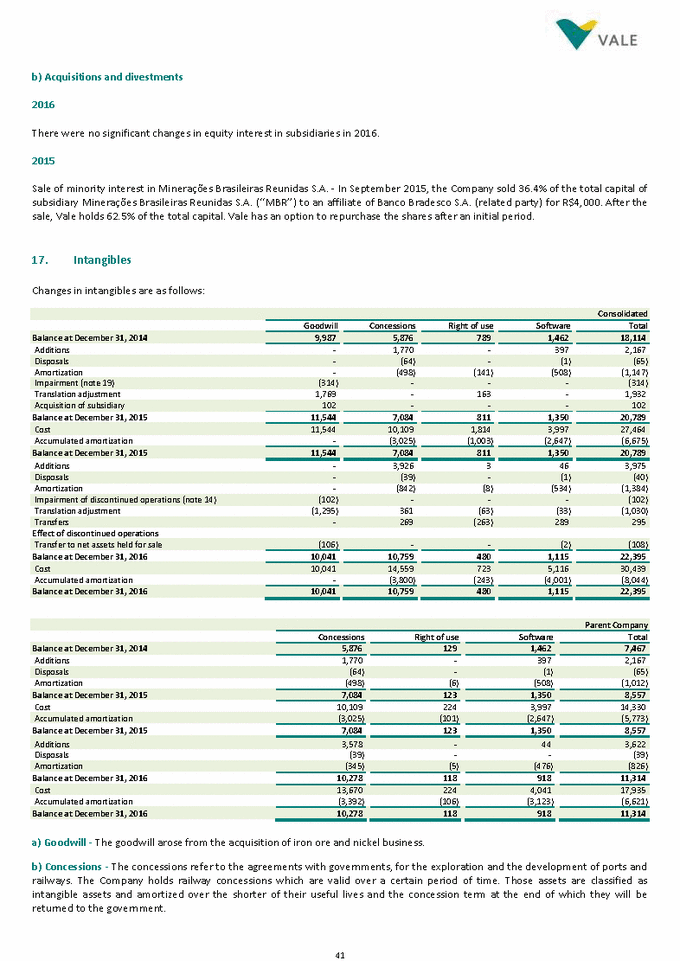
c) Right of use - Refers to the usufruct contract between the Company and noncontrolling stockholders to use the shares of Empreendimentos Brasileiros de Mineração S.A. (owner of Minerações Brasileiras Reunidas S.A. shares) and intangible asse ts identified in the business combination of Vale Canada Limited (“Vale Canada”). The amortization of the right of use will expi re in 2037 and Vale Canada's intangible assets will end in September of 2046. Accounting policy Intangibles are carried at the acquisition cost, net of amortization and impairment. The estimated useful lives are as follows: Useful life Right of use 22 to 31 years 18. Property, plant and equipment Changes in property, plant and equipment are as follows: Mineral properties Constructions in progress Land Building Facilities Equipment Others Total Additions (i) - - - - - - 32,370 32,370 Assets retirement obligations - - - - (1,294) - - (1,294) Transfers to non-current assets held for sale - - - - (504) - - (504) Impairment of discontinued operations (note 14) - - - - (701) 23 70 (608) Transfers (12) 10,203 7,421 6,692 968 9,837 (35,109) - Balance at December 31, 2015 2,989 35,538 32,378 28,532 40,234 28,135 43,453 211,259 Accumulated depreciation - (17,984) (18,979) (19,225) (26,358) (13,324) - (95,870) Additions (i) - - - - - - 17,628 17,628 Assets retirement obligation - - - - 1,028 - - 1,028 Transfers to non-current assets held for sale - - - - - (1,595) - (1,595) Impairment of discontinued operations (note 14) (174) - (214) - (5,409) - - (5,797) Transfers 85 7,351 4,160 3,392 840 3,613 (19,736) (295) Effect of discontinued operations (1,397) (8,671) Balance at December 31, 2016 2,360 34,790 30,866 22,141 27,312 24,494 38,653 180,616 Cost 2,360 54,359 51,051 38,955 52,360 36,890 38,653 274,628 Accumulated depreciation - (19,569) (20,185) (16,814) (25,048) (12,396) - (94,012) Balance at December 31, 2016 2,360 34,790 30,866 22,141 27,312 24,494 38,653 180,616 (i) Includes capitalized borrowing costs, see cash flow. 42 (201) (1,755) (261) (3,569) (404) (1,084) Transfer to net assets held for sale 1 - - - - - 1 - Acquisition of subsidiary (15,595) (1,454) (1,423) (4,080) (2,626) (2,158) (3,724) (130) Translation adjustment (3,079) 222 (502) (374) (367) (578) (1,476) (4) Impairment (note 19) (12,338) - (2,195) (2,766) (3,156) (2,432) (1,789) - Depreciation, amortization and depletion (1,930) (63) (1,338) (406) (65) (29) (27) (2) Disposals Balance at December 31, 2015 2,989 35,538 32,378 28,532 40,234 28,135 43,453 211,259 Cost 2,989 53,522 51,357 47,757 66,592 41,459 43,453 307,129 317 - 316 - - 1 - - Acquisition of subsidiary 25,222 1,385 4,711 8,492 5,207 1,947 3,258 222 Translation adjustment (32,249) (6,754) (7,895) (3,074) (4,228) (3,221) (7,028) (49) Impairment (note 19) (13,117) - (2,557) (2,869) (3,519) (2,349) (1,823) - Depreciation, amortization and depletion (6,385) (83) (5,395) (438) (290) (141) (27) (11) Disposals Balance at December 31, 2014 2,839 30,955 28,721 24,669 39,654 29,095 51,574 207,507 Consolidated Software 5 years Concessions 3 to 50 years
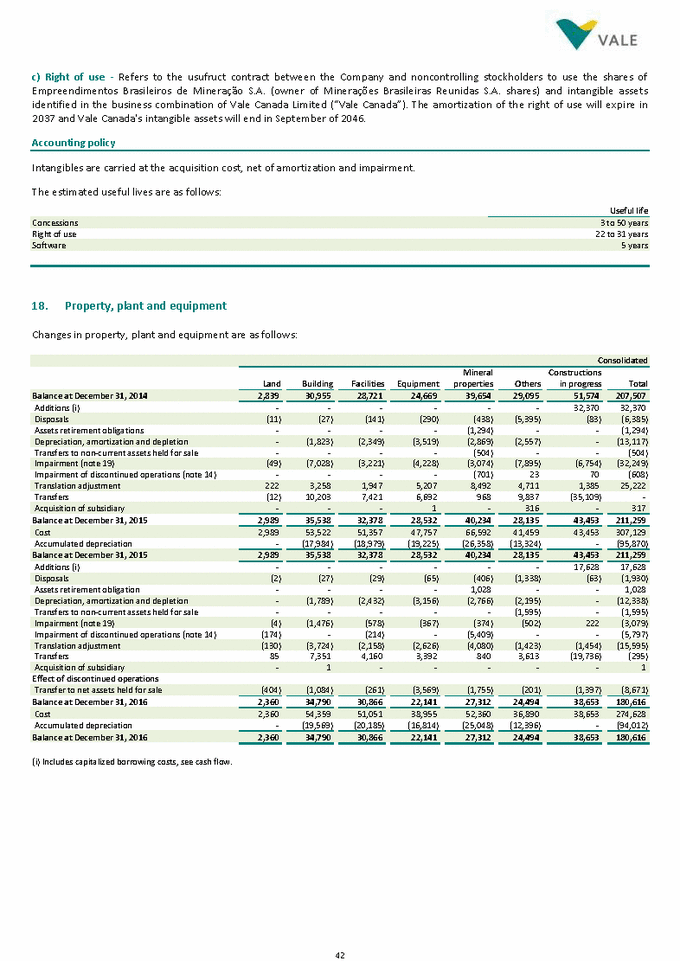
Mineral properties Constructions in progress Land Building Facilities Equipment Others Total Additions (i) - - - - - - 14,328 14,328 Assets retirement obligation - - - - (937) - - (937) Impairment (note 19) - 480 23 90 370 (30) (663) 270 Balance at December 31, 2015 1,672 19,546 19,379 8,371 4,215 14,203 29,501 96,887 Accumulated depreciation - (2,859) (5,816) (5,030) (1,247) (7,032) - (21,984) Additions (i) - - - - - - 9,551 9,551 Asset retirement obligation - - - - 202 - - 202 Impairment (note 19) - - 480 (86) - (16) (173) 205 Balance at December 31, 2016 1,684 20,945 20,416 8,479 4,122 16,499 29,911 102,056 Accumulated depreciation - (3,305) (6,877) (5,740) (1,454) (8,059) - (25,435) (i) Includes capitalized borrowing costs, see cash flow. The net book value of consolidated property, plant and equipment pledged to secure judicial claims on December 31, 2016 and 2015 were R$113 and R$174, respectively. For the parent company at December 31, 2016 and 2015 corresponds to R$107 and R$173, respectively. Accounting policy Property, plant and equipment are evaluated at the cost of acquisition or construction, net of amortization and impairment. Mineral properties developed internally are determined by (i) direct and indirect costs attributed to build the mine site and plant, (ii) financial charges incurred during the construction period, (iii) depreciation of other fixed assets used during construction, (iv) estimated decommissioning and site restoration expenses, and (v) other capitalized expenditures occurred during the development phase (phase when the project demonstrates its economic benefit to the Company, and the Company has ability and intention to complete the project). The depletion of mineral properties is determined based on the ratio between production and total proven and probable mineral reserves. Property, plant and equipment, other than mineral properties are depreciated using the straight-line method based on the estimated useful lives, from the date on which the assets become available for their intended use and are capitalized, except for land which is not depreciated. The estimated useful lives are as follows: Useful life Facilities 3 to 50 years Others: Wagon 30 to 44 years Ships 20 years The residual values and useful lives of assets are reviewed at the end of each fiscal year and adjusted if necessary. 43 Others 2 to 50 years Railway equipment 5 to 33 years Locomotives 12 to 25 years Equipment 3 to 40 years Buildings 15 to 50 years Balance at December 31, 2016 1,684 20,945 20,416 8,479 4,122 16,499 29,911 102,056 Cost 1,684 24,250 27,293 14,219 5,576 24,558 29,911 127,491 (300) (8,923) 3,691 (88) 1,300 1,633 2,075 12 Transfers (4,395) - (1,352) (207) (1,102) (1,059) (675) - Depreciation, amortization and depletion (95) (46) (27) - (4) (17) (1) - Disposals Balance at December 31, 2015 1,672 19,546 19,379 8,371 4,215 14,203 29,501 96,887 Cost 1,672 22,405 25,195 13,401 5,462 21,235 29,501 118,871 - (18,019) 5,578 731 2,294 2,962 6,223 231 Transfers (3,908) - (1,160) (341) (972) (924) (511) - Depreciation, amortization and depletion (187) - (5) (4) (138) (19) (10) (11) Disposals Balance at December 31, 2014 1,452 13,364 17,337 7,097 4,396 9,820 33,855 87,321 Parent Company
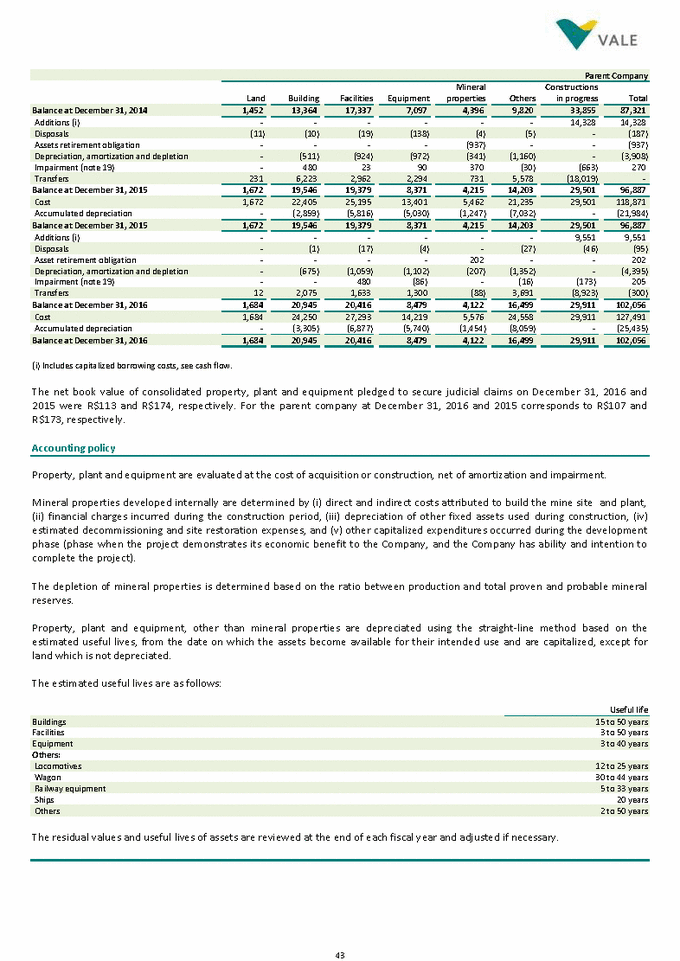
a) Mineral reserves Critical accounting estimates and judgments The estimates of proven and probable reserves are regularly evaluated and updated. These reserves are determined using generally accepted geological estimates. The calculation of reserves requires the Company to take positions on expected future conditio ns that are uncertain, including future ore prices, exchange rates, inflation rates, mining technology, availability of permits and production costs. Changes in some of these assumptions could have a significant impact on the proven and probable reserves of the Company. The estimated volume of mineral reserves is used as basis for the calculation of depletion of the mineral properties, and also for the estimated useful life which is a major factor to quantify the provision for asset retirement obligation , environmental recovery of mines and impairment of long lived asset. Any changes to the estimates of the volume of mine reserves and the useful lives of assets may have a significant impact on the depreciation, depletion and amortization charges and assessments of impairment. b) Expenditures and stripping costs (i) Exploration and evaluation expenditures - Expenditures on mining research are accounted for as operating expenses until the effective proof of economic feasibility and commercial viability of a given field can be demon strated. From then on, the expenditures incurred are capitalized as mineral properties. (ii) Expenditures on feasibility studies, new technologies and others research - The Company also conducts feasibility studies for many businesses which it operates including researching new technologies to optimize the mining process. After these costs are proven to generate future benefits to the Company, the expenditures incurred are capitalized. (iii) Maintenance costs - Significant industrial maintenance costs, including spare parts, assembly services, and others, are recorded in property, plant and equipment and depreciated through the next programmed maintenance overhaul. (iv) Stripping Costs - The cost associated with the removal of overburden and other waste materials (“stripping costs”) incurred during the development of mines, before production takes place, are capitalized as part of the depreciable cost of the mineral properties. These costs are subsequently amortized over the useful life of the mine. Post-production stripping costs are included in the cost of inventory, except when a new project is developed to permit access to a significant ore deposits. In such cases, the cost is capitalized as a non-current asset and is amortized during the extraction of the ore deposits, over the useful life of the ore deposits. Stripping costs are measured at fixed and variable costs directly and indirectly attributable to its removal and, when applic able, net of any impairment losses measured in the same basis adopted for the cash generating unit of which it belongs. 44
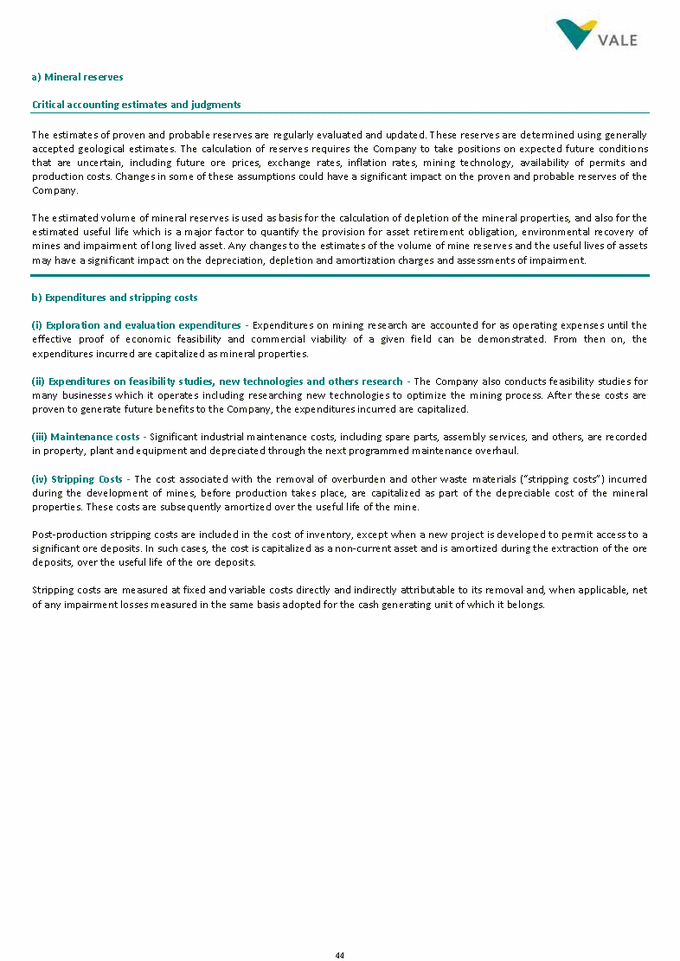
19. Impairment and onerous contracts The impairment losses (reversals) recognized in the year are presented below: Book value (after impairment) Impairment (reversals) Property, plant and equipment and intangible Coal Australia 140 91 2,460 787 Base metals – nickel Nouvelle Caledonie (VNC) 10,976 952 5,660 628 Coal Mozambique 5,772 - 9,302 - Iron ore Simandou Project - - - 2,793 Impairment of non-current assets 3,079 32,563 (87) Onerous contracts 861 1,382 - Iron ore Samarco Mineração S.A. - - 510 - Others Vale Soluções em Energia S.A. - - - 71 a) Impairment of non-financial assets The assets, where a trigger of impairment was identified, were tested using fair value less costs of disposal (“FVLCS”) model, except for the pelletizing plant that the value in use (“VIU”) model was applied. The FVLCS for each Cash Generating Units (“CGU”) was assessed considering “Level 3” fair value measurements, as it is derived from valuation techniques that includes inputs that are not based on observable market data. These cash flows were discounted using a post-tax discount rate ranging from 6% to 10%. The discount rate was based on the weighted average cost of capital (“WACC”) that reflected the risks specific to the CGU. Iron ore and pellets – During 2016, based on new market circumstances, the Company decided to resume Norte´s system pelletizing plant, based on the studies carried out by management that demonstrates its economic feasibility. Accordingly, the Company reversed the full impairments of R$536 recorded in 2013 and 2015. Of the total goodwill (note 17), R$4,060 is allocated to the group of ferrous mineral CGUs. The impairment analyses based on FVLCS model indicated that CGUs recoverable amount exceeds its carrying value; therefore, no impairment was recognized in the financial statements. In 2015, the Company recognized an impairment loss of R$2,023 due to lack of competitiveness in the Midwest system as a consequence of a complex logistic system associated with a consistent decline in iron ore prices. Accordingly, long-lived assets were fully impaired. In 2014, for the Simandou project, Vale recognized an impairment of R$2,793 related to the revocation of Vale’s former 51%-owned subsidiary VBG-Vale BSGR Limited ("VBG") mining concessions in Guinea. During the first quarter of 2015, the investment was sold. Coal – The Coal assets in Australia were impacted mainly by the revision of the future mining plans, which resulted in an impairment loss of R$91 in 2016 (R$2,460 in 2015). The impairment of R$787 registered in 2014 relates to Integra and Isaac Plans operations which were sold during the fourth quarter of 2015. In relation to the coal assets in Mozambique, Vale recognized an impairment loss of R$9,302 in 2015 due to the reduction in estimated future coal prices combined with the increase of logistics costs, which decreased the estimate d net recoverable amount of these assets. During 2016, no trigger event was identified for the purpose of impairment reassessing or any additional event or circumstance has changed that would indicate that the impairment recognized in 2015 is no longer applicable. Nickel - The decrease in long term nickel price projections, that significantly reduced the recoverable values of the VNL and VNC CGUs, combined with significant capital investments in new processing facilities in recent years, resulted in an impairment loss in the amount of R$2,112 and R$952 (R$13,394 and R$5,660) in 2016 and 2015 year end, respectively. 45 Impairment of investments in associates and joint ventures-1,72771 Base metals - CopperTeal Minerals Inc.--1,217-Investments in associates and joint ventures Impairment of non-current assets and onerous contracts3,94033,945(87) Several segmentsOther assets-460487-Iron oreMidwest system--2,023-Base metals – nickelOnça Puma6,766-(976)(4,295) Base metals – nickelNewfoundland (VNL)6,2412,11213,394-Iron ore North system 536 (536) 213 - Segments by class of assetsAssets or cash-generating unitas of December 31, 2016201620152014 Income statement
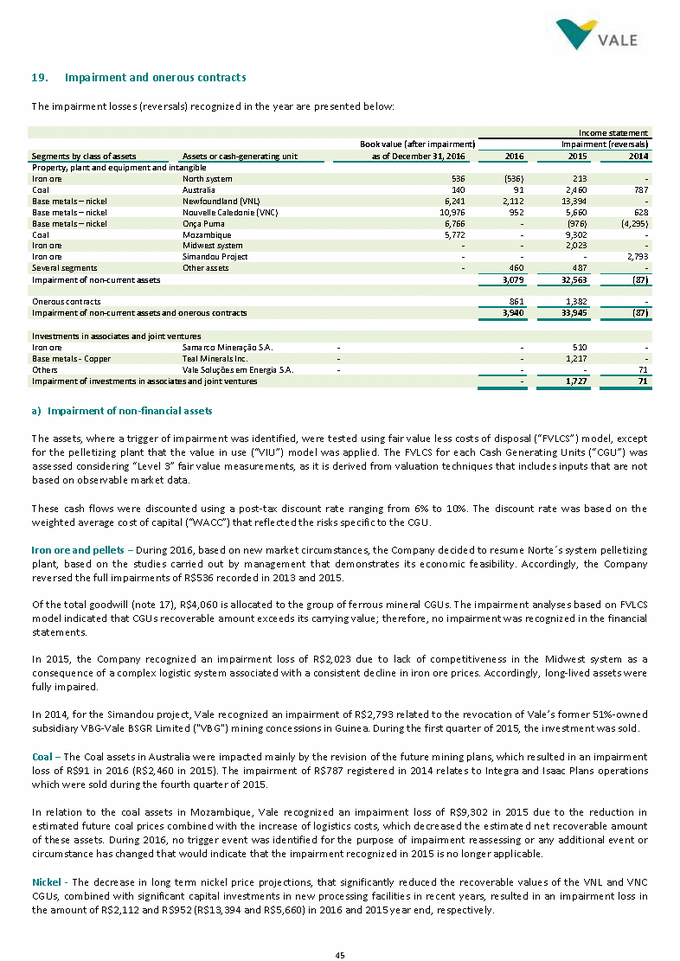
The assumption of nickel prices used in the FVLCS calculation for the nickel CGUs is in a range (US$ per ton) from 10,500 to 20,000 (13,000 to 20,000 in 2015). Cash flows used are designed based on the life of each CGU and considering a discount rate ranging from 6% to 8% per year. Of the total goodwill (note 17), R$5,981 is allocated to the group of nickel CGUs. The impairment analyses based on FVLCS model demonstrates that nickel CGUs recoverable amount exceeds its carrying value; therefore no impairment was recognized in the financial statements. In 2014, the Company identified that the indicators which caused an impairment to be recognized in previous years for Onça Puma were no longer applicable. This was mainly due to Onça Puma’s production resuming to normal capacity after the furnace problems in 2012. The total impairment registered in 2012 was reversed in 2014 and 2015. b) Onerous contract The provision recognized in 2016, R$611 is related to the contracts with minimum guaranteed volume for port structure in the Midwest system and R$250 for supply of manganese ore. In 2015, the Company recognized a provision related to the fluvial transportation contract with minimal guarantee volume in the amount of R$1,382 also in the Midwest system. c) Impairment of investments in associates and joint ventures In 2015, the Company recognized an impairment of R$510 in its investment in Samarco (note 21) and R$1,217 in Teal Minerals In c. (“Teal”). Teal recognized an impairment of property, plant and equipment due to the revision of future mining plans and the decrease of the copper price. Accounting policy Impairment of non-Financial assets - Non-financial assets are reviewed for impairment whenever events or changes in circumstances indicate that the carrying amount might not be recoverable. An impairment loss is recognized for the amount by which the asset´s carrying value exceeds its recoverable amount. The recoverable amount is the higher of an asset’s fair valu e less costs of disposal (“FVLCS”) and value in use (”VIU”). FVLCS is generally determined as the present value of the estimated future cash flows expected to arise from the continued use of the asset, including any expansion prospects, and its eventual disposal. VIU model is determined as the present value of the estimated future cash flows expected to arise from the continued use of the asset in its present form. Value in use is determined by applying assumptions specific to the Group’s continued use and cannot take into account future development. These assumptions are different to those used in calculating fair value and consequently the VIU calculation is lik ely to give a different result to a FVLCS calculation. The future cash flows are based on the current life-of-mine plan or long-term production plan for the cash-generating unit. Assets that have an indefinite useful life and are not subject to amortization, such as goodwill, are tested annually for imp airment. For the purposes of assessing impairment, assets are grouped at the lowest levels for which there are separ ately identifiable cash flows (Cash Generating Units (CGUs)). Goodwill is allocated to Cash Generating Units or Cash Generating Units groups that are expected to benefit from the business combinations in which the goodwill arose and are identified in accor dance with the operating segment. Non-current assets (excluding goodwill) in which the Company recognized impairment in the past are reviewed whenever events or changes in circumstances indicate that the impairment may no longer be applicable. In such cases, an impairment reversal will be recognized. Onerous Contracts - For onerous contracts, provision is recognized for the present value of certain long-term contracts where the unavoidable cost of meeting the Company’s obligations exceed the economic benefits to be receive under it. 46
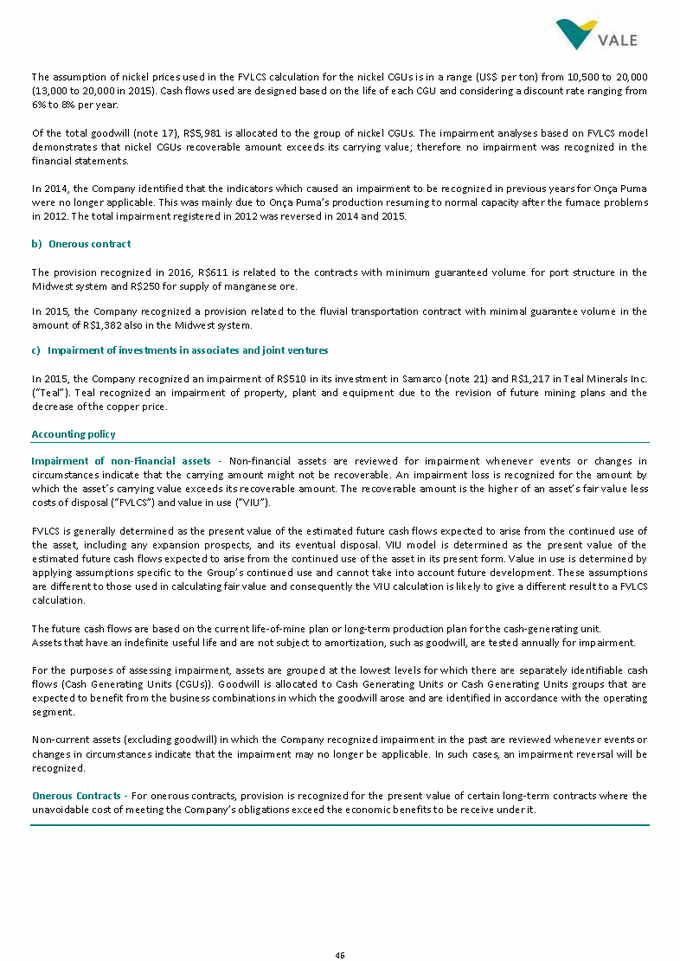
Critical accounting estimates and judgments The Company determines its cash flows based on the budgets approved by management, which require the use of the following key assumptions: (i) mineral reserves and mineral resources measured by internal experts; (ii) costs and investments based on the best estimate of projects as supported by past performance; (iii) sale prices consistent with projections available in reports pub lished by industry considering the market price when appropriate; (iv) the life of each cash-generating unit (ratio between production and mineral reserves); and (v) discount rates that reflect specific risks relating to the relevant assets in each cash -generating unit. These assumptions are subject to risk and uncertainty; hence there is a possibility that changes in circumstances will change these projections, which may impact the recoverable amount of the assets. 20. Loans, borrowings and cash and cash equivalents a) Net debt The Company evaluates the net debt with the objective of ensuring the continuity of its business in the long term, being able to generate value to its stockholders, through the payment of dividends and capital gain. December 31, 2016 December 31, 2015 December 31, 2016 December 31, 2015 Debt contracts in the international markets 68,863 84,625 26,796 34,208 Total of loans and borrowings 95,564 112,666 52,048 60,722 (-) cash and cash equivalents 13,891 14,022 1,203 518 b) Cash and cash equivalents Cash and cash equivalents includes cash, immediately redeemable deposits and short -term investments with an insignificant risk of change in value. They are readily convertible to cash, being R$3,132 denominated in R$, indexed to the Brazilian Interbank In terest rate (“DI Rate”or”CDI”), R$9,448 denominated in US$, mainly time deposits and R$1,311 denominated in other currencies. c) Loans and borrowings (i) Total debt Consolidated December 31, 2016 December 31, 2015 December 31, 2016 December 31, 2015 Floating rates in: EUR - - 688 - US$ - 4,651 42,643 50,463 Other currencies 55 56 679 659 1,807 6,924 67,056 77,701 Floating rates in: Basket of currencies and US$ indexed to LIBOR 1,117 1,133 3,962 5,239 R$ - 246 - 1,047 3,603 2,864 23,098 25,177 47 5,410 9,788 90,154 102,878 503 107 658 959 Accrued charges 703 214 Fixed rates in: 18,388 18,326 827 1,313 R$, indexed to TJLP, TR, IPCA, IGP-M and CDI Debt contracts in Brazil - - 1,274 990 Accrued charges 6,376 5,157 - - EUR Fixed rates in: 20,203 17,889 943 762 US$ Debt contracts in the international markets Current liabilities Non-current liabilities Net debt 81,673 98,644 50,845 60,204 25,252 26,514 26,701 28,041 Debt contracts in Brazil Parent Company Consolidated
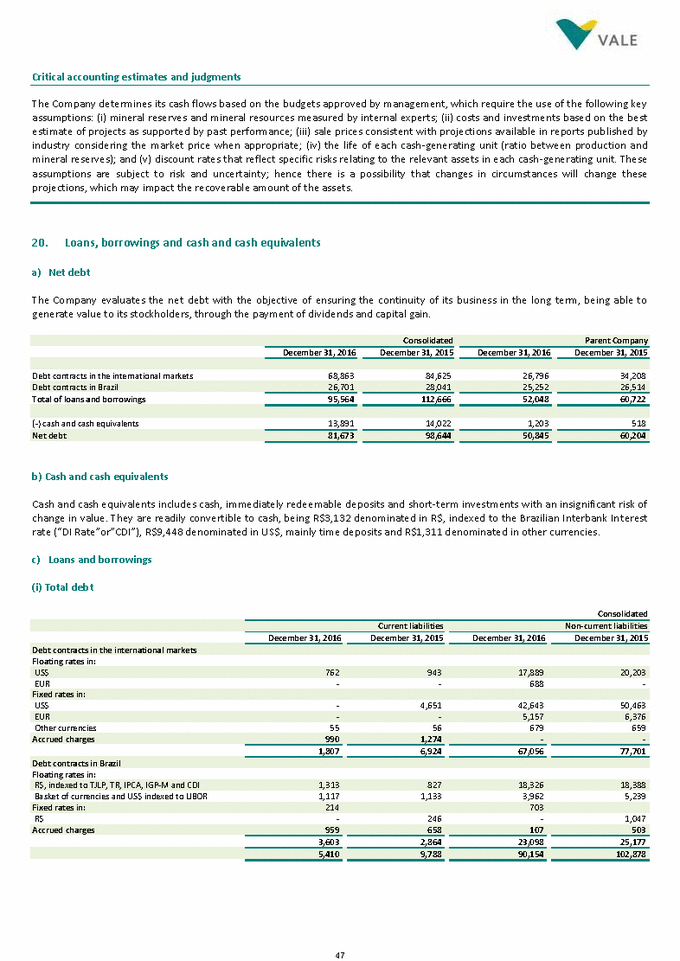
Parent Company December 31, 2016 December 31, 2015 December 31, 2016 December 31, 2015 Floating rates in: Fixed rates in: EUR - - 5,158 6,376 873 1,983 25,923 32,225 Floating rates in: Basket of currencies and US$ indexed to LIBOR 1,117 1,125 3,962 5,227 R$ 190 190 685 876 3,298 2,753 21,954 23,761 The future flows of debt payments principal, per nature of funding and interest are as follows: Principal Principal 2017 192 - 3,266 3,458 5,159 2,814 2019 3,546 3,259 4,436 11,241 3,947 7,289 2021 2,027 4,374 2,972 9,373 2,751 4,770 2026 onwards 264 24,411 769 25,444 17,335 5,515 (i) Estimated future payments of interest, calculated based on interest rate curves and foreign exchange rates applicable as at December 31, 2016 and considering that all amortization payments and payments at maturity on loans and borrowings will be made on their contracted payments dates. The amount includes the estimated values of future interest payments (not yet accrued), in addition to interest already recognized in the financial statements. At December 31, 2016, the average annual interest rates by currency are as follows: Consolidated Parent Company Loans and borrowings in R$ (ii) 10.94% 21,588 11.23% 20,142 Other currencies 3.35% 737 (i) In order to determine the average interest rate for debt contracts with floating rates, the Company used the last renegotiated rate at December 31, 2016. (ii) R$ denominated debt that bears interest at IPCA, CDI, TR or TJLP, plus spread. For a total of R$15,213, the Company entered into derivative transactions to mitigate the exposure to the cash flow variations of the floating rate debt denominated in R$, resulting in an average cost of 2.42% per year in US$. (iii) Eurobonds, for which the Company entered into derivatives to mitigate the exposure to the cash flow variations of the debt denominated in EUR, resulting in an average cost of 4.33% per year in US$. ii) Credit and financing lines Available amount Contractual currency Date of agreement Period of the agreement December 31, 2016 Type Total amount Revolving credit facilities US$ May 2015 5 years 9,777 9,777 Financing lines BNDES - CLN 150 R$ September 2012 10 years 3,883 20 (i) Memorandum of understanding signature date, however term is considered from the signature date of each contract amendment. This credit line supported or supports the pelletizing plant VIII, Onça Puma, Salobo I and II and capital expenditure of Itabira projects. 48 2,050 6,163 10 years May 2014 R$ BNDES - S11D e S11D Logística 287 7,300 10 years April 2008 R$ BNDES (i) 6,518 6,518 5 years July 2013 US$ Revolving credit facilities Credit lines 95,564 52,048 5,365 4.06% 6,052 3.82% EUR (iii) 26,541 3.60% 67,187 4.92% US$ Average interest rate (i) Total debt Average interest rate (i) Total debt 21,565 49,712 22,231 93,508 44,439 50,691 10,691 7,493 18,958 3,950 10,729 4,279 Between 2022 and 2025 7,780 3,292 12,571 3,018 4,361 5,192 2020 11,832 4,462 12,463 3,820 2,578 6,065 2018 Development agencies Estimated future interests payments (i) Bank loans Capital markets Total Total Consolidated Parent Company 4,171 4,736 47,877 55,986 - - 658 932 Accrued charges Fixed rates in: 17,658 17,307 780 1,059 R$, indexed to TJLP, TR, IPCA, IGP-M and CDI Debt contracts in Brazil - - 479 425 Accrued charges 9,020 4,889 937 - US$ 16,829 15,876 567 448 US$ Debt contracts in the international markets Current liabilities Non-current liabilities
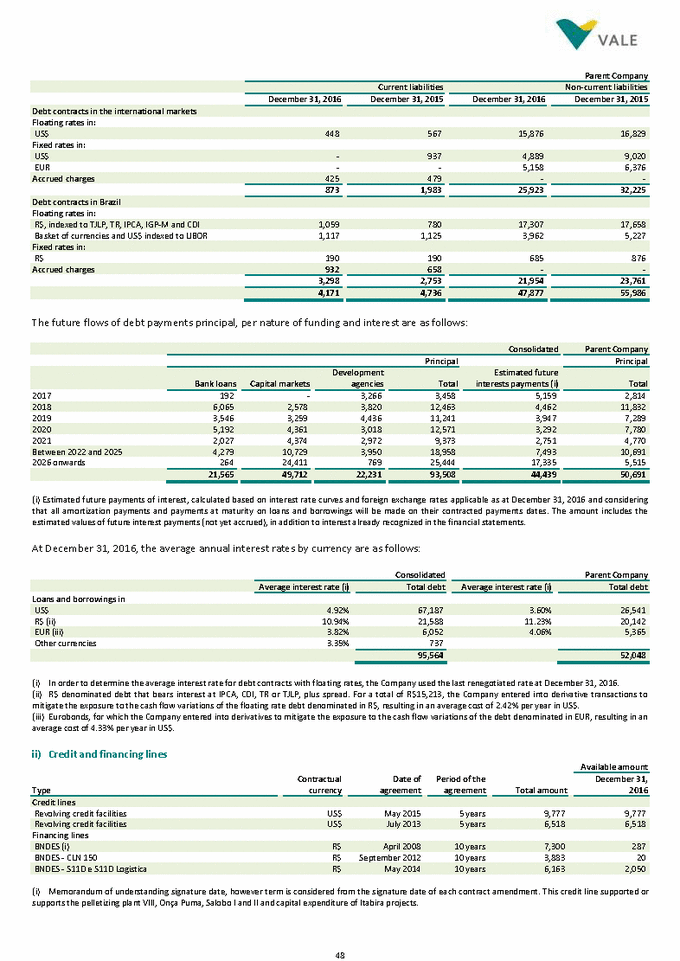
Liquidity risk - To mitigate such risk, Vale has a revolving credit facilities to assist the short term liquidity management and to enable more efficiency in cash management, being consistent with the strategic focus on cost of capital reduction . The revolving credit facilities available today were acquired from a syndicate of several global commercial banks. iii) Funding In January 2016, the Company drew down part of its revolving credit facilities which were fully amortized in November 2016. There was no outstanding debt on this lines at December 31, 2016. In June and August 2016, the Company issued through its wholly owned subsidiary Vale Overseas Limited the guaranteed notes du e 2021 and 2026 totaling R$7,333 (US$2,250). These notes bear a coupon of 5.875% and 6.250% per year, respectively, payable semi-annually, and were sold at a price of 100.000% of the principal amount. In February 2017 (subsequent event), the Company issued through Vale Overseas Limited guaranteed notes due August 2026 totaling R$3,259 (US$1,000). The notes bears 6.250% coupon per year, payable semi-annually, and were sold at a price of 107.793% of the principal amount. The notes will be consolidated with, and form a single series with, Vale Overseas’s R$3,259 (US$1,000) 6.250% notes due 2026 issued on August, 2016, mentioned above. Vale intends to apply the net proceeds from the offering on the earlier redemption of Vale’s EUR750 notes, due in March 2018, which is expected to occur during March 2017. iv) Guarantees As at December 31, 2016 and 2015, loans and borrowings are secured by property, plant and equipment and receivables in the amount of R$1,538 and R$1,937, respectively. The securities issued through Vale’s 100%-owned finance subsidiary Vale Overseas Limited are fully and unconditionally guaranteed by Vale. v) Covenants Some of the Company’s debt agreements with lenders contain financial covenants. The main covenants in those agreements requir e maintaining certain ratios, such as debt to EBITDA (Earnings before Interest Taxes, Depreciation and Amortization) and interest coverage. The Company has not identified any instances of noncompliance as at December 31, 2016 and 2015. Accounting policy Loans and borrowings are initially measured at fair value, net of transaction costs incurred and are subsequently carried at amortized cost and updated using the effective interest rate method. Any difference between the proceeds (net of transaction costs) and the redemption value is recognized in the Income statement over the period of the loan, using the effective interest rate method. The fees paid in obtaining the loan are recognized as transaction costs. Loans and borrowing costs are capitalized as part of property, plants and equipment if those costs are directly related to a qualified asset. The capitalization occurs until the qualified asset is ready for its intended use. The average capitalization rate is 37%. Borrowing costs that are not capitalized are recognized in the income statement in the period in which they are incurred. 49
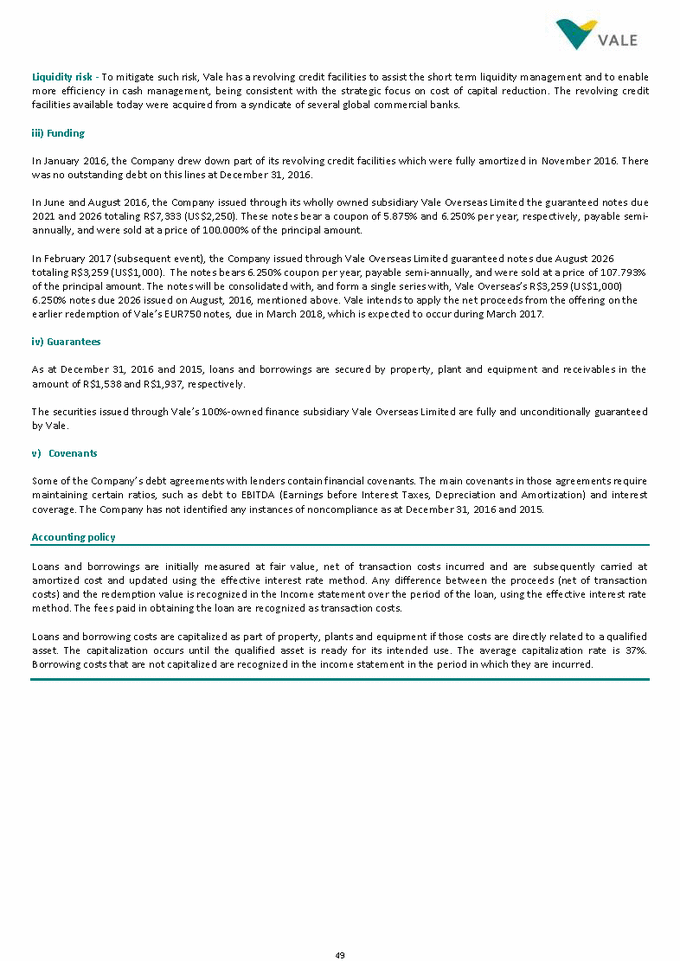
21. Liabilities related to associates and joint ventures Refers to the provision to comply with the obligations under the agreement related to the dam failure of Samarco Mineração S.A. (“Samarco”), which is a Brazilian joint venture between Vale S.A. and BHP Billiton Brasil Ltda. (“BHPB”), as follows: a) Framework agreement Samarco and its shareholders, Vale S.A. and BHPB, entered into an Agreement (“Framework Agreement“) in connection with the R$20.2 billion lawsuit on March 2, 2016 with the Brazilian federal government, the two Brazilian states affected by the failu re (Espírito Santo and Minas Gerais) and other governmental authorities in order to implement t he programs for remediation and compensation of the areas and communities affected by Samarco’s dam (Fundão) failure. The Framework Agreement does not contemplate admission of civil, criminal or administrative liability for the Fundão dam failure. The Framework Agreement has a 15-year term, renewable for successive one-year periods until all the obligations under the Framework Agreement have been performed. Under the Framework Agreement, Samarco, Vale S.A. and BHPB have agreed to establish a foundation to develop and implement social and economic remediation and compensation, to be funded by Samarco as follows: R$2.0 billion in 2016, R$1.2 billion in 2017 and R$1.2 billion in 2018. From 2019 to 2021, annual contributions to the foundation will range from R$800 to R$1.6 billion based on the projects approved for the relevant year. From 2022 onwards, the annual contributions will be determined on the basis of the amount of funding necessary to complete remaining programs approved for each relevant year. The foundation will allocate an annual amount of R$240 over 15 years to the implementation of compensation programs, and these annual amounts are included in the annual contributions described above for the first six years. Through the end of 2018, Samarco is expected to provide R$500 for sewage collection and treatment and solid waste disposal under the terms of the Framework Agreement. To the extent that Samarco does not meet its funding obligations to the foundation, each of Vale S.A. and BHPB will provide, under the terms of the Framework Agreement, funds to the Foundation in proportion to its 50% equity interest in Samarco. On June 24, 2016, the Renova Foundation (“Foundation”) was constituted, under the Framework Agreement, to develop and implement the socio-economic restoration and compensation programs. The Foundation began its operations in August of 2016. As the consequence of the dam failure, governmental authorities ordered the suspension of Samarco’s operations. b) Estimates used for the provision Samarco initially expected to resume its operations in the last quarter of 2016. Based on this assumption, Samarco´s cash flow projections indicated that it would be able to generate all or a substantial part of the funding required under the Framework Agreement. This assumption was supported by studies of appropriate technical solutions for the resumption of operations, as well as the progress of the work on the remaining dam structures after the failure and the implementation of the socio-economic and socio-environmental programs contemplated in the Framework Agreement. In light of the stage of procedures necessary to resume operations and the uncertainties related to the licensing approval by governmental authorities during 2016, Samarco revised its assumption and concluded that was unable to make a reliable estimat e of how and when its operations will resume. Due to the above, as well as additional uncertainties regarding Samarco's cash flow, Vale S.A. recognized a provision on its interim financial statements as of June 30, 2016, for estimated costs in the amount of R$5,560 which was discounted at a risk-free rate, resulting in R$3,733 provision, which represents Vale S.A.’s best estimate of the obligation to comply with the reparation and compensation programs under the Framework Agreement, equivalent to its 50% equity interest in Samarco. In August, 2016, Samarco issued non-convertible private debentures which were subscribed equally by Vale S.A. and BHPB, and the resources contributed by Vale S.A. were allocated as follows: (i) R$222 was used by Samarco in the repara tion programs in accordance with the Framework Agreement, and therefore, applied against the provision of R$3,733 mentioned above; and (ii) R$234 was applied by Samarco´s to fund its working capital, and recognized in Vale’s income statement as “Impairment and other results in associates and joint ventures”. Vale S.A. intends to make available short -term facilities in the first half of 2017 of up to R$375 to Samarco to support its operations, without undertaking an obligation to Samarco. Funds for working capital requirements will be released as needed by the shareholders subject to achieving certain milestones. 50
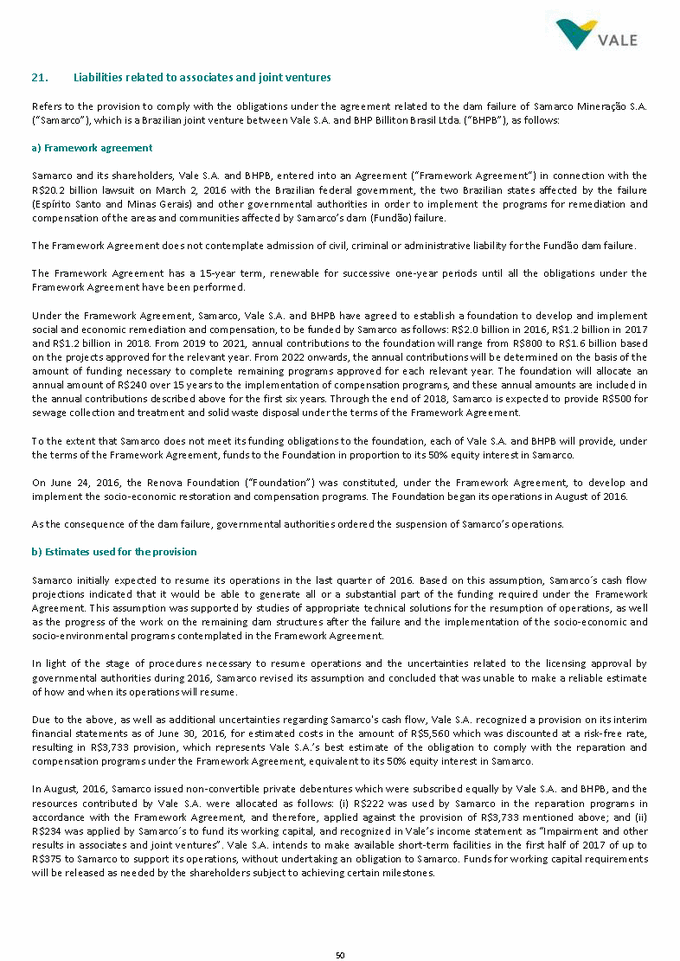
As a result of constituting the Foundation, most of the reparation and compensation programs were transferred from Samarco. Therefore, Vale S.A. made contributions to the Foundation totaling R$ 239 to be used in the programs in accordance with the Framework Agreement. As a result of the above mentioned, the movements of the provision during the year are as follows: 2016 Provision recognized 3,733 Discount rate accretion 239 Non-current liabilities 2,560 At each reporting period, Vale S.A. will reassess the key assumptions used by Samarco in the preparation of the projected future cash flows and will adjust the provision, if required. c) Relevant information of Samarco Samarco is a Brazilian entity jointly controlled by Vale S.A. and BHPB, in which each shareholder has a 50% ownership interest. Samarco operates an integrated enterprise consisting of mining, beneficiation and concentration of low-grade iron ore in the municipality of Mariana, in the State of Minas Gerais, as well as the hauling of such concentrated ore through ore pipelines connecting the its two operating plants located in Minas Gerais and Espírito Santo. On November 5, 2015, Samarco experienced the failure of an iron ore tailings dam (“Fundão”) in the state of Minas Gerais, which affected communities and ecosystems, including the Rio Doce river. Following the dam failure, the state government of Minas Gerais ordered the suspension of Samarco’s operations. The summarized financial information about Samarco are as follows: Current assets 536 Total assets 21,749 Current liabilities 15,811 Total liabilities 25,635 Under Brazilian legislation and the terms of the joint venture agreement, Vale does not have an obligation to provide funding to Samarco. As a result, Vale’s investment in Samarco was reduced to zero. Since the initial date of the accident, Samarco and its shareholders disbursed the total amount of R$2.0 billion to comply with the obligations under the Framework Agreement. 51 Loss(326) Stockholders' equity(3,886) Non-current liabilities9,824 Non-current assets21,213 December 31, 2016 Liabilities 3,511 951 Current liabilities Balance on December 31, 3,511 (461) Payments made Balance on January 1, -
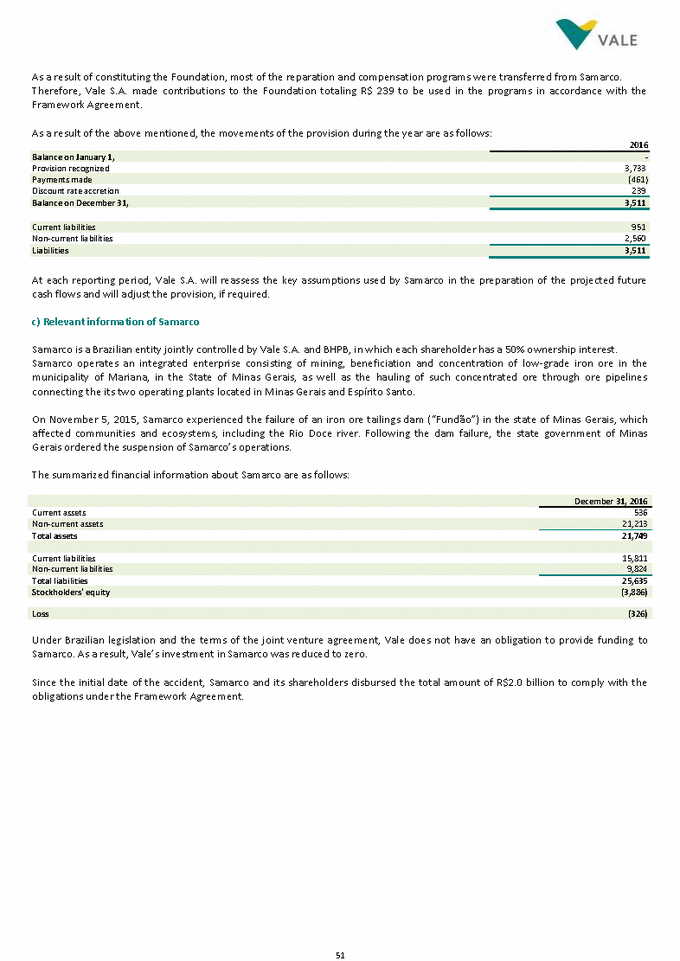
d) Contingencies related to Samarco accident (i) Public civil claim filed by the Federal Government and others The federal government, the two Brazilian states affected by the failure (Espirito Santo and Minas Gerais) and other governmental authorities have initiated a public civil lawsuit against Samarco and its shareholders, Vale S.A. and BHPB, with an estimated value indicated by the plaintiffs of R$20.2 billion. On May 5, 2016, the Framework Agreement, which was signed on March 2, 2016, was ratified by the Federal Regional Court (“TRF” ), 1st Region. In June 2016 the Superior Court of Justice (“STJ”) in Brazil issued an interim order, suspending the decision of TRF, which ratified the Framework Agreement until the final judgments of the claim. On August 17, 2016, the TRF of the 1st Region rejected the appeal presented by Samarco, Vale S.A. and BHPB against the interim order and overruled the judicial decision that ratified the Framework Agreement. This decision of the TRF of the 1st Region, among other measures, confirmed a prior injunction that prohibited the defendants from transferring or co nveying any of their interest in its Brazilian iron ore concessions, without, however, limiting their production and commercial activities and ordered a deposit with the court of R$1.2 billion by January 2017. This R$1.2 billion cash deposit was provisionally replaced by the guarantees provided for under the agreements with MPF, as described below. In January 2017 Samarco, Vale S.A. and BHPB entered into two preliminary agreements with the Federal Prosecutor’s Office in B razil (MPF). The first agreement (“First Agreement”) aims to outline the process and timeline for negotiations of a Final Agreement (“Final Agreement”), expected to occur by June 30th, 2017. This First Agreement sets the ground for conciliation of two public civil actions which aim to establish socio-economic and socio-environmental remediation and compensation programs for the impacts of the Fundão dam failure, respectively: claim nº 023863-07.2016.4.01.3800, filed by the Federal Prosecutors (amounting to R$155 billion), as mentioned in item (ii) below, and claim nº 0069758-61.2015.4.01.3400, filed by the Federal Government, the states of Minas Gerais and Espírito Santo and other governmental authorities (amounting to R$20.2 billion). Both claims were filed with the 12th Judicial Federal Court of Belo Horizonte. The First Agreement provides for: (i) the appointment of experts selected by the Federal Prosecutors and paid for by the companies to conduct a diagnosis and follow the progress of the 41 programs under the Framework Agreement signed on March 2nd, 2016 by the companies and the Federal Government and the states of Minas Gerais and Espírito Santo and other governmental authorities and (ii) holding at least eleven public hearings by April 15th, 2017, five of which are to be held in Minas Gerais, three in Espírito Santo and the remainder in the indigenous territories of the Krenak, Comboios and Caieiras Velhas, in order to allow these communities to take part in the definition of the content of the Final Agreement. Under the First Agreement, Samarco, Vale S.A. and BHPB will provide the 12th Judicial Federal Court of Belo Horizonte with a guarantee for fulfillment of the obligations regarding the financing and payment of the socio -environmental and socio-economic remediation programs resulting from the Fundão dam failure, pursuant to the two public civil actions, until the signing of the Final Agreement, amounting to R$2.2 billion, of which (i) R$100 in financial investments; ii) R$1.3 billion in insurance bonds; and (iii) R$800 in assets of Samarco. The guarantee will remain in place until the completion of the negotiations for the Final Agreement or until June 30th, 2017, whichever comes first. In order to implement the First Agreement, it has been requested that the 12th Judicial Federal Court of Belo Horizonte accept such guarantees until the completion of the negotiations and the signing of the Final Agreement, or until the parties reach a new agreement regarding the guarantees. If, by June 30th, the negotiations have not been completed, the Federal Prosecutor’s Office may require that the 12th Judicial Federal Court of Belo Horizonte re-institute the order for the deposit of R$1.2 billion in relation to the R$20.2 billion public civil action, which is currently suspended. In addition, the Second Agreement (Second Agreement) was signed, which establishes a timetable to make funds available to remediate the social, economic and environmental damages caused by the Fundão dam failure in the municipalities of Barra Lon ga, Rio Doce, Santa Cruz do Escalvado and Ponte Nova, amounting to R$200. The terms of the two Agreements are subject to ratification by the courts. 52
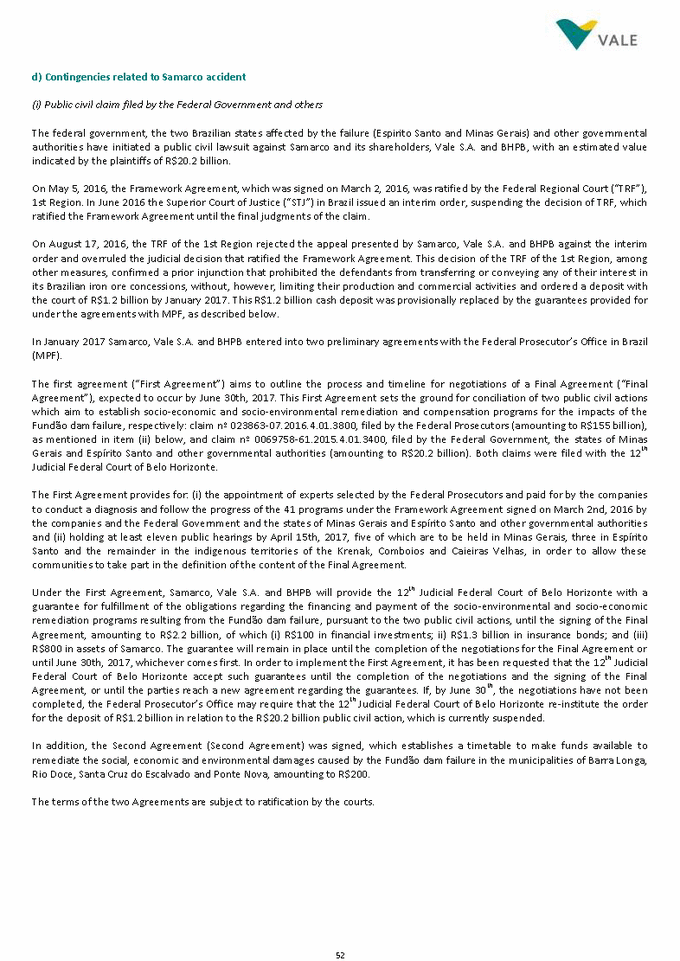
(ii) Public civil action filed by Federal Prosecution Office On May 3, 2016, the Federal Prosecution Office (MPF) filed a public civil action against Samarco and its shareholders and pre sented several demands, including: (i) the adoption of measures for mitigating the social, economic and environmental impacts resul ting from the Fundão dam failure and other emergency measures; (ii) the payment of compensation to the community; and (iii) payments for the collective moral damage. The initial action value claimed by the Federal Prosecution Office (MPF) is R$155 b illion. The first conciliatory hearing was held on September 13, 2016. On November 21, 2016, the court ordered that the defendants be served, and the defendants submitted their defense. Given the negotiations of a potential settlement, the parties jointly requested the suspension of the proceeding, in accordance with the First Agreement. (iii) U.S. Securities class action suits On May 2, 2016, Vale S.A. and certain of its officers were named as defendants in securities class action suits in the Federal Court in New York brought by holders of Vale’s American Depositary Receipts under U.S. federal securities laws. The lawsuits allege th at Vale S.A. made false and misleading statements or omitted to make disclosures concerning the risks and dangers of the operations of Samarco's Fundão dam and the adequacy of related programs and procedures. The plaintiffs have not specified an amount of alleged damages in these actions. Vale S.A. intends to vigorously and fully defend itself against the allegations. The litigation is at an early stage. On March 7, 2016, the judge overseeing the securities class actions issued an order consolidating these actions and designating lead plaintiffs and counsel. On April 29, 2016, lead plaintiffs filed a Consolidated Amended Complaint that will serve as the operative complaint in the litigation. In July 2016, Vale S.A. and the individual defendants filed a motion to dismiss th e Amended Complaint. In August 2016, the plaintiffs submitted their opposition to the motion to dismiss, to which the defendants replied in September 2016. The decision on the motion to dismiss remains pending. (iv) Criminal lawsuit On October 20, 2016, the MPF brought a criminal lawsuit in the Brazilian Federal Justice Court against Vale S.A., BHPB, Samarco, VogBr Recursos Hídricos e Geotecnia Ltda. and 22 individuals for alleged crimes against the environment, urban planning and cultural heritage, flooding, landslide, as well as for alleged crimes against the victims of the Fundão dam failure. On November 16, 2016, the judge received the Federal Prosecutors Office criminal lawsuit and determined the summons of all defendants, granting 30 days each to file their defenses, to count from the day they receive the summon . Vale has already been served and its deadline to present its defense is March 3, 2017. (v) Other lawsuits In addition, Samarco and its shareholders were named as a defendant in several other lawsuits brought by individuals, corpora tions and governmental entities seeking personal and property damages. These lawsuits and petitions are at early stages, so it is not possible to determine a range of outcomes or reliable estimates of the potential exposure at this time. No contingent liability has been quantified and no provision was recognized for lawsuits rel ated to Samarco´s dam failure. Critical accounting estimates and judgments The provision requires the use of assumptions that may be mainly affected by: (i) changes in scope of work required under the Framework Agreement as result of further technical analysis, (ii) resolution of uncertainty in respect of the resume the Samarco´s operation; (iii) updates in the discount rate; and (iv) resolution of existing and potential legal claims. As a result, futur e expenditures may differ from the amounts currently provided and changes to key assumptions could result in a material impact to the amount of the provision in future reporting periods. 53
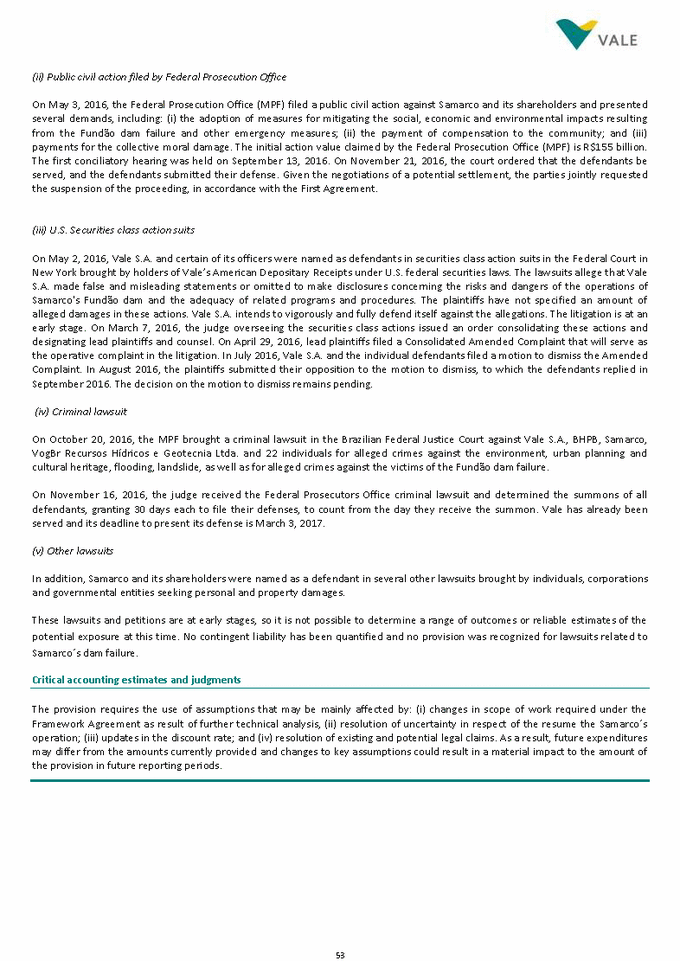
22. Risk management Vale considers that an effective risk management is key to support the achievement of the company objectives and to ensure the financial strength and flexibility of the company and the business continuity. Therefore, Vale has developed its risk management strategy in order to provide an integrated approach o f the risks the company is exposed to, considering not only the risks generated by variables traded in financial markets (market risk) and those arising from liquidity risk, but also the risk from counterparties obligations (credit risk) and those relating to inadequate or failed internal processes, people, systems or external events (operational risk), among others. a) Risk management policy The Board of Directors established a corporate risk management policy defining principles and guidelines applicable t o this process in the company and the corresponding governance structure. This policy determines that corporate risks should be measured and monitored, regularly, in an integrated manner, in order to ensure that the company overall risk level remains aligned with its strategic guidelines. The Executive Risk Management Committee, created by the Board of Directors, is responsible for supporting the Executive Board in the risk management decisions, issuing opinions and recommendations. It is also responsible for the supervision and revision of the principles and instruments of corporate risk management. The Executive Board is responsible for the approval of the policy deployment into norms, rules and responsibilities and for r eporting to the Board of Directors about such procedures. The risk management norms and instructions complement the corporate risk management policy and define practices, processes, controls, roles and responsibilities. The Company may, when necessary, allocate specific risk limits to management activities, including but not limited to, market risk limit, corporate and sovereign credit limit, in accordance with the acceptable corporate risk limit. b) Liquidity risk management The liquidity risk arises from the possibility that Vale might not perform its obligations on due dates, as well as face diff iculties to meet its cash requirements due to market liquidity constraints. See note 20 "Loans, borrowing and cash and cash equivalents" for details on the Group's liquidity risk. c) Credit risk management Vale’s exposure to credit risk arises from trade receivables, derivative transactions, guarantees, down payment for suppliers and cash investments. Our credit risk management process provides a framework for assessing and managing counterparties’ credit risk and for maintaining our risk at an acceptable level. (i) Commercial credit risk management See note 10 "Accounts receivables" for details on commercial credit risk. (ii) Treasury credit risk management To manage the credit exposure arising from cash investments and derivative instruments, credit limits are approved to each counterparty with whom we have credit exposure. Furthermore, we control the portfolio diversification and monitor different indicators of solvency and liquidity of the diffe rent counterparties that were approved for trading. d) Market risk management Vale is exposed to the behavior of several market risk factors that can impact its cash flow. The assessment of this potential impact arising from the volatility of risk factors and their correlations is performed periodically to support the decision making p rocess regarding the risk management strategy, that may incorporate financial instruments, including derivatives. 54
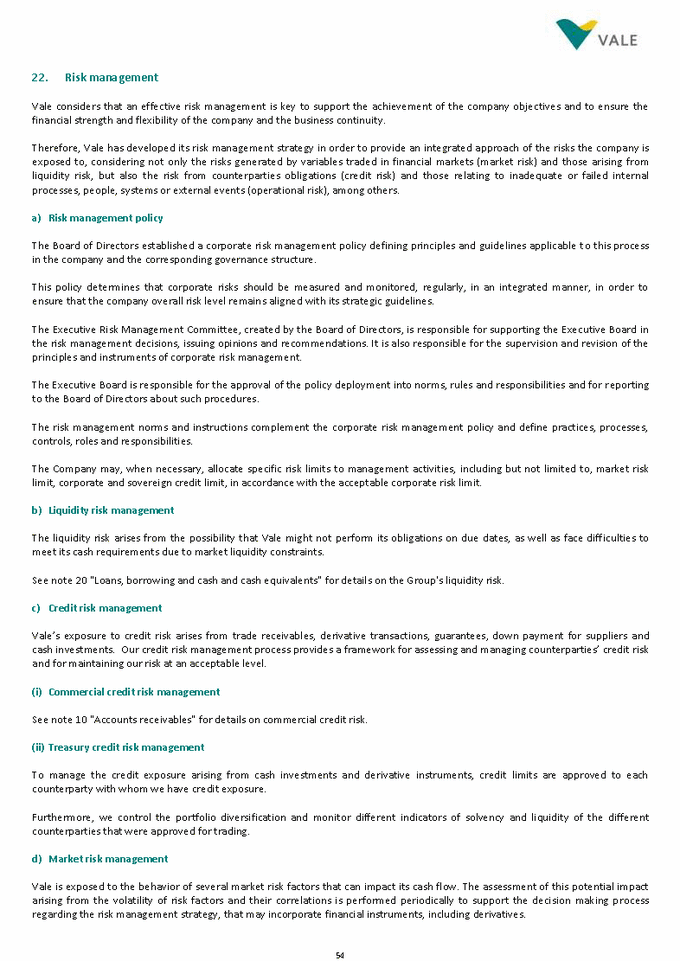
The portfolio of these financial instruments is monitored on a monthly basis, enabling financial results surveillance and its impact on cash flow. Considering the nature of Vale’s business and operations, the main market risk factors which the Company is exposed to are: • Foreign exchange and interest rates; • Product prices and input costs. e) Foreign exchange and interest rate risk The company’s cash flow is subjected to volatility of several currencies, as its product are predominantly priced in US dolla r, while most of the costs, disbursements and investments are denominated in other currencies, mainly Brazilian real and Canadian d ollar. In order to reduce the potential impact that arises from this currency mismatch, derivatives instruments may be used as a ris k mitigation strategy. Vale implements hedge transactions to protect its cash flow against the market risks that arises from its debt obligations – mainly currency volatility. The hedges cover most of the debts in Brazilian reais and euros. We use swap and forward transactions to convert debt linked to Brazilian real and Euros into US dollar, with volumes, flows and settlem ent dates similar to those of the debt instruments - or sometimes lower, subject to market liquidity conditions. Hedging instruments with shorter settlement dates are renegotiated through time so that their final maturity matches - or becomes closer - to the debts` final maturity. At each settlement date, the results of the swap and forward transactions partially offset the impact of the foreign exchange rate in Vale’s obligations, contributing to stabilize the cash disbursements in US dollar. Vale has also exposure to interest rates risks over loans and financings. The US Dollar floating rate debt in the portfolio consists mainly of loans including export pre-payments, commercial banks and multilateral organizations loans. In general, such debt instruments are indexed to the LIBOR (London Interbank Offer Rate) in US dollar. We take advantage of the potential correlation between commodity prices and U.S. dollar floating interest rates as a partial natural hedge for our cash flow. f) Risk of product and input prices Vale is also exposed to market risks including commodities price and input price volatilities. In accordance with risk manage ment policy, risk mitigation strategies involving commodities can be used to adjust the cash flow risk profile and reduce Vale’s cash flow volatility. For this kind of risk mitigation strategy, Vale uses predominantly forwards, futures or zero -cost collars. g) Operational risk management The operational risk management is the structured approach that Vale uses to manage uncertainty related to possible inadequate or failure in internal processes, people, systems and external events, in accordance with the principles and guidelines of ISO 31000. The main operational risks are periodically monitored, ensuring the effectiveness of preventive and mitigating key controls in place and the execution of the risk treatment strategy (implementation of new or improved controls, changes in the risk environment , risk sharing by contracting insurance, provisioning of resources, etc.). Therefore, the Company seeks to have a clear view of its major risks, the best cost -benefit mitigation plans and the effectiveness of the controls in place, monitoring the potential impact of operational risk and allocating capital efficiently. h) Capital management The Company's policy aims at establishing a capital structure that will ensure the continuity of your business in the long term. Within this perspective, the Company has been able to deliver value to stockholders through dividend payments and capital gain, and at the same time maintain a debt profile suitable for its activities, with an amortization well distributed over the years, thus avoiding a concentration in one specific period. 55
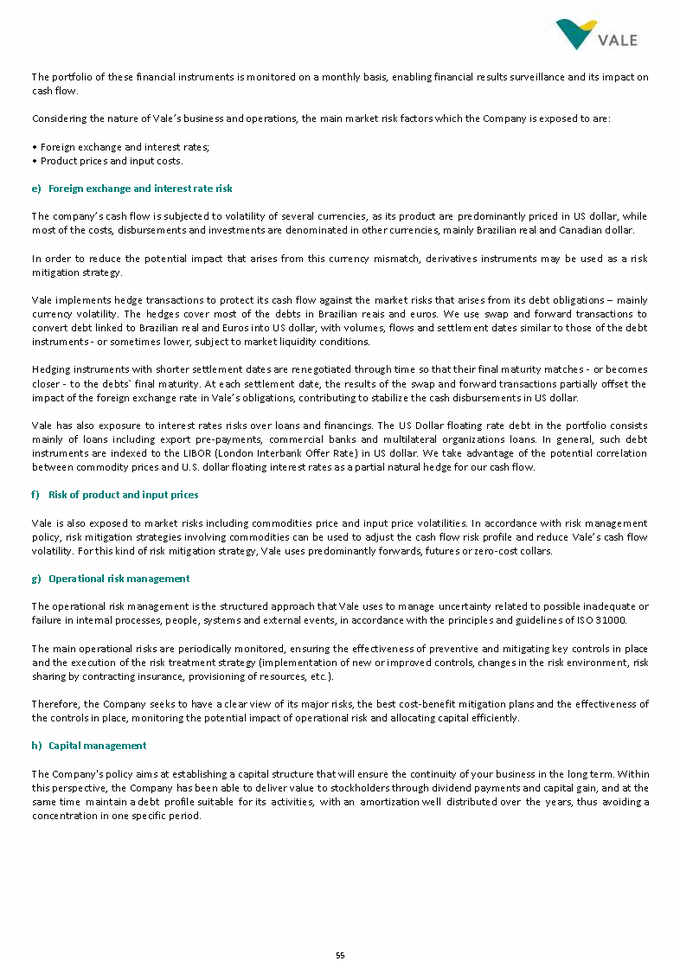
i) Insurance Vale contracts several types of insurance policies, such as operational risk policy, engineering risks insurance (projects), civil responsibility, life insurance policy for their employees, among others. The coverage of these policies is similar to the one s used in general by the mining industry and is issued in line with the objectives defined by the Company, with the corporate risk management policy and the limitation imposed by the insurance and reinsurance global market. In general, the company's assets directly related with its operations are included in the coverage of insurance policies. Insurance management is performed with the support of existing insurance committees in the various operational areas of the Company. Among the management instruments, Vale uses captive reinsurance to balance the price on reinsurance contracts with the market, as well as, enable direct access to key international markets of insurance and reinsurance. 23. Financial instruments classification The Company classifies its financial instruments in accordance with the purpose for which they were acquired, and determines the classification and initial recognition according to the following categories: December 31, 2016 December 31, 2015 Current 13,891 Financial investments 59 - 59 109 - - 109 Accounts receivable 11,937 - 11,937 5,763 - - 5,763 273 26,120 892 27,012 20,167 474 - 20,641 Derivative financial instruments - 1,454 1,454 - 363 - 363 Related parties 5 - 5 5 - - 5 Total of financial assets 26,712 2,346 29,058 20,904 837 - 21,741 Financial liabilities Suppliers and contractors 11,830 - 11,830 13,140 - - 13,140 Loans and borrowings 5,410 - 5,410 9,788 - - 9,788 1,856 19,430 1,349 20,779 24,784 7,909 198 32,891 Derivative financial instruments - 3,991 3,991 - 6,132 - 6,132 Related parties 415 - 415 830 - - 830 1,336 90,569 6,517 97,086 103,708 7,468 - 111,176 56 Total of financial liabilities 109,999 7,866 117,865 128,492 15,377 198 144,067 1,336 - - 2,526 2,526 Participative stockholders' debentures 102,878 - - 102,878 90,154 - 90,154 Loans and borrowings Non-current - - 1,856 - 2,190 2,190 Related parties 8,107 198 7,909 - 1,349 1,349 - Derivative financial instruments Current 592 1,454 2,046 737 363 - 1,100 732 - - 732 587 - 587 Loans Non-current - - 273 - 233 233 Related parties 474 - 474 - 892 892 - Derivative financial instruments 14,022 - - 14,022 - 13,891 Cash and cash equivalents Derivatives designated as hedge accounting Loans and receivables or amortized cost At fair value through net income Loans and receivables or amortized cost At fair value through net income Financial assets Total Total Consolidated
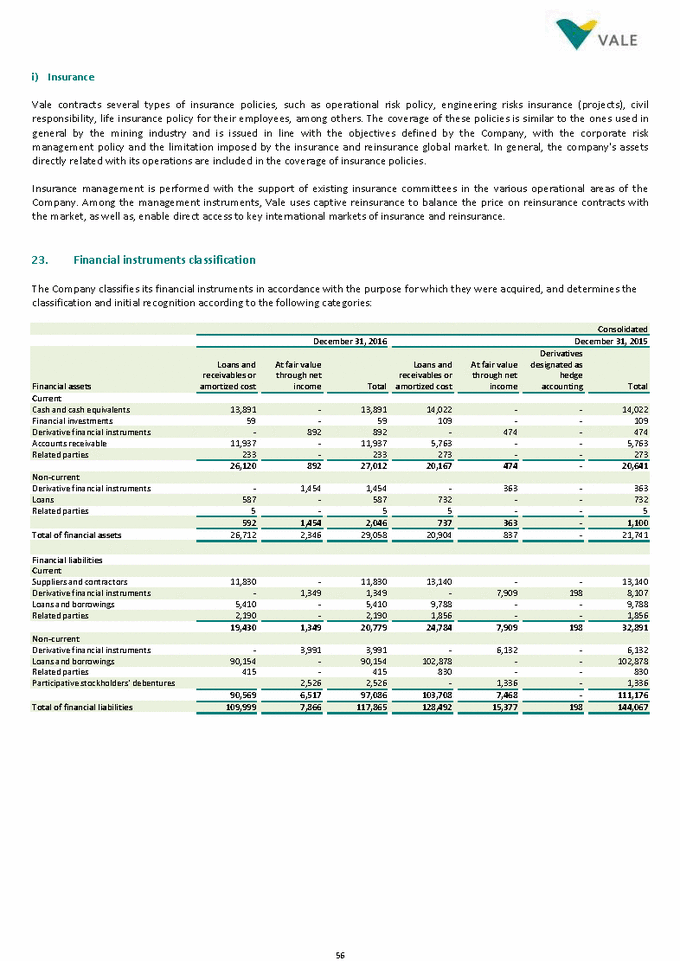
December 31, 2016 December 31, 2015 Current Financial investments 4 - 4 18 - 18 Accounts receivable 26,223 - 26,223 36,026 - 36,026 28,319 338 28,657 37,396 196 37,592 Derivative financial instruments - 1,304 1,304 - 293 293 Related parties 760 - 760 1,468 - 1,468 Total of financial assets 29,193 1,642 30,835 38,970 489 39,459 Financial liabilities Suppliers and contractors 6,743 - 6,743 7,084 - 7,084 Loans and borrowings 4,171 - 4,171 4,736 - 4,736 20,726 1,033 21,759 18,594 3,559 22,153 Derivative financial instruments - 3,427 3,427 - 5,296 5,296 Related parties 53,728 - 53,728 63,837 - 63,837 101,605 5,953 107,558 119,823 6,632 126,455 The classification of financial assets and liabilities by currencies are as follows: December 31, 2016 Current Financial investments 4 55 - - - - 59 - 892 Accounts receivable 1,098 10,787 - - 3 49 11,937 Related parties 233 - - - - - 233 4,806 20,843 147 81 186 949 27,012 Non-current Derivative financial instruments 1,304 150 - - - - 1,454 Loans 114 313 160 - - - 587 Related parties 5 - - - - - 5 1,423 463 160 - - - 2,046 Total of assets 6,229 21,306 307 81 186 949 29,058 Financial liabilities Current Suppliers and contractors 6,181 3,090 1,995 23 313 228 11,830 Derivative financial instruments 1,033 316 - - - - 1,349 Loans and borrowings 2,450 2,696 55 - 209 - 5,410 Related parties 1,040 1,150 - - - - 2,190 10,704 7,252 2,050 23 522 228 20,779 Non-current Derivative financial instruments 3,427 564 - - - - 3,991 Loans and borrowings 19,128 64,498 681 - 5,847 - 90,154 Related parties 415 - - - - - 415 Participative stockholders' debentures 2,526 - - - - - 2,526 25,496 65,062 681 - 5,847 - 97,086 Total of liabilities 36,200 72,314 2,731 23 6,369 228 117,865 57 - - - 553 339 Derivative financial instruments 13,891 900 183 81 147 9,448 3,132 Cash and cash equivalents Others currencies Financial assets R$ US$ CAD AUD EUR Total Consolidated Total of financial liabilities 122,331 6,986 129,317 138,417 10,191 148,608 1,336 1,336 - 2,526 2,526 Participative stockholders' debentures 55,986 - 55,986 47,877 - 47,877 Loans and borrowings Non-current 6,774 - 6,774 9,812 - 9,812 Related parties 3,559 3,559 - 1,033 1,033 - Derivative financial instruments Current 874 1,304 2,178 1,574 293 1,867 106 - 106 114 - 114 Loans Non-current 834 - 834 889 - 889 Related parties 196 196 - 338 338 - Derivative financial instruments 518 - 518 1,203 - 1,203 Cash and cash equivalents Loans and receivables or amortized cost At fair value through net income Loans and receivables or amortized cost At fair value through net income Financial assets Total Total Parent Company
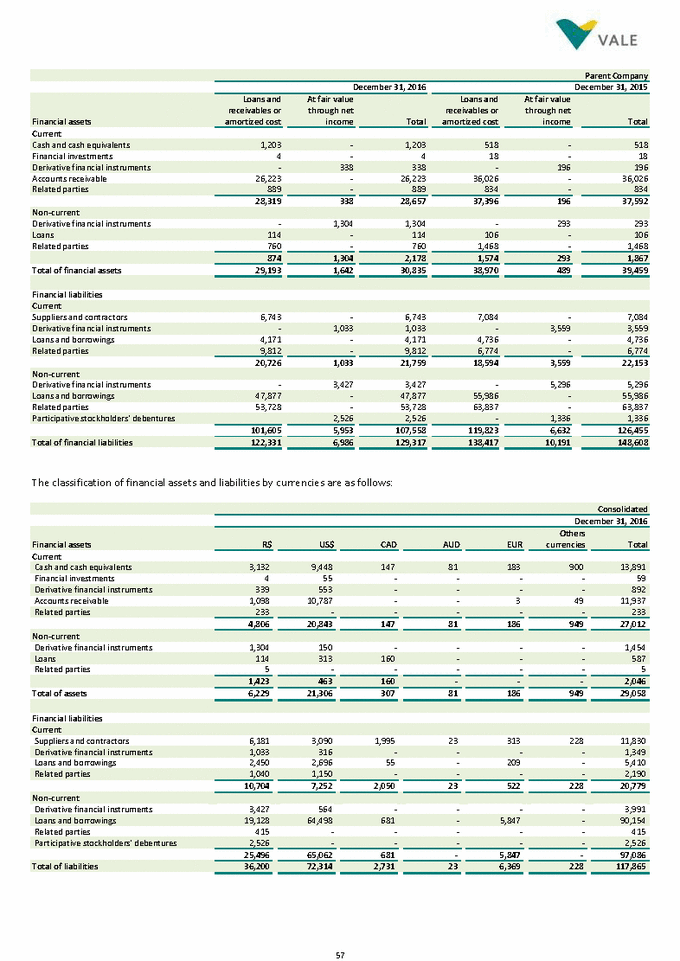
December 31, 2015 Current Financial investments - 109 - - - - 109 Accounts receivable 980 4,232 488 39 16 8 5,763 273 4,635 14,490 535 250 59 672 20,641 Derivative financial instruments 293 70 - - - - 363 Related parties 5 - - - - - 5 Total of assets 5,038 14,961 761 250 59 672 21,741 Financial liabilities Suppliers and contractors 5,853 5,424 1,308 35 449 71 13,140 Loans and borrowings 1,696 7,779 55 - 258 - 9,788 1,856 12,962 17,753 1,363 35 707 71 32,891 Derivative financial instruments 5,296 836 - - - - 6,132 Related parties 811 19 - - - - 830 1,336 27,385 76,758 644 15 6,374 - 111,176 December 31, 2016 Current Financial investments 4 - - - 4 Accounts receivable (1,355) 27,572 - 6 26,223 889 856 27,795 - 6 28,657 Non-current Derivative financial instruments 1,304 - - - 1,304 Loans 114 - - - 114 Related parties - 760 - - 760 1,418 760 - - 2,178 Total of assets 2,274 28,555 - 6 30,835 Financial liabilities Current Suppliers and contractors 5,992 603 1 147 6,743 Derivative financial instruments 1,033 - - - 1,033 Loans and borrowings 2,149 1,815 - 207 4,171 Related parties 131 9,681 - - 9,812 9,305 12,099 1 354 21,759 Non-current Derivative financial instruments 3,427 - - - 3,427 Loans and borrowings 17,993 24,726 - 5,158 47,877 Related parties 3,694 50,034 - - 53,728 Participative stockholders' debentures 2,526 - - - 2,526 27,640 74,760 - 5,158 107,558 Total of liabilities 36,945 86,859 1 5,512 129,317 58 - - 205 684 Related parties 338 - - - 338 Derivative financial instruments 1,203 - - 18 1,185 Cash and cash equivalents Financial assets R$ US$ AUD EUR Total Parent Company Total of liabilities 40,347 94,511 2,007 50 7,081 71 144,067 - - - - - 1,336 Participative stockholders' debentures 102,878 - 6,374 15 644 75,903 19,942 Loans and borrowings Non-current - - - - - 1,856 Related parties 8,107 - - - - 4,550 3,557 Derivative financial instruments Current 403 471 226 - - - 1,100 732 - - - 226 401 105 Loans Non-current - - - - - 273 Related parties 474 - - - - 278 196 Derivative financial instruments 14,022 664 43 211 47 9,871 3,186 Cash and cash equivalents Others currencies Financial assets R$ US$ CAD AUD EUR Total Consolidated
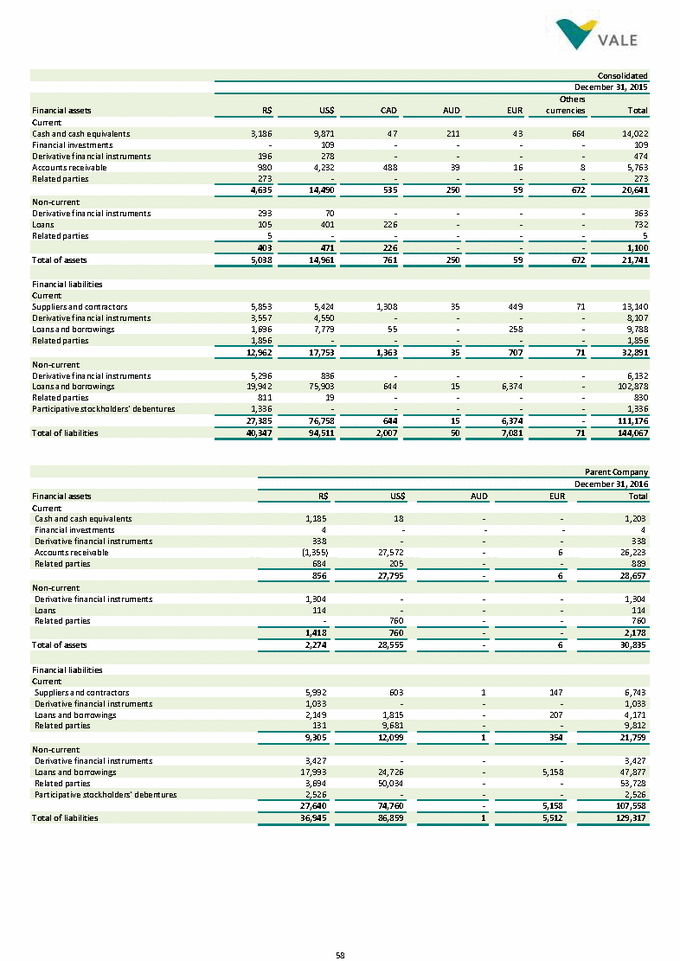
December 31, 2015 Current Financial investments 18 - - - 18 Accounts receivable (609) 36,628 - 7 36,026 704 36,881 - 7 37,592 Derivative financial instruments 293 - - - 293 Related parties 337 1,131 - - 1,468 Total of assets 1,440 38,012 - 7 39,459 Financial liabilities Suppliers and contractors 6,148 806 6 124 7,084 Loans and borrowings 1,595 3,141 - - 4,736 12,470 9,548 10 125 22,153 Derivative financial instruments 5,296 - - - 5,296 Related parties 3,912 59,925 - - 63,837 29,078 90,745 - 6,632 126,455 24. Fair value estimate Due to the short-term cycle, it is assumed that the fair value of cash and cash equivalents balances, financial investments, a ccounts receivable and accounts payable approximate their book values. For the measurement and determination of fair value, the Company uses various methods including market, income or cost approaches, in order to estimate the value that market participants would use when pricing the asset or liability. The financial assets and liabilities recorded at fair value are classified and disclosed in accordance with the following levels: Level 1 – unadjusted quoted prices on an active, liquid and visible market for identical assets or liabilities that are accessible at t he measurement date; Level 2 - quoted prices (adjusted or unadjusted) for identical or similar assets or liabilities on active markets; and Level 3 - assets and liabilities, for which quoted prices, do not exist, or where prices or valuation techniques are supported by littl e or no market activity, unobservable or illiquid. a) Assets and liabilities measured and recognized at fair value: December 31, 2016 December 31, 2015 Financial assets Total 1,319 1,027 2,346 837 - 837 Financial liabilities Participative stockholders' debentures 2,526 - 2,526 1,336 - 1,336 59 Total 6,403 1,463 7,866 15,024 551 15,575 14,239 551 13,688 5,340 1,463 3,877 Derivative financial instruments 837 - 837 2,346 1,027 1,319 Derivative financial instruments Level 2 Level 3 Total Level 2 Level 3 Total Consolidated Total of liabilities 41,548 100,293 10 6,757 148,608 1,336 - - - 1,336 Participative stockholders' debentures 55,986 6,632 - 30,820 18,534 Loans and borrowings Non-current 6,774 1 4 5,601 1,168 Related parties 3,559 - - - 3,559 Derivative financial instruments Current 736 1,131 - - 1,867 106 - - - 106 Loans Non-current 834 - - 228 606 Related parties 196 - - - 196 Derivative financial instruments 518 - - 25 493 Cash and cash equivalents Financial assets R$ US$ AUD EUR Total Parent Company
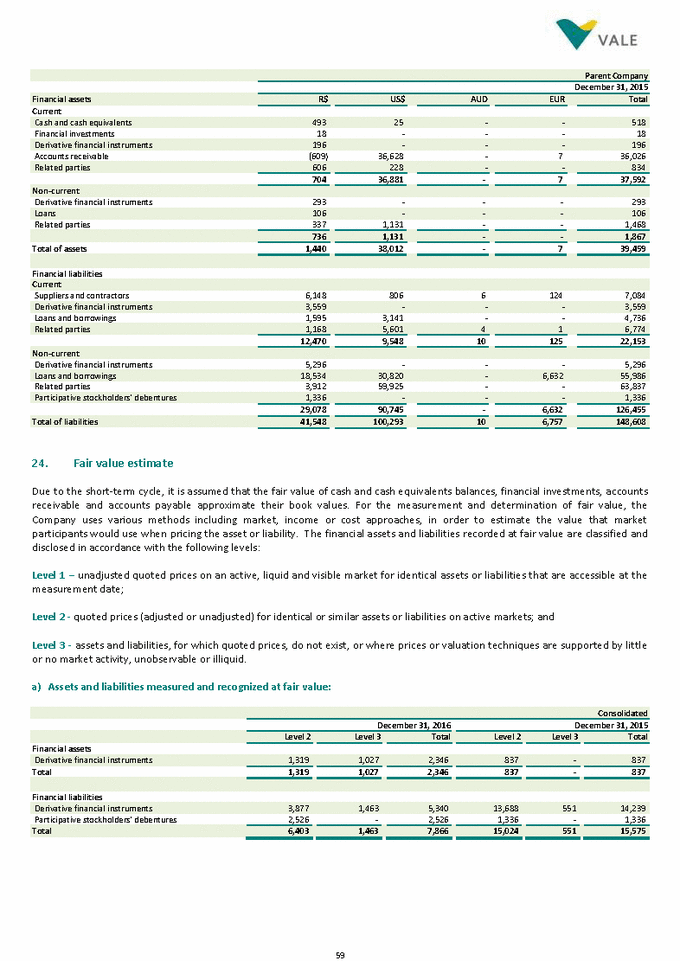
December 31, 2016 December 31, 2015 Financial assets Total 615 1,027 1,642 489 - 489 Financial liabilities Participative stockholders' debentures 2,526 - 2,526 1,336 - 1,336 Methods and techniques of evaluation i) Derivative financial instruments Financial instruments are evaluated by calculating their present value through yield curves at the closing dates. The curves and prices used in the calculation for each group of instruments are detailed in the "market curves”. The pricing method used for European options is the Black & Scholes model. In this model, the fair value of the derivative is a function of the volatility in the price of the underlying asset, the exercise price of the option, the interest rate and peri od to maturity. In the case of options which income is a function of the average price of the underlying asset over the period of the option, the Company uses Turnbull & Wakeman model. In this model, in addition to the factors that influence the option price in the Black-Scholes model, the formation period of the average price is also considered. In the case of swaps, both the present value of the assets and liability are estimated by discounting the cash flow by the in terest rate of the currency in which the swap is denominated. The difference between the present va lue of the assets and the liabilities generates its fair value. For to the Long Term Interest Rate (“TJLP”) swaps, the calculation of the fair value assumes that TJLP is constant, and the projections of future cash flow in Brazilian Reais are made on the basis of the last TJLP disclosed. Contracts for the purchase or sale of products, inputs and costs of selling with future settlement are priced using the forwa rd yield curves for each product. Typically, these curves are obtained on the stock exchanges wh ere the products are traded, such as the London Metals Exchange (“LME”), the Commodity Exchange (“COMEX”) or other providers of market prices. When there is no price for the desired maturity, Vale uses an interpolation between the available maturities. The fair value for derivatives classified in level 3 are measured using discounted cash flows and option model valuation techni ques with main unobservable inputs discount rates, stock prices and commodities prices. ii) Participative stockholders’ debentures - Consist of the debentures issued during the privatization process (note 32(b)), wh ich fair values are measured based on the market approach. Reference prices are available on the secondary market. Critical accounting estimates and judgments The fair values of financial instruments that are not traded in active markets are determined using valuation techniques. Vale uses its own judgment to choose between the various methods. Assumptions are based on the market conditions, at the end of the yea r. An analysis of the impact if actual results are different from management's estimates is present on note 33 (sensibility analysis). b) Fair value of financial instruments not measured at fair value The fair value estimate for level 1 is based on market approach considering the secondary market contracts. For loans allocated to level 2, the income approach is adopted and the fair value for both fixed-indexed rate debt and floating rate debt is determined on a discounted cash flows basis using LIBOR future values and Vale’s bonds curve. 60 Total 5,523 1,463 6,986 9,640 551 10,191 8,855 551 8,304 4,460 1,463 2,997 Derivative financial instruments 489 - 489 1,642 1,027 615 Derivative financial instruments Level 2 Level 3 Total Level 2 Level 3 Total Parent Company
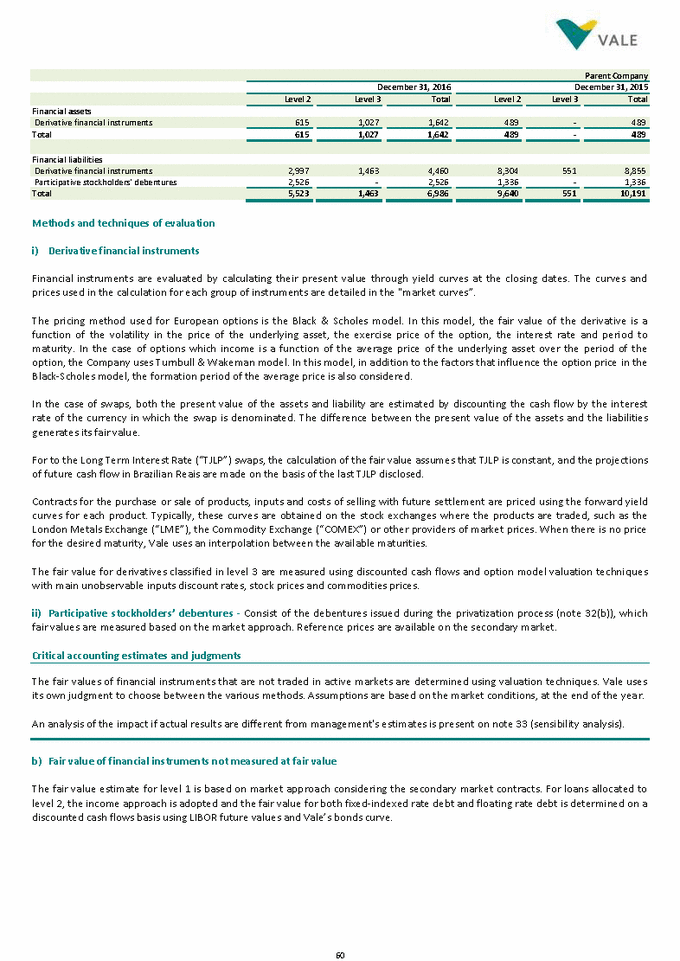
The fair values and carrying amounts of non-current loans (net of interest) are as follows: Financial liabilities Balance Fair value Level 1 Level 2 Balance Fair value Level 1 Level 2 Debt principal 93,508 89,218 45,216 44,002 50,691 50,658 12,166 38,492 December 31, 2015 25. Derivative financial instruments a) Derivatives effects on statement of financial position Consolidated December 31, 2016 December 31, 2015 Derivatives not designated as hedge accounting CDI & TJLP vs. US$ fixed and floating rate swap 429 3 269 - Pré-dolar swap 3 75 - - Commodities price risk Bunker oil 425 - - - - 1,170 - 258 Consolidated December 31, 2016 December 31, 2015 Derivatives not designated as hedge accounting CDI & TJLP vs. US$ fixed and floating rate swap 955 2,078 3,119 4,419 Eurobonds swap 24 147 572 111 Pre dollar swap 16 104 364 280 Commodities price risk Bunker oil 124 - 3,609 - - 1,469 - 887 Bunker oil - - 198 - - - 208 - 61 Total 1,349 3,991 8,107 6,132 - 10 - - Foreign exchange Derivatives designated as cash flow hedge accounting 887 - - 1,469 Others 140 7 3,762 42 42 153 7 16 Nickel 1,209 2,515 4,137 5,203 - - - 149 Euro Forward 393 82 186 65 IPCA swap Foreign exchange and interest rate risk Current Non-current Current Non-current Liabilities Total 892 1,454 474 363 258 - - 1,170 Others 438 7 198 41 41 198 7 13 Nickel 454 277 276 64 64 7 199 22 IPCA swap Foreign exchange and interest rate risk Current Non-current Current Non-current Assets 46,444 11,783 58,227 59,585 54,417 48,017 102,434 110,231 Debt principal December 31, 2016 Parent Company Consolidated
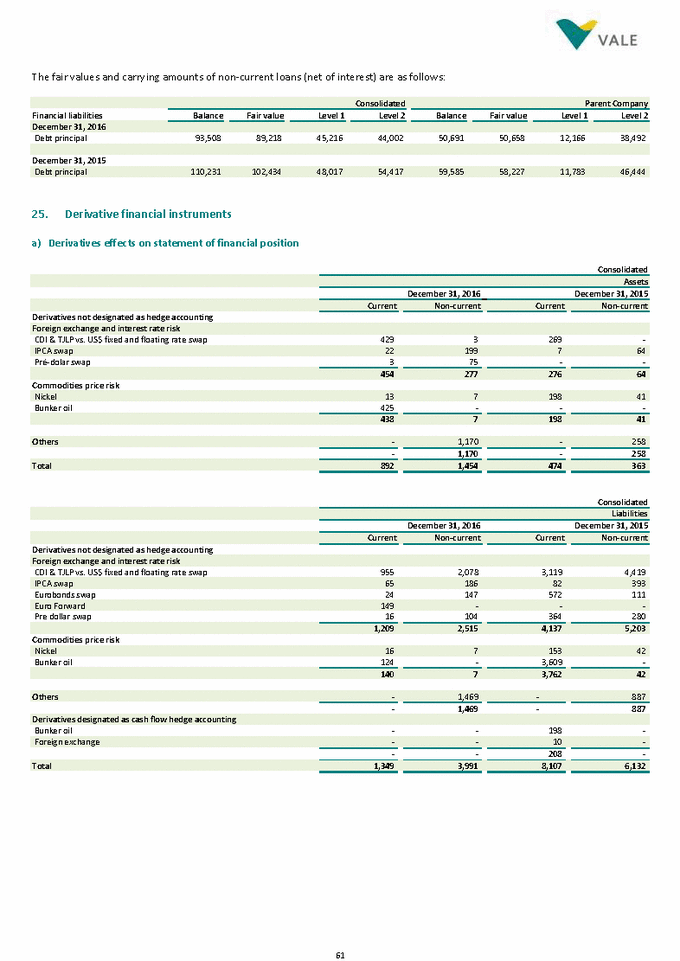
Parent Company December 31, 2016 December 31, 2015 Derivatives not designated as hedge accounting CDI & TJLP vs. US$ fixed and floating rate swap 322 3 193 - Pré-dolar swap 3 75 - - - 1,027 - 229 Parent Company December 31, 2016 December 31, 2015 Derivatives not designated as hedge accounting CDI & TJLP vs. US$ fixed and floating rate swap 952 1,777 3,112 3,943 Pre dollar swap 16 104 365 280 - 1,463 - 887 b) Effects of derivatives on the income statement, cash flow and other comprehensive income Consolidated Gain (loss) recognized in the income statement Financial settlement inflows(outflows) Gain(loss) recognized in other comprehensive income Derivatives not designated as hedge accounting CDI & TJLP vs. US$ fixed and floating rate swap 2,897 (3,644) (1,160) (1,689) (867) (51) - - - Eurobonds swap (75) (353) (385) (524) (39) 24 - - - Pre dollar swap 241 (462) (73) (361) (158) 16 - - - Commodities price risk Bunker oil 911 (2,662) (1,372) (2,829) (866) (236) - - - Bunker oil - (1,483) (203) - (1,513) (203) - 1,409 (1,067) Foreign exchange (10) (136) (100) (10) (136) (100) 10 66 27 (10) (1,619) (303) (10) (1,649) (303) 10 1,475 (1,040) Total 4,172 (9,567) (3,424) (5,604) (3,771) (521) 10 1,475 (1,040) 62 Derivatives designated as cash flow hedge accounting - - - - - - (10) (494) 261 Others 753 (2,828) (1,351) (2,942) (1,078) (207) - - - - - - 29 (212) (113) 21 (166) (158) Nickel 3,168 (4,626) (1,760) (2,652) (1,044) (11) - - - - - - - - - - - (152) Euro forward - - - - 20 (78) (142) (167) 257 IPCA swap Foreign exchange and interest rate risk 2016 2015 2014 2016 2015 2014 2016 2015 2014 Year ended December 31 Total 1,033 3,427 3,559 5,296 887 - 1,463 - Others 1,033 1,964 3,559 4,409 186 82 83 65 IPCA swap Foreign exchange and interest rate risk Current Non-current Current Non-current Liabilities Total 338 1,304 196 293 229 - 1,027 - Others 338 277 196 64 64 3 199 13 IPCA swap Foreign exchange and interest rate risk Current Non-current Current Non-current Assets
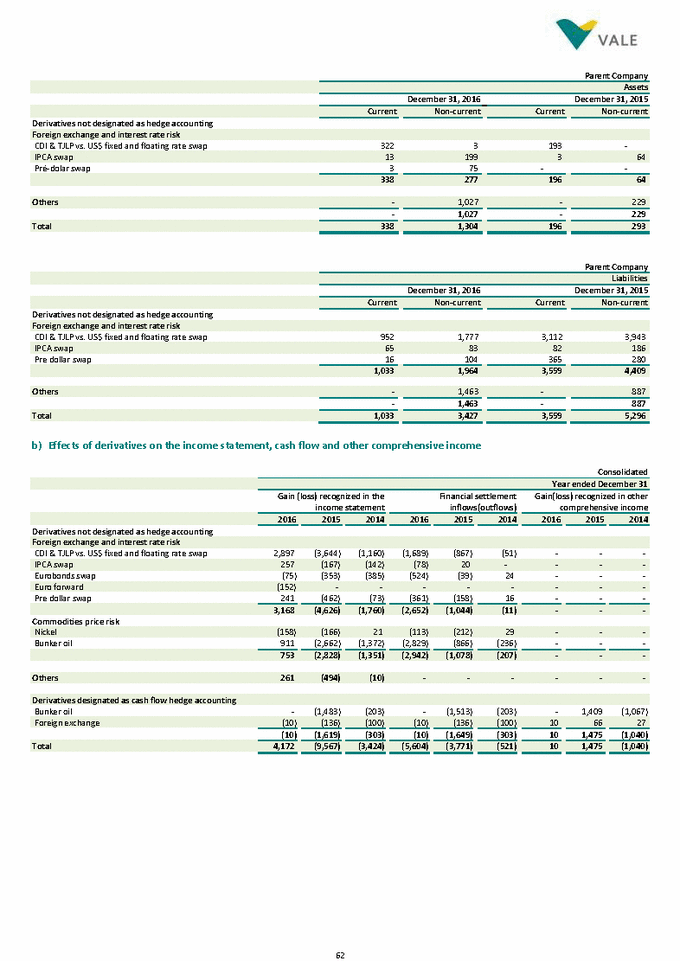
Parent Company Gain (loss) recognized in the income statement Financial settlement inflows(outflows) Gain(loss) recognized in other comprehensive income Derivatives not designated as hedge accounting CDI & TJLP vs. US$ fixed and floating rate swap 2,685 (3,467) (1,773) (622) - - Pre dollar swap 241 (465) (361) (158) - - Bunker oil - - - - - 1,409 - - - - 10 1,475 During 2015, the Company implemented bunker oil purchase cash flows protection program and recognized as cost of goods sold and services rendered and financial expense the amounts of R$1,483 and R$8,084, respectively. In 2016, all derivatives impacts were charged to financial results. The maturity dates of the derivative financial instruments are as follows: Currencies and interest rates July 2023 Nickel December 2018 Accounting policy Derivatives transactions which are not qualified as hedge accounting are presented as economic hedge, as the Company uses derivative instruments to manage its financial risks as a way of hedging against these risks. Derivative financial instrument s are recognized as assets or liabilities in the balance sheet and are measured at their fair values. Changes in the fair values of derivatives are recorded in income statement or in stockholders’ equity when the transaction is eligible to be characterized as effective hedge accounting. On the beginning of the hedge accounting operations, the Company documents the relationship between hedging instruments and hedged items with the objective of risk management and strategy for carrying out hedging operations. The Company also documents, both initially and on a continuously basis, that its assessment of whether the derivatives used in hedging transactions are highly effective. The effective components of changes in the fair values of derivative financial instruments designated as cash flow hedges are recorded as unrealized fair value gain or losses and recognized in stockholders’ equity; and their non-effective components recorded in income statement. The amounts recorded in the statement of comprehensive income, will only be transferred to income statement (costs, operating expenses or financial expenses) when the hedged item is actually realized. 63 December 2027 Others December 2017 Bunker oil Last maturity dates Total 3,333 (4,477) (2,215) (769) 10 1,475 66 10 - - - - Foreign exchange Derivatives designated as cash flow hedge accounting - - - - (413) 222 Others 3,111 (4,064) (2,215) (769) - - - - 11 (81) (132) 185 IPCA swap Foreign exchange and interest rate risk 2016 2015 2016 2015 2016 2015 Year ended December 31
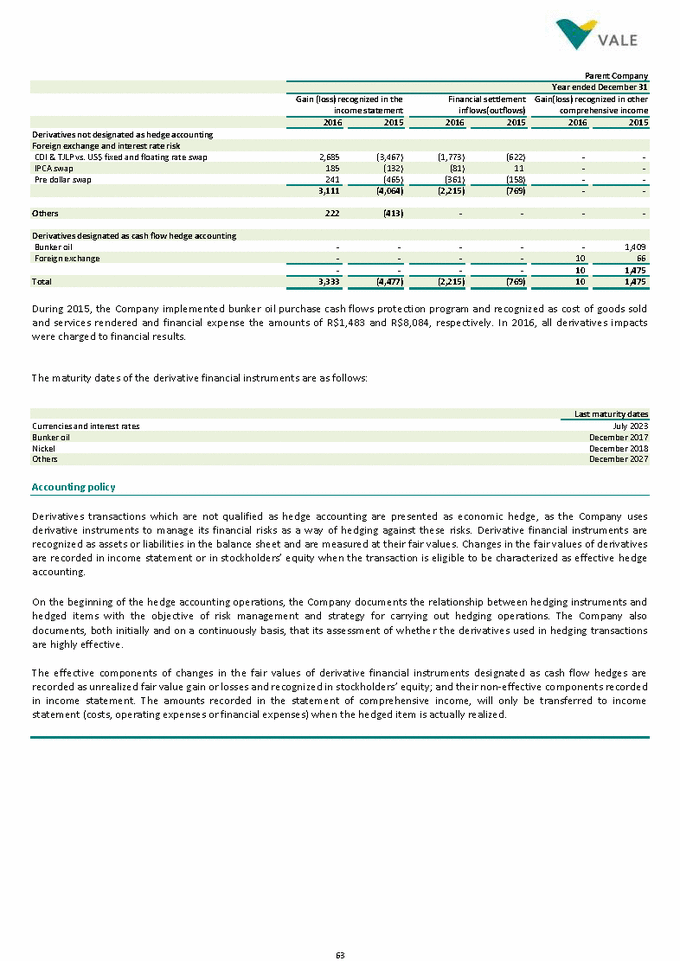
Additional information about derivatives financial instruments In millions of Brazilian reais, except as otherwise stated The risk of the derivatives portfolio is measured using the delta-Normal parametric approach, and considers that the future distribution of the risk factors and its correlations tends to present the same statistic properties verified in the historic al data. The value at risk estimate considers a 95% confidence level for a one-business day time horizon. There was no cash amount deposited as margin call regarding derivative positions on December 31, 2016. The derivative positio ns described in this document did not have initial costs associated. The following tables detail the derivatives positions for Vale and its controlled companies as of December 31, 2016, with the following information: notional amount, fair value including credit risk, gains or losses in the period, value at risk and th e fair value breakdown by year of maturity. a) Foreign exchange and interest rates derivative positions (i) Protection programs for the R$ denominated debt instruments In order to reduce cash flow volatility, swap transactions were implemented to convert into US$ the cash flows from certain d ebt instruments denominated in R$ with interest rates linked mainly to CDI, TJLP and IPCA. In those swaps, Vale pays fixed or floating rates in US$ and receives payments in R$ linked to the interest rates of the protected debt instruments. The swap transactions were negotiated over-the-counter and the protected items are the cash flows from debt instruments linked to R$. These programs transform into US$ the obligations linked to R$ to achieve a currency offset in the Company’s cash flow s, by matching its receivables - mainly linked to US$ - with its payables. Financial settlement Inflows (Outflows) Notional Fair value Value at Risk Fair value by year Receiva ble R$ 6.289 R$ 5.239 CDI 106,78% Receiva ble R$ 4.360 R$ 5.484 TJLP + 1,32% Receiva ble R$ 242 R$ 267 TJLP + 0,86% Receiva ble R$ 1.031 R$ 1.356 Fix 7,69% Receiva ble R$ 1.000 R$ 1.000 IPCA + 6,55% Receiva ble R$ 1.350 R$ 1.350 IPCA + 6,62% (ii) Protection program for EUR denominated debt instruments In order to reduce the cash flow volatility, swap and forward transactions were implemented to convert into US$ the cash flow s from certain debt instruments issued in Euros by Vale. In those swaps, Vale receives fixed rates in EUR and pays fixed rates in US$. And in those forwards only the principal amount of the debt is converted from EUR to US$. The swap and forward transactions were negotiated over-the-counter and the protected items are the cash flows from debt instruments linked to EUR. The financial settlement inflows/outflows are offset by the protected items’ losses/gains due to E UR/US$ exchange rate. Financial settlement Notional Fair value Inflows (Outflows) Value at Risk Fair value by year Receiva ble € 500 € 1.000 Fix 3,75% Financial settlement Inflows (Outflows) Fair value by year Notional Fair value Value at Risk 64 Forwa rd € 500 - B 1,143 (149) - - 19 (149) Bought / Average rate Flow December 31, 2016 December 31, 2015 Sold (USD/EUR) December 31, 2016 December 31, 2015 December 31, 2016 December 31, 2016 2017 Pa ya ble US$ 613 US$ 1.302 Fix 4,29% EUR fixed rate vs. US$ fixed rate swap (170) (683) (524) 32 (23) (21) (127) Flow December 31, 2016 December 31, 2015 Index Average rate December 31, 2016 December 31, 2015 December 31, 2016 December 31, 2016 2017 2018 2019+ Pa ya ble R$ 1.350 R$ 1.350 CDI 98,58% IPCA vs. CDI swap 137 6 (82) 1 (64) (27) 228 Pa ya ble US$ 434 US$ 434 Fix 3,98% IPCA vs. US$ fixed rate swap (167) (411) 4 36 23 19 (208) Pa ya ble US$ 343 US$ 528 Fix -0,73% R$ fixed rate vs. US$ fixed rate swap (42) (644) (361) 75 (12) 42 (73) Pa ya ble US$ 140 US$ 156 Libor + -1,23% TJLP vs. US$ floating rate swap (179) (245) (7) 15 (11) (15) (153) Pa ya ble US$ 2.030 US$ 2.611 Fix 1,69% TJLP vs. US$ fixed rate swap (2.026) (3.965) (709) 203 (675) (332) (1.019) Pa ya ble US$ 2.105 US$ 2.288 Fix 3,78% CDI vs. US$ fixed rate swap (396) (3.059) (973) 129 157 (553) - Flow December 31, 2016 December 31, 2015 Index Average rate December 31, 2016 December 31, 2015 December 31, 2016 December 31, 2016 2017 2018 2019+
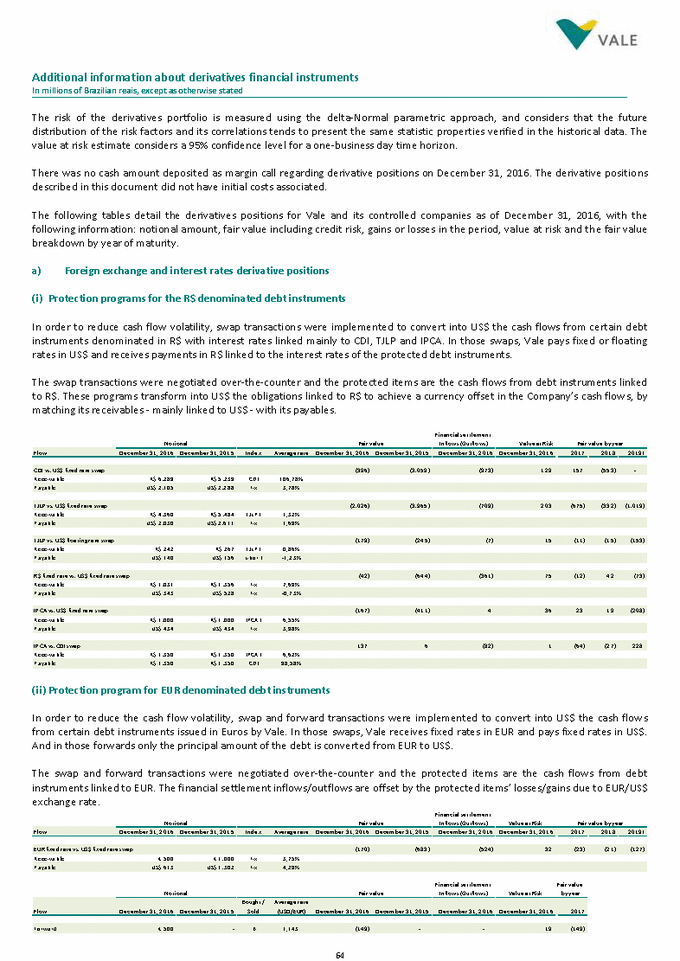
(iii) Foreign exchange hedging program for disbursements in CAD In order to reduce the cash flow volatility, forward transactions were implemented to mitigate the foreign exchange exposure that arises from the currency mismatch between revenues denominated in US$ and disbursements denominated in CAD. The forward transactions were negotiated over-the-counter and the protected item is part of the CAD denominated disbursements. The financial settlement inflows/outflows are offset by the protected items’ losses/gains due to CAD/US$ exchange rate. This program is classified under the hedge accounting requirements, and it was settled in the first quarter of 2016. Financial settlement Inflows (Outflows) Fair value by year Notional Fair value Value at Risk b)Commodities derivative positions (i) Bunker Oil purchase cash flows protection program In order to reduce the impact of bunker oil price fluctuation on maritime freight hiring/supply and, consequently, reducing t he company’s cash flow volatility, bunker oil derivatives were implemented. These transactions are usually executed through forw ard purchases and zero cost-collars. The derivative transactions were negotiated over-the-counter and the protected item is part of the Vale’s costs linked to bunker oil prices. The financial settlement inflows/outflows are offset by the protected items’ losses/gains due to bunker oil prices changes. Financial Settlement Inflows (Outflows) Fair value by year Notional (ton) Fair value Value at Risk Put options 2.856.000 2.041.500 S 213 (45) (1.158) (603) 10 (45) As at December 31, 2016 and 2015, excludes R$78 and R$397, respectively, of transactions in which the financial settlement occurs subsequently of the closing month. (ii) Protection programs for base metals raw materials and products In the operational protection program for nickel sales at fixed prices, derivatives transactions were implemented to convert into floating prices the contracts with clients that required a fixed price, in order to keep nickel revenu es exposed to nickel price fluctuations. Those operations are usually implemented through the purchase of nickel forwards. In the operational protection program for the purchase of raw materials and products, derivatives transactions were implement ed, usually through the sale of nickel and copper forward or futures, in order to reduce the mismatch between the pricing period of purchases (concentrate, cathode, sinter, scrap and others) and the pricing period of the final product sales to the clients. The derivative transactions are negotiated at London Metal Exchange or over-the-counter and the protected item is part of Vale’s revenues and costs linked to nickel and copper prices. The financial settlement inflows/outflows are offset by the protected items’ losses/gains due to nickel and copper prices changes. Financial Settlement Inflows (Outflows) Notional (ton) Fair value Value at Risk Fair value by year Nickel forwa rds 11.615 16.917 B 10.156 (2) (180) (98) 12 (10) 9 Raw materials purchase protection Copper forwa rds 441 385 S 5.207 (0,5) 0,4 0,1 0,2 (0,5) - 65 Total (0,1) 0,7 (0,1) - Nickel forwa rds 134 118 S 10.823 0,4 0,4 (0,6) 0,1 0,4 - Fixed prices sales protection Bought / Average strike Flow December 31, 2016 December 31, 2015 Sold (US$/ton) December 31, 2016 December 31, 2015 December 31, 2016 December 31, 2016 2017 2018 Total 379 (3.410) 379 Bunker Oil protection Forwa rds 0 1.867.500 B 0 - (2.252) (1.747) - - Ca ll options 2.856.000 2.041.500 B 324 424 0 - 93 424 Bought / Average strike Flow December 31, 2016 December 31, 2015 Sold (US$/ton) December 31, 2016 December 31, 2015 December 31, 2016 December 31, 2016 2017 Forwa rd - CAD 10 B 1,028 - (12) (10) - - Bought / Average rate Flow December 31, 2016 December 31, 2015 Sold (CAD / USD) December 31, 2016 December 31, 2015 December 31, 2016 December 31, 2016 2017
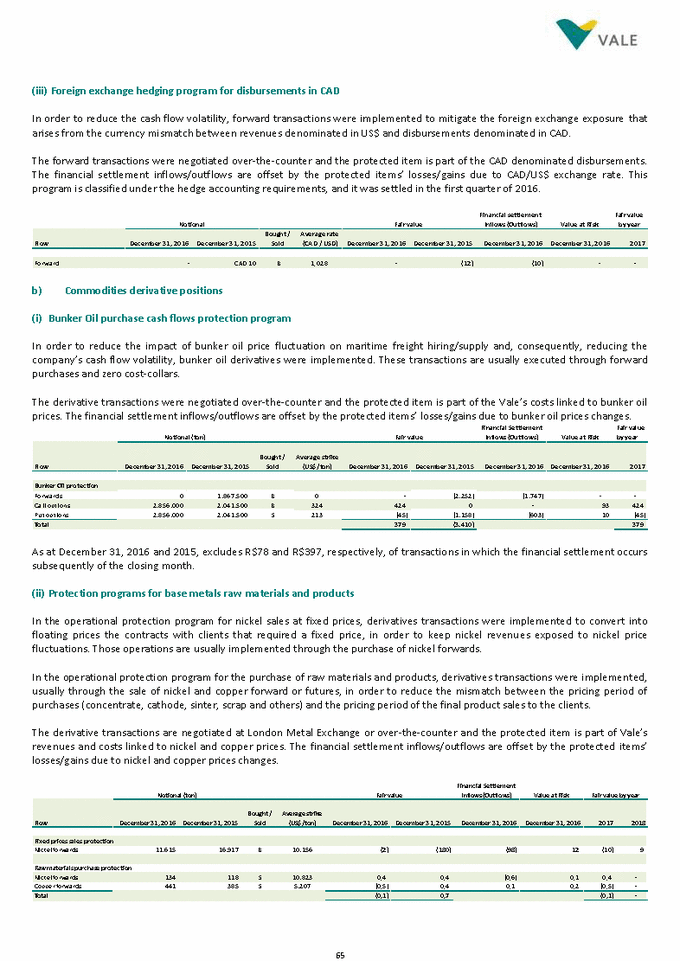
c) Silver Wheaton Corp. warrants The company owns warrants of Silver Wheaton Corp. (SLW), a Canadian company with stocks negotiated in Toronto Stock Exchange and New York Stock Exchange. Such warrants configure American call options and were received as part of the payment regarding the sale of part of gold payable flows produced as a sub product from Salobo copper mine and some nickel mines in Sudbury. Financial Settlement Inflows (Outflows) Fair value by year Notional (quantity) Fair value Value at Risk d) Call options from debentures The company has debentures in which lenders have call options of a specified quantity of Ferrovia Norte Sul ordinary shares, later changed to VLI SA shares. The call option’s strike price is given by the debentures’ remaining notional in each exercise date. Financial Settlement Inflows (Outflows) Fair value by year Notional (quantity) Fair value Value at Risk e) Options related to Minerações Brasileiras Reunidas S.A. (“MBR”) shares The Company entered into a contract that has options related to MBR shares. Under certain restrict and contingent conditions, which are beyond the buyer’s control, such as illegality due to changes in the law, the contract has a clause that gives the buyer the right to sell back its stake to the Company. It this case, the Company could settle through cash or shares. On the other hand , the Company has the right to buy back this non-controlling interest in the subsidiary. Financial Settlement Inflows (Outflows) Fair value by year Notional (quantity, in millions) Fair value Value at Risk f) Embedded derivatives in contracts The Company has some nickel concentrate and raw materials purchase agreements in which there are provisions based on nickel and copper future prices behavior. These provisions are considered as embedded derivatives. Financial Settlement Inflows (Outflows) Fair value by year Notional (ton) Fair value Value at Risk Copper Forwa rd 3.684 5.939 S 5.249 5,0 7,7 5,0 The Company has also a natural gas purchase agreement in which there is a clause that defines that a premium can be charged if the Company’s pellet sales prices trade above a pre-defined level. This clause is considered an embedded derivative. Financial Settlement Inflows (Outflows) Notional (volume/month) Fair value Value at Risk Fair value by year In August 2014 the Company sold part of its stake in VLI to an investment fund managed by Brookfield Asset Management ("Brookfield"). The sales contract includes a clause that establishes, under certain conditions, a minimum return guarantee on Brookfield's investment. This clause is considered an embedded derivative, with payoff equivalent to that of a put option and estimated pricing based on our own model and assumptions. 66 Ca ll options 746.667 746.667 S 179 (6,5) - - 4,1 (0,1) (6,5) Bought / Average strike Flow December 31, 2016 December 31, 2015 Sold (US$/ton) December 31, 2016 December 31, 2015 December 31, 2016 December 31, 2016 2017 2018+ Total 6,1 19,4 - 8,1 6,1 Nickel Forwa rd 5.626 3.877 S 10.950 1,1 11,7 1,1 Bought / Average strike Flow December 31, 2016 December 31, 2015 Sold (US$/ton) December 31, 2016 December 31, 2015 December 31, 2016 December 31, 2016 2017 Options 2.139 2.139 B/S 1,8 393 57 - 37 393 Bought / Average strike Flow December 31, 2016 December 31, 2015 Sold (R$/ação) December 31, 2016 December 31, 2015 December 31, 2016 December 31, 2016 2017+ Ca ll options 140.239 140.239 S 8.419 (236) (152) - 15 (236) Bought / Average strike Flow December 31, 2016 December 31, 2015 Sold (R$/share) December 31, 2016 December 31, 2015 December 31, 2016 December 31, 2016 2027 Ca ll options 10.000.000 10.000.000 B 44 143 28 - 15 143 Bought / Average strike Flow December 31, 2016 December 31, 2015 Sold (US$/share) December 31, 2016 December 31, 2015 December 31, 2016 December 31, 2016 2023
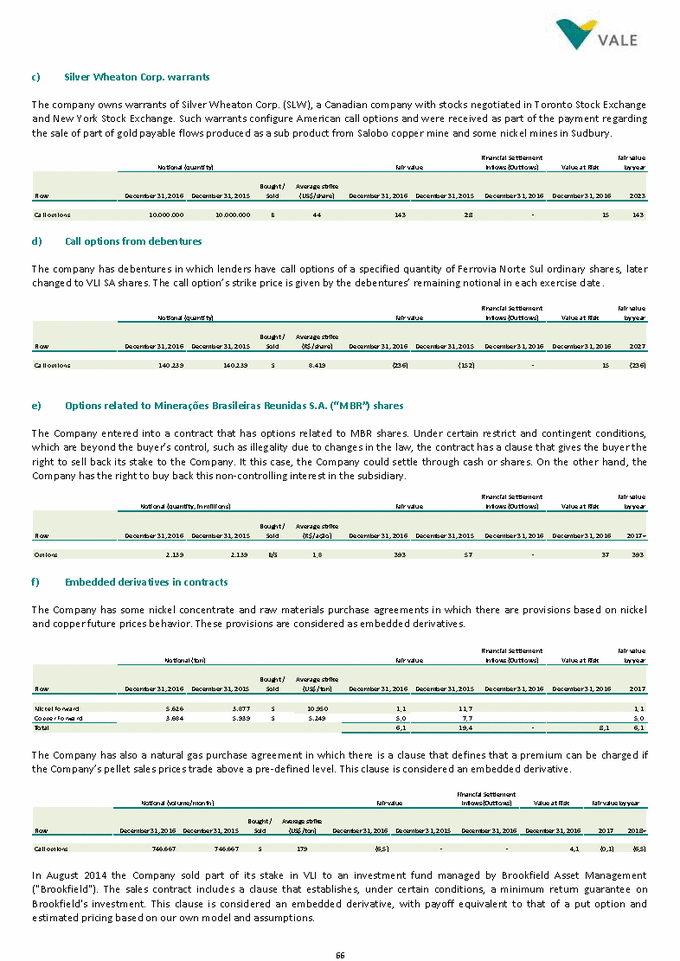
Financial Settlement Inflows (Outflows) Fair value by year Notional (quantity) Fair value Value at Risk For sensitivity analysis of derivative financial instruments, Financial counterparties’ ratings and market curves please see note 33. 26. Provisions Consolidated December 31, 2016 December 31, 2015 December 31, 2016 December 31, 2015 Environment Restoration 33 83 362 318 Asset retirement obligations (note 27) 154 346 8,055 9,313 Employee postretirement obligations (note 29) 225 266 6,038 6,831 Current liabilities Non-current liabilities Payroll and related charges (i) 1,649 806 - - Asset retirement obligations (note 27) 71 83 1,571 1,291 Employee postretirement obligations (note 29) 58 72 681 483 (i) Includes profit sharing provision R$1,064 and R$147 for the year ended December, 31 2016 and 2015, respectively. For the Parent Company, R$638 and R$106 for the year ended December 31, 2016 and 2015, respectively. 27. Asset retirement obligations Refers to the costs for the closure of the mines and deactivation of the related mining assets. Changes in the provision of asset retirement obligations and long-term interest rates (per annum, used to discount these obligations to present value and to update the provisions) are as follows: Consolidated Parent Company Balance at beginning of the year 9,659 8,949 1,374 3,195 Settlements (264) (298) (12) (12) Translation adjustment (1,160) 1,318 - - Balance at end of the year 8,209 9,659 1,642 1,374 Current 154 346 71 83 8,209 9,659 1,642 1,374 Long-term interest rates (per annum) Canada 0.55% 0.59% 67 1.12% - 5.91% 1.07% - 8.02% Other regions 7.28% 5.73% 7.28% 5.73% Brazil 1,291 1,571 9,313 8,055 Non-current Effect of discontinued operations Transfer to net assets held for sale (1,168) - - - (1,944) 97 (524) 737 Revisions on cash flows estimates Interest expense 405 214 183 135 December 31, 2016 December 31, 2015 December 31, 2016 December 31, 2015 Provisions 1,792 1,012 4,396 4,103 2,190 1,944 - - Provisions for litigation (note 28) 139 200 51 14 Environment Restoration December 31, 2016 December 31, 2015 December 31, 2016 December 31, 2015 Parent Company Provisions 3,103 2,159 18,730 20,867 3,210 2,734 - - Provisions for litigation (note 28) 1,195 1,541 - 329 Onerous contracts (note 19) Payroll and related charges (i) 2,362 1,464 - - Current liabilities Non-current liabilities Bought / Average strike Flow December 31, 2016 December 31, 2015 Sold (R$/share) December 31, 2016 December 31, 2015 December 31, 2016 December 31, 2016 2018+ Put option 1.105.070.863 1.105.070.863 S 3,07 (593) (551) - 45 (593)
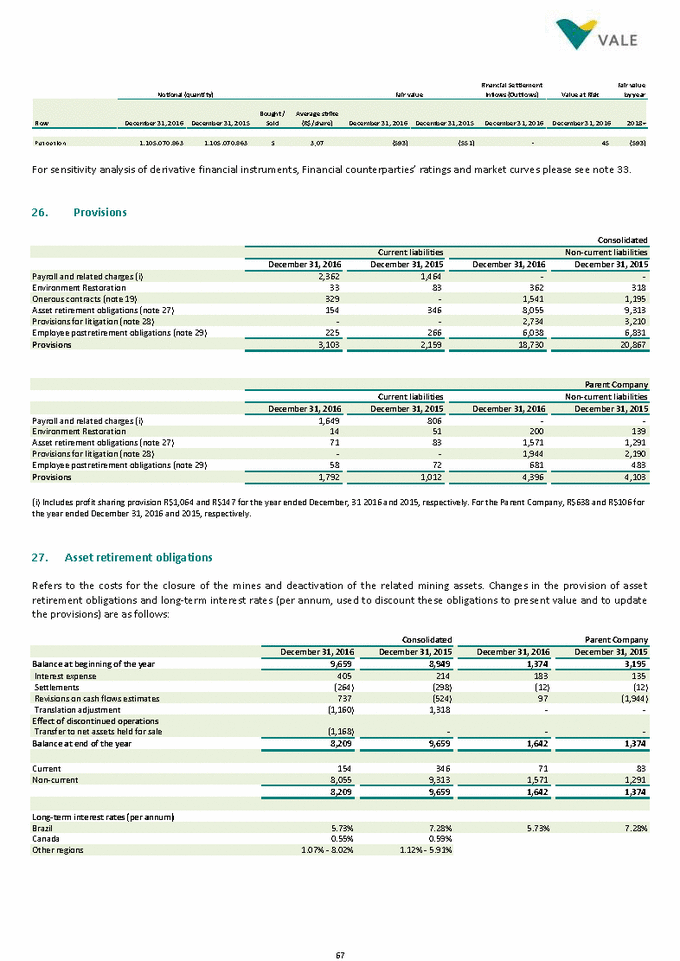
Accounting policy The provision refers to costs related to mine closure and reclamation, with the completion of mining activities and decommiss ioning of assets related to mine. When the provision is recognized, the corresponding cost is capitalized as part of property plant and equipment and is depreciated on the same basis over the related asset and recorded in the income statement. The long-term liability is subsequently measured using a long-term risk free discount rate applicable to the liability and recorded in the income statement as financial expenses until the Company makes payments related to mine closure and decommissioning of assets mining. The accrued amounts of these obligations are not deducted from the potential costs covered by insurance or indemnities. Critical accounting estimates and judgments The Company applies judgment and assumptions when measuring its asset retirement obligation. The Company recognizes an obligation under the fair value for asset retirement obligations in the period in which they occur. The Company considers the accounting estimates related to closure costs of a mine as a critical accounting policy because they involve significant values for the provision and are estimated using several assumptions, such as interest rate, cost of closure useful life of the asset considering the current state of closure and the projected date of depletion of each mine. The estimates are reviewed annually. 28. Litigation a) Provision for litigation Vale is party to labor, civil, tax and other ongoing lawsuits, at administrative and court levels. Provisions for losses resu lting from lawsuits are estimated and updated by the Company, based on analysis from the Company’s legal consultants. Changes in provision for litigation are as follows: Environmental litigation Total of litigation provision Tax litigation Civil litigation Labor litigation Additions 511 193 534 2 1,240 Payments (151) (129) (225) (215) (720) Translation adjustment 127 1 - 50 178 Balance at December 31, 2015 1,052 309 1,771 78 3,210 Reversals (127) (224) (412) (20) (783) Indexation and interest 155 68 28 (10) 241 Effect of discontinued operations Transfers to net assets held for sale (60) (11) (142) (19) (232) 68 Balance at December 31, 2016 695 272 1,742 25 2,734 23 (1) 28 (5) 1 Net movements of year 1 1 2 - (2) Translation adjustment (996) (11) (363) (212) (410) Payments Additions 86 347 830 7 1,270 64 - 23 36 5 Additions and reversals of discontinued operations 237 126 17 40 54 Indexation and interest (1,194) (15) (454) (143) (582) Reversals Balance at December 31, 2014 1,088 311 1,876 130 3,405 Consolidated
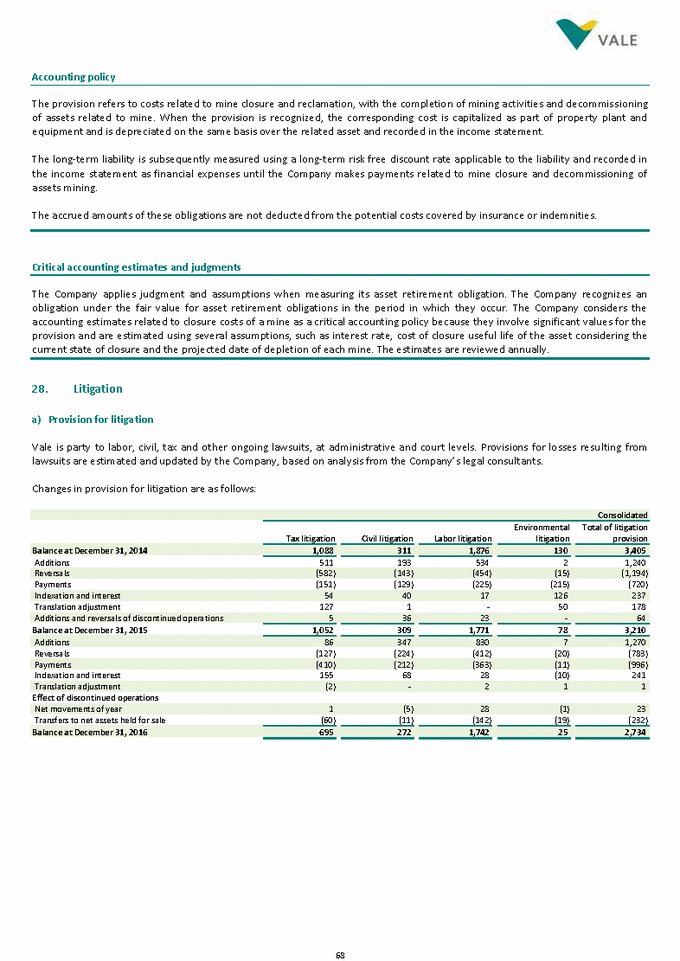
Parent Company Balance at December 31, 2014 436 186 1,732 94 2,448 Reversals (535) (139) (418) (14) (1,106) Indexation and interest Balance at December 31, 2015 217 28 (49) 7 203 332 241 1,562 55 2,190 Reversals (50) (202) (407) (19) (678) Indexation and interest 2 68 (1) (10) 59 i. Provisions for labor litigation - Consist of lawsuits filed by employees and service suppliers, related to employment relationships mainly in Brazil. The most recurring claims are related to payment of overtime, hours in itinerary, and health and safety. Al so the social security in Brazil (“INSS”) contingencies are related to legal and administrative disputes between INSS and Vale due to applicability of compulsory social security charges. b) Contingent liabilities Contingent liabilities of administrative and judicial claims, with expectation of loss classified as possible, and for which the recognition of a provision is not considered necessary by the Company, based on legal advice are as follows: Consolidated Parent Company Civil litigation 7,484 5,214 6,022 4,351 Environmental litigation 6,134 5,393 5,944 5,224 i - Tax litigation - Our most significant tax-related contingent liabilities result from disputes related to (i) the deductibility of our payments of social security contributions on the net income (CSLL) from our taxable income, (ii) challenges of certain tax credits we deducted from our PIS and COFINS payments, (iii) assessments of CFEM (royalties), and (iv) charges of value-added tax on services and circulation of goods (ICMS), especially relating to certain tax credits we claimed from the sale and transmission of energy, ICMS charges to anticipate the payment in the entrance of goods to Pará State, ICMS charges on our own transportation costs and challenges to other tax credits we claimed. The changes reported in the period resulted, mainly, from new proceedings related to PIS, COFINS, ICMS, CFEM; interest and inflation adjustments in the amounts in dispute. ii - Civil litigation - Most of those claims have been filed by suppliers for indemnification under construction contracts, primarily relating to certain alleged damages, payments and contractual penalties. A number of other claims related to contractual disp utes regarding inflation index. iii - Labor litigation - Represents individual claims by employees and service providers, primarily involving demands for additional compensation for overtime work, time spent commuting or health and safety conditions; and the Brazilian federal social securi ty administration (“INSS”) regarding contributions on compensation programs based on profits. iv - Environmental litigation - The most significant claims concern alleged procedural deficiencies in licensing processes, non-compliance with existing environmental licenses or damage to the environment. 69 Total 48,546 38,691 42,457 31,797 6,383 7,521 7,288 7,933 Labor litigation December 31, 2016 December 31, 2015 December 31, 2016 December 31, 2015 15,839 22,970 20,796 26,995 Tax litigation Balance at December 31, 2016 53 247 1,621 23 1,944 (829) (11) (337) (206) (275) Payments Additions 44 346 804 8 1,202 (408) (34) (211) (7) (156) Payments Additions 370 173 508 2 1,053 Environmental litigation Total of litigation provision Tax litigation Civil litigation Labor litigation
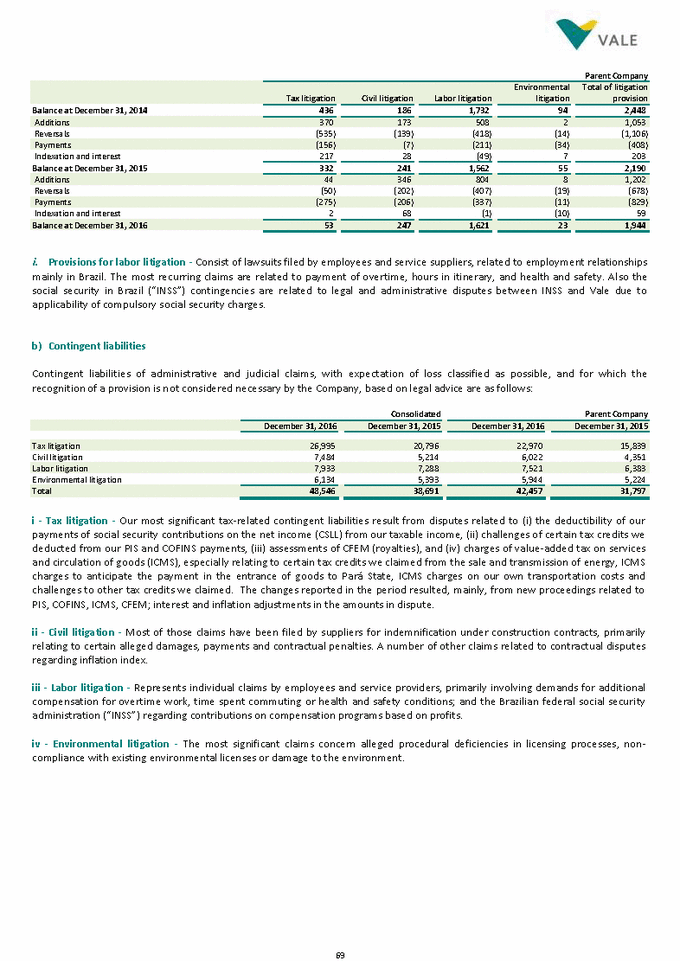
c) Judicial deposits In addition to the provisions and contingent liabilities, the Company is required by law to make judicial deposits to secure a potential adverse outcome of certain lawsuits. These court-ordered deposits are monetarily adjusted and reported as non-current assets until a judicial decision to draw the deposit occurs. December 31, 2016 December 31, 2015 December 31, 2016 December 31, 2015 Civil litigation 202 399 53 135 Environmental litigation 52 61 51 57 d) Others For contingencies related to Samarco Mineração S.A., see note 21. Accounting policy A provision is recognized when the obligation is considered probable and can be measured. The accounting counterpart for the obligation is an expense in income statement. This obligation is updated according to the evolution of the judicial process o r interest incurred and can be reversed if the estimate of loss is not considered probable or settled when the obligation is paid. Critical accounting estimates and judgments By their nature, litigations will be resolved when one or more future event occurs or fails to occur. Typically, the occurren ce or not of such events is outside the Company’s control. Legal uncertainties involve the exercise of significant estimates and judgments by management regarding the results of future events. 29. Employee benefits a) Employee postretirements obligations In Brazil, the management of the pension plans is responsibility of Fundação Vale do Rio Doce de Seguridade Social (“Valia”) a nonprofit entity with administrative and financial autonomy. The Brazilian plans are as follows: Benefit plan Vale Mais (“Vale Mais”) and benefit plan Valiaprev (“Valiaprev”) - Certain of the Company’s employees are participants of plans Vale Mais and Valiaprev with components of defined benefit (specific coverage for death, pensions and disability allowances) and components of defined contributions (for programmable benefits). The defined benefits plan is subj ect to actuarial evaluations. The defined contribution plan represents a fixed amount held on behalf of the participants. Both Vale Mais and Valiaprev were overfunded as at December 31, 2016 and 2015. Defined benefit plan (“Plano BD”) - The Plano BD has been closed to new entrants since the year 2000, when the Vale Mais plan was implemented. It is a plan that has defined benefit characteristics, covering almost exclusively retirees and their benefi ciaries. It was overfunded as of December 31, 2016 and 2015 and the contributions made by the Company are not relevant. Abono complementação benefit plan - The Company sponsors a specific group of former employees entitled to receive additional benefits from Valia normal payments plus post-retirement benefit that covers medical, dental and pharmaceutical assistance. The contributions made by the Company finished in 2014. The abono complementação benefit was overfunded as at December 31, 2016 and 2015. Other benefits - The Company sponsors medical plans for employees that meet specific criteria and for employees who use the abono complementação benefit. Although those benefits are not specific retirement plans, actuarial calculations are used to calculate future commitments. As those benefits are related to health care plans they have the nature of underfunded bene fits, and are presented as underfunded plans as at December 31, 2016 and 2015. 70 Total 3,135 3,445 2,681 2,707 1,984 2,078 2,163 2,251 Labor litigation Tax litigation 630 822 499 531 Parent Company Consolidated
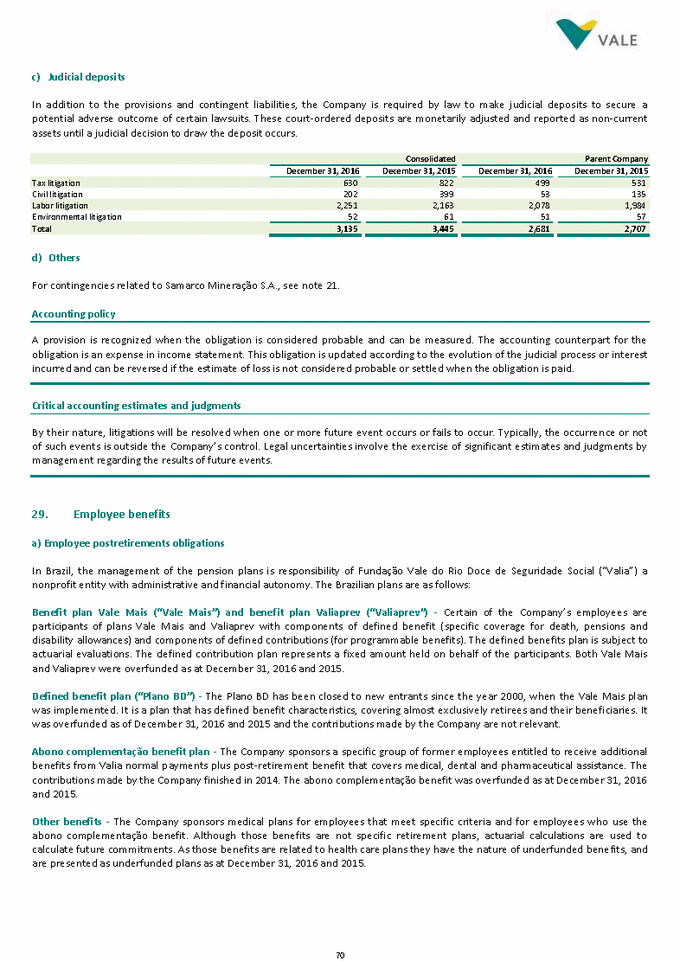
The Foreign plans are managed in accordance with their region. They are divided between plans in Canada, United States of America, United Kingdom, Indonesia, New Caledonia, Japan and Taiwan. Pension plans in Canada are composed of a defined benefit and defined contribution component. Currently the defined benefit plans do not allow new entrants. The foreign defined benefi t plans are underfunded as at December 31, 2016 and 2015. Employers’ disclosure about pensions and other post-retirement benefits on the status of the defined benefit elements of all plans is provided as follows. i. Change in benefit obligation Consolidated Parent Company Benefit obligation as at December 31, 2014 9,902 12,009 3,981 9,902 532 Interest costs 1,181 591 219 1,177 63 Participant contributions 4 1 - 4 - Effect of changes in the actuarial assumptions (710) (267) (119) (691) 30 Benefit obligation as at December 31, 2015 9,659 14,407 4,772 9,640 555 Interest costs 1,256 608 231 1,253 72 Participant contributions 2 2 - 2 - Translation adjustment - (1,906) (574) - - Others - 334 - - - ii. Evolution of assets fair value Consolidated Parent Company Fair value of plan assets as at December 31, 2014 13,357 9,872 - 13,357 - Employer contributions 208 446 216 201 70 Benefits paid (814) (874) (216) (814) (70) Transfers 19 (19) - - - Fair value of plan assets as at December 31, 2015 13,413 12,083 - 13,383 - Employer contributions 143 342 212 140 66 Benefits paid (970) (900) (212) (969) (66) Transfer to held for sale (43) - - - - Others - 430 - - - 71 Fair value of plan assets as at December 31, 2016 15,298 11,144 - 15,298 - - - - (1,530) - Translation adjustment - 970 - 192 976 Return on plan assets (excluding interest income) - 2 - 2 2 Participant contributions Interest income 1,777 525 - 1,772 - - - - 2,195 - Translation adjustment - (980) - (36) (977) Return on plan assets (excluding interest income) - 4 - 1 4 Participant contributions Interest income 1,616 498 - 1,615 - Overfunded pension plans Underfunded pension plans Overfunded pension plans Other benefits Other benefits Benefit obligation as at December 31, 2016 10,896 13,183 4,224 10,896 740 - - (193) - (29) Transfer to held for sale 76 936 244 371 942 Effect of changes in the actuarial assumptions (66) (969) (212) (900) (970) Benefits paid Service costs 36 267 (44) 34 103 - - 815 2,670 - Translation adjustment - - - (31) 31 Transfers (70) (814) (216) (874) (814) Benefits paid Service costs 65 308 92 62 - Overfunded pension plans Underfunded pension plans Overfunded pension plans Other benefits Other benefits
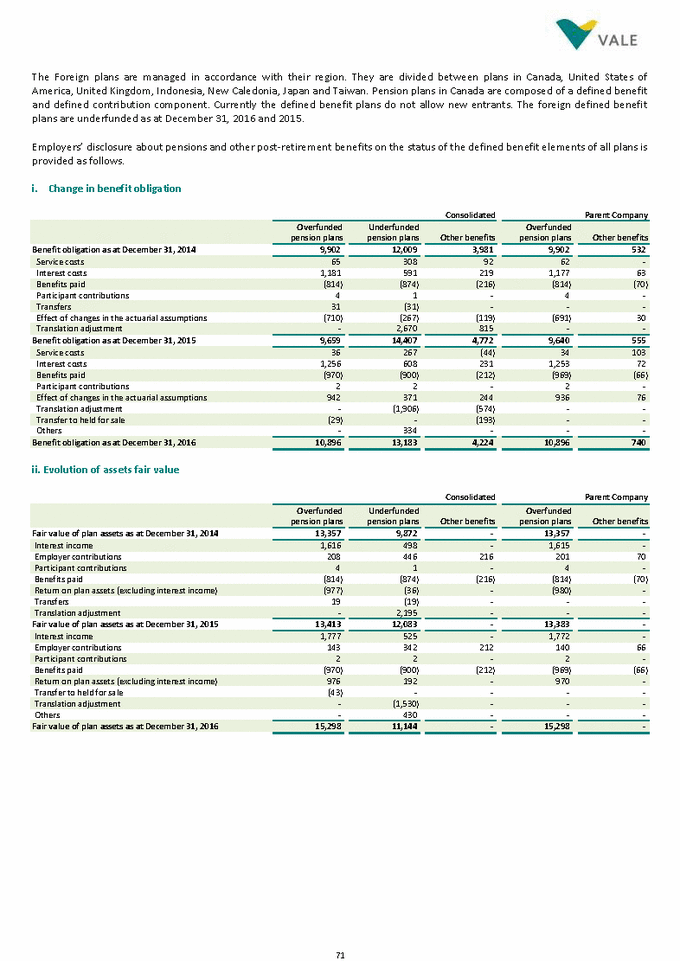
iii. Reconciliation of assets and liabilities recognized in the statement of financial position Plans in Brazil Overfunded pension plans Underfunded pension plans Overfunded pension plans Underfunded pension plans Other benefits Other benefits Interest income 539 - - 427 - - Transfer to held for sale (11) - - - - - Present value of actuarial liabilities (10,896) (1,260) (740) (9,659) (970) (624) Effect of the asset ceiling (4,402) - - (3,754) - - Non-current liabilities - (421) (682) - (133) (552) Consolidated December 31, 2016 December 31, 2015 Amount recognized in the statement of financial position Fair value of assets - 10,305 - - 11,246 - Non-current liabilities - (1,565) (3,370) - (2,124) (4,022) Total Overfunded pension plans Underfunded pension plans Overfunded pension plans Underfunded pension plans Other benefits Other benefits Interest income 539 - - 427 - - Transfer to held for sale (11) - - - - - Present value of actuarial liabilities (10,896) (13,183) (4,224) (9,659) (14,407) (4,773) Effect of the asset ceiling (4,402) - - (3,754) - - Non-current liabilities - (1,986) (4,052) - (2,257) (4,574) 72 Liabilities at end of the year - (2,039) (4,224) - (2,324) (4,773) (199) (67) - (172) (53) - Current liabilities Liabilities at end of the year - (2,039) (4,224) - (2,324) (4,773) - 12,083 13,413 - 11,144 15,298 Fair value of assets Amount recognized in the statement of financial position Balance at end of the year 4,402 - - 3,754 - - - - (128) - - 120 Changes in asset ceiling/ onerous liability Balance at beginning of the year 3,754 - - 3,455 - - December 31, 2016 December 31, 2015 Consolidated Liabilities at end of the year - (1,618) (3,484) - (2,191) (4,149) (127) (67) - (114) (53) - Current liabilities Liabilities at end of the year - (1,618) (3,484) - (2,191) (4,149) (4,149) (13,437) - (3,484) (11,923) - Present value of actuarial liabilities Overfunded pension plans Underfunded pension plans Overfunded pension plans Underfunded pension plans Other benefits Other benefits Foreign plan Liabilities at end of the year - (421) (740) - (133) (624) (72) - - (58) - - Current liabilities Liabilities at end of the year - (421) (740) - (133) (624) - 837 13,413 - 839 15,298 Fair value of assets Amount recognized in the statement of financial position Balance at end of the year 4,402 - - 3,754 - - - - (128) - - 120 Changes on asset ceiling and onerous liability Balance at beginning of the year 3,754 - - 3,455 - - December 31, 2016 December 31, 2015 Consolidated
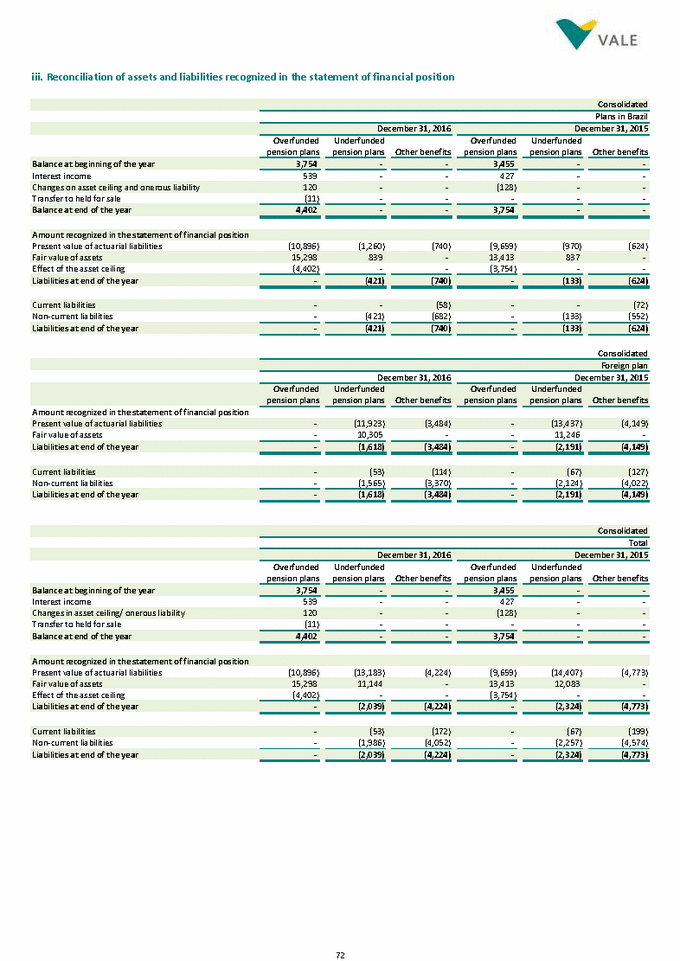
Parent Company December 31, 2016 December 31, 2015 Balance at beginning of the year 3,743 - - 3,455 - - Changes on asset ceiling and onerous liability 120 - - (139) - - Present value of actuarial liabilities (10,896) - (740) (9,640) - (555) Effect of the asset ceiling (4,402) - - (3,743) - - Non-current liabilities - - (682) - - (483) iv. Costs recognized in the income statement Year ended December 31 Overfunded pension plans Underfunded pension plans Overfunded pension plans Underfunded pension plans Other benefits Other benefits Interest on expense on liabilities 1,256 608 231 1,181 591 219 Interest expense on effect of (asset ceiling)/ onerous liability 541 - - 437 - - Year ended December 31 Overfunded pension plans Underfunded pension plans Overfunded pension plans Underfunded pension plans Other benefits Other benefits Interest on expense on liabilities 1,253 - 72 1,177 - 63 Interest expense on effect of (asset ceiling)/ onerous liability 540 - - 428 - - v. Costs recognized in the statement of comprehensive income Year ended December 31 Overfunded pension plans Underfunded pension plans Other benefits Overfunded pension plans Underfunded pension plans Other benefits Effect of changes actuarial assumptions (942) (371) (244) 710 267 119 Change of asset ceiling / costly liabilities (excluding interest income) (125) - - 170 - - (91) (84) (244) (97) 239 119 Others comprehensive income (60) (22) (184) (64) 235 86 Transfers/ disposal 4 (4) - 73 Accumulated other comprehensive income (500) (1,616) (523) (440) (1,934) (369) (105) (650) - 30 340 Translation adjustments (33) (4) 33 60 62 31 Deferred income tax - 8 - - 95 - Others - (36) (977) - 192 976 Return on plan assets (excluding interest income) Balance at beginning of the year (440) (1,934) (369) (380) (1,515) (350) 2016 2015 Consolidated Total of cost, net 55 - 175 52 - 63 - - (1,615) - - (1,772) Interest income on plan assets Service cost 34 -10362--2016 2015 Parent Company Total of cost, net 56 350 187 67 401 311 - (498) (1,616) - (525) (1,777) Interest income on plan assets Service cost 36267(44)6530892 2016 2015 Consolidated Liabilities at end of the year - - (740) - - (555) (72) - - (58) - - Current liabilities Liabilities at end of the year - - (740) - - (555) - - 13,383 - - 15,298 Fair value of assets Amount recognized in the statement of financial position Balance at end of the year 4,402 - - 3,743 - - Interest income 539 - - 427 - - Overfunded pension plans Underfunded pension plans Overfunded pension plans Underfunded pension plans Other benefits Other benefits Plans in Brazil
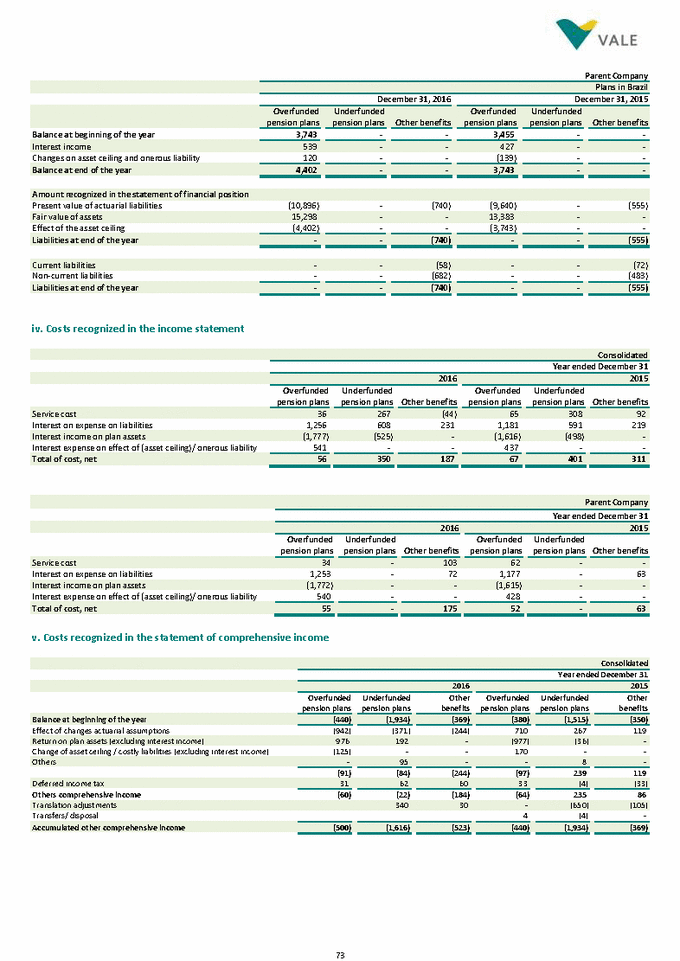
Year ended December 31 Overfunded pension plans Underfunded pension plans Overfunded pension plans Underfunded pension plans Other benefits Other benefits Effect of changes actuarial assumptions (936) - (76) 691 - (30) Change of asset ceiling / costly liabilities (excluding interest income) (121) - - 183 - - Deferred income tax 30 - 26 36 - 10 Transfers/ disposal - - - 7 (7) - vi. Risks related to plans The Administrators of the plans have committed to strategic planning to strengthen internal controls and risk management. This commitment is archived by conducting audits including of internal controls, which aim to mitigate operational market and credit risks. Risks are presented as follow: Legal - lawsuits: issuing periodic reports to internal audit and directors contemplating the analysis of lawyers about the possibilit y of loss (remote, probable or possible), aiming to support the administrative decision regarding provision s. Analysis and ongoing monitoring of developments in the legal scenario and its dissemination within the institution in order to subsidize the admin istrative plans, considering the impact of regulatory changes. Actuarial - the annual actuarial valuation of the benefit plans comprises the assessment of costs, revenues and adequacy of plan funding. It also considers the monitoring of biometric, economic and financial assumptions (asset volatility, changes in interest rates, inflation, life expectancy, salaries and other). Market - profitability projections are performed for the various plans and profiles of investments for 10 years in the management study of assets and liabilities. These projections include the risks of investments in various market segments. Furthermore, the risks for short-term market of the plans are monitored monthly through metrics of VaR (Value at Risk) and stress testing. For exclusive investment funds of Valia, the market risk is measured daily by the custodian asset bank. Credit - assessment of the credit quality of issuers by hiring expert consultants to evaluate financial institutions and internal assessment of payment ability of non-financial companies. For assets of non-financial companies the assessment is conducted a monitoring of the company until the maturity of the security. vii. Actuarial and economic assumptions and sensitivity analysis All calculations involve future actuarial projections about some parameters, such as: salaries, interest, inflation, the trend of INSS benefits, mortality and disability. The economic and actuarial assumptions adopted have been formulated considering the long-term period for maturity and should therefore be examined accordingly. In the short term they may not necessarily be realized. In the evaluations were adopted the following assumptions: Brazil Overfunded pension plans Underfunded pension plans Overfunded pension plans Underfunded pension plans Other benefits Other benefits Nominal average rate to determine expense/ income 10.98% - 11.14% 10.98% N/A 12.36% 13.71% N/A Nominal average rate of benefit increase 6.00% 6.00% N/A 6.00% 6.00% N/A Ultimate health care cost trend rate N/A N/A 8.00% N/A N/A 9.18% 74 6.00% 6.00% 6.00% 4.85% 4.85% 4.85% Nominal average rate of price inflation 9.18% N/A N/A 8.00% N/A N/A Immediate health care cost trend rate N/A 8.12% 8.12% N/A 6.95% 4.85% - 5.95% Nominal average rate of salary increase Discount rate to determine benefit obligation 10.98% - 11.14% 10.98% 10.98% - 11.09%13.63%13.71%13.63% December 31, 2016 December 31, 2015 Accumulated other comprehensive income (501) - (190) (444) - (140) Others comprehensive income (57) - (50) (70) - (20) (87) - (76) (106) - (30) - - (980) - - 970 Return on plan assets (excluding interest income) Balance at beginning of the year (444) - (140) (381) 7 (120) 2016 2015 Parent Company
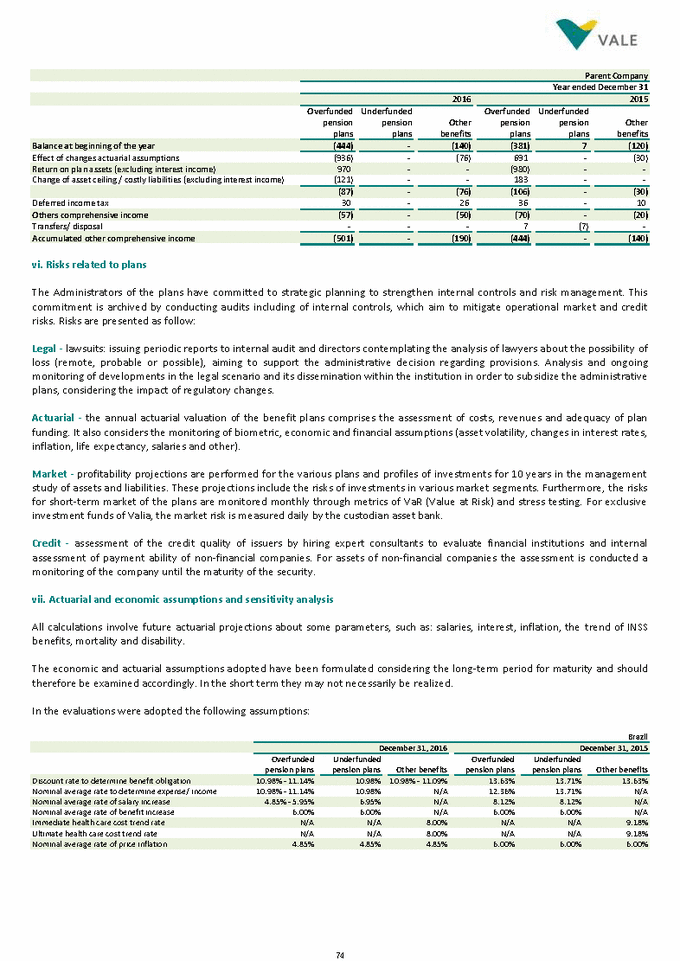
Foreign Underfunded pension plans Underfunded pension plans Other benefits Other benefits Nominal average rate to determine expense/ income 4.01% N/A 4.80% N/A Nominal average rate of benefit increase N/A 3.00% N/A 3.00% Ultimate health care cost trend rate N/A 4.50% N/A 4.50% For the sensitivity analysis, the Company considers the effect of 1% in nominal discount rate to determine the actuarial liab ility. The effects of this change in actuarial liabilities in premise and adopted the average duration of the plan are as follows: Parent Company December 31, 2016 December 31, 2016 Nominal discount rate - 1% increase Assumptions made 11.29% 5.55% 6.33% 11.29% - 11.48% Nominal discount rate - 1% reduction Assumptions made 9.56% 3.50% 4.02% 9.56% - 10.48% viii. Assets of pension plans Brazilian plan assets as at December 31, 2016 and 2015 includes respectively (i) investments in a portfolio of Vale’s stock in the amount of R$60 and R$15 and (ii) Brazilian Federal Government securities in the amount of R$13,623 and R$11,622. Foreign plan assets as at December 31, 2016 and 2015 includes Canadian Government securities in the amount of R$2,395 and R$2,636, respectively. ix. Overfunded pension plans Assets by category are as follows: Consolidated Level 1 Level 2 Level 3 Total Level 1 Level 2 Level 3 Total Accounts Receivable - - - - 1 - - 1 Debt securities - Corporate bonds - 380 - 380 - 367 - 367 Investments funds - Fixed Income 7,857 - - 7,857 7,023 - - 7,023 International investments 38 - - 38 112 - - 112 Structured investments - Real estate funds - - 32 32 - - 25 25 Loans to participants - - 850 850 - - 968 968 Funds not related to risk plans (5,290) (4,053) 75 Fair value of plan assets at end of year 15,298 13,413 Total 17,665 380 2,543 20,588 14,327 368 2,771 17,466 1,246 1,246 - - 1,205 1,205 - - Real estate 1,072 532 - 540 1,164 456 - 708 Structured investments - Private Equity funds 170 - - 170 549 - - 549 Investments funds - Equity 6,478 - - 6,478 8,512 - - 8,512 Debt securities - Government bonds 1 - - 1 - - - - Equity securities Cash and cash equivalents 1 --121-3 December 31, 2016 December 31, 2015 682 - 11,946 4,788 14,936 11,946 Actuarial liability balance 805 - 10,002 3,816 11,632 10,002 Actuarial liability balance Overfunded pension plans Underfunded pension plans Overfunded pension plans Underfunded pension plans Other benefits Other benefits Consolidated 2.00% 2.00% 2.00% 2.00% Nominal average rate of price inflation 6.30% N/A 6.30% N/A Immediate health care cost trend rate N/A 3.90% N/A 4.05% Nominal average rate of salary increase Discount rate to determine benefit obligation 3.84% 3.90% 4.00% 3.90% December 31, 2016 December 31, 2015
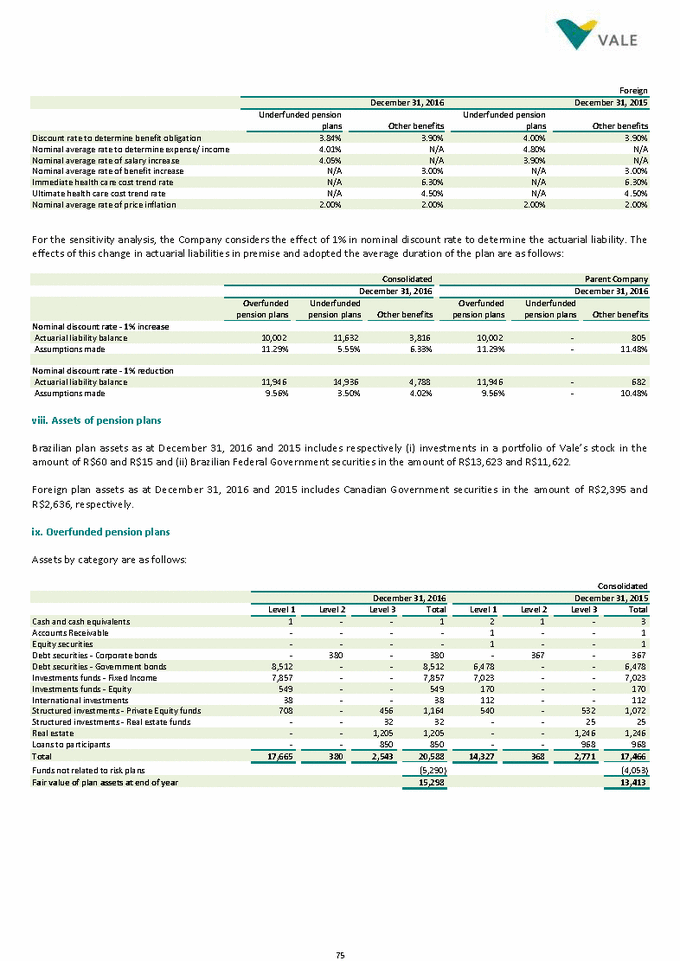
December 31, 2016 December 31, 2015 Cash and cash equivalents 1 - - 1 2 1 - 3 Debt securities - Corporate bonds - 380 - 380 - 367 - 367 Investments funds - Fixed Income 7,857 - - 7,857 7,018 - - 7,018 International investments 38 - - 38 112 - - 112 Structured investments - Real estate funds - - 32 32 - - 25 25 Loans to participants - - 850 850 - - 966 966 Funds not related to risk plans (5,290) (4,053) Measurement of overfunded plan assets at fair value with no observable market variables (level 3) are as follows: Loans to participants Private equity funds Real estate funds Real estate Total Return on plan assets (281) 3 15 157 (106) Assets sold during the year (25) - (95) (393) (513) Balance as at December 31, 2015 532 25 1,246 968 2,771 Assets purchases 103 7 8 193 311 Transfer to held for sale (33) - (1) (3) (37) Loans to participants Private equity funds Real estate funds Real estate Total Return on plan assets (281) 3 14 156 (108) Assets sold during the year (25) - (95) (393) (513) Return on plan assets (79) - 10 114 45 Assets sold during the year (79) - (58) (423) (560) x. Underfunded pension plans Assets by category are as follows: Consolidated Level 1 Level 2 Level 3 Total Level 1 Level 2 Level 3 Total Equity securities 4,045 - - 4,045 4,320 - - 4,320 47 Debt securities - Government bonds 271 2,395 - 2,666 219 2,671 - 2,890 Investments funds - Fixed Income 464 1,001 - 1,465 584 1,097 - 1,681 Investments funds - Equity 301 1,199 - 1,500 335 1,394 - 1,729 International investments - 88 - 88 8 117 - 125 Structured investments - Private Equity funds - - 608 608 - - 384 384 Structured investments - Real estate funds - - - - - - 1 1 Real estate - - 78 78 - - 77 77 Loans to participants - - 18 18 - - 17 17 Others - - 564 564 - - 621 621 Total 5,081 4,795 1,268 11,144 5,466 5,517 1,100 12,083 76 - 47 - 34 - 34 - Debt securities - Corporate bonds Cash and cash equivalents - 78 - 78 - 191 - 191 December 31, 2016 December 31, 2015 Balance as at December 31, 2016 456 32 1,205 850 2,543 311 193 8 7 103 Assets purchases Balance as at December 31, 2015 511 25 1,245 966 2,747 286 133 4 3 146 Assets purchases Balance as at December 31, 2014 671 19 1,322 1,070 3,082 Parent Company Balance as at December 31, 2016 456 32 1,205 850 2,543 (560) (423) (58) - (79) Assets sold during the year Return on plan assets (67) - 10 115 58 6 1 - - 5 Transfers in and/ out of Level 3 302 133 4 3 162 Assets purchases Balance as at December 31, 2014 671 19 1,322 1,070 3,082 Consolidated Fair value of plan assets at end of year 15,298 13,383 Total 17,665 380 2,543 20,588 14,321 368 2,747 17,436 1,245 1,245 - - 1,205 1,205 - - Real estate 1,051 511 - 540 1,164 456 - 708 Structured investments - Private Equity funds 170 - - 170 549 - - 549 Investments funds - Equity 6,478 - - 6,478 8,512 - - 8,512 Debt securities - Government bonds 1 - - 1 - - - - Accounts Receivable Level 1 Level 2 Level 3 Total Level 1 Level 2 Level 3 Total Parent Company
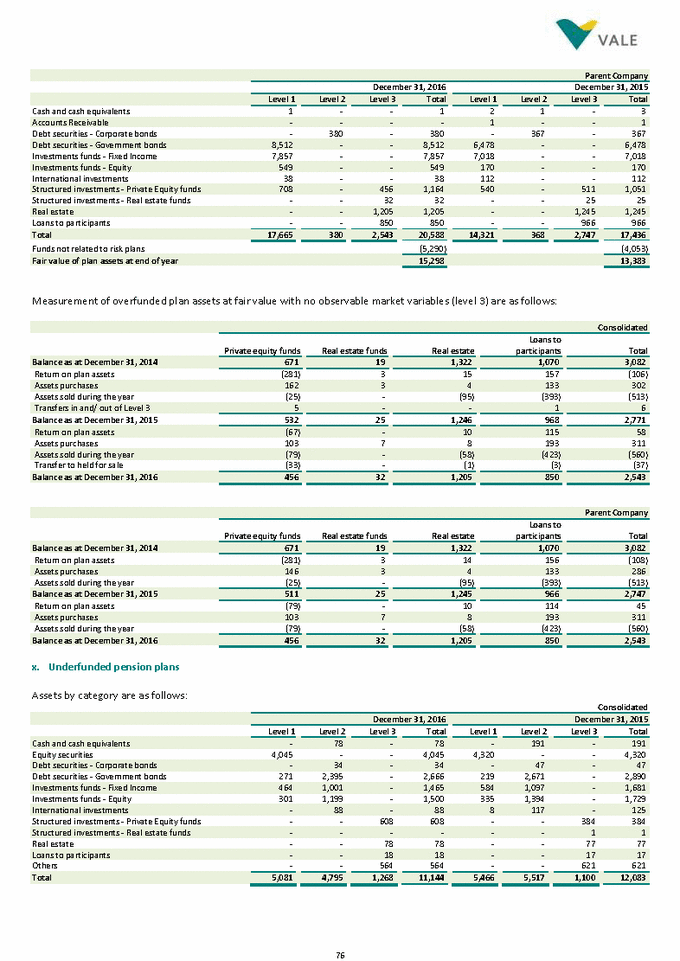
Measurement of underfunded plan assets at fair value with no observable market variables (level 3) are as follows: Private equity funds Real estate funds Loans to participants Real estate Others Total Return on plan assets - - 16 3 - 19 Assets sold during the year (3) - - - - (3) Balance as at December 31, 2015 384 1 77 17 621 1,100 Assets purchases 613 (1) - - - 612 Translation adjustment (55) - - - (88) (143) xi. Disbursement of future cash flow Vale expects to disburse R$536 in 2017 in relation to pension plans and other benefits. xii. Expected benefit payments The expected benefit payments, which reflect future services, are as follows: December 31, 2016 plans 2017 301 775 212 2019 339 772 226 2021 380 776 240 b) Profit sharing program (“PLR”) The Company recorded as cost of goods sold and services rendered and other operating expenses related to the PLR R$1,064 and R$147 for the year ended on December 31, 2016 and 2015, respectively. For the Parent Company, R$638 and RS$106 for the year ended on December 31, 2016 and 2015, respectively. c) Long-term compensation plan For the long-term awarding of eligible executives, the Company compensation plans includes Matching Program and Performance Share Unit Program - PSU, with three to four years-vesting cycles, respectively, with the aim of encouraging employee’s retention and stimulating their performance. For the Matching program, the participants can acquire Vale’s preferred shares in the market without any benefits being provided by Vale. If the shares acquired are held for a period of three years and the participants keep it employment relationship wit h Vale, the participant is entitled to receive from Vale an award in shares, equivalent to the number of shares originally acquired by the executive. It should be noted that, although a specific custodian of the shares is defined by Vale, the share initially purchased by the executives have no restriction and can be sold at any time. However, if it’s done before the end of the three-year-vesting period they lose the entitlement of receiving the related award paid by Vale. For PSU program, the eligible executives have the opportunity to receive during a four year-vesting cycle, an award equivalent to the market value of a determined number of common shares and conditioned to Vale’s performance factor measured as an indicator of total return to the shareholders (TSR). This award is paid in cash and can occur in cumulative installments of 2 0% (at the end of 2nd year), 30% (at the end of 3rd year) and 50% (at the end of 4th year), conditioned to the performance factor of each year. Liabilities of the plans are measured at fair value at every reporting period, based on market rates. Compensation costs incurred are recognized by the defined vesting period of three or four years. At December 31, 2016, 2015 and 2014 the Company recognized in the income statement the amounts of R$120, R$113 and R$163, respectively, related to long term compensation plan. 77 1,309 3,937 1,961 2022 and thereafter 234 773 360 2020 219 773 320 2018 Underfunded pension Other benefits Overfunded pension plans Balance as at December 31, 2016 608 - 78 18 564 1,268 (386) - - - - Assets sold during the year (386) Return on plan assets 52 - 1 1 31 85 (5) - (1) (4) 1 Transfers in and/ out of Level 3 (1) 960 621 - - (1) Assets purchases 340 Balance as at December 31, 2014 48 1 65 15 - 129
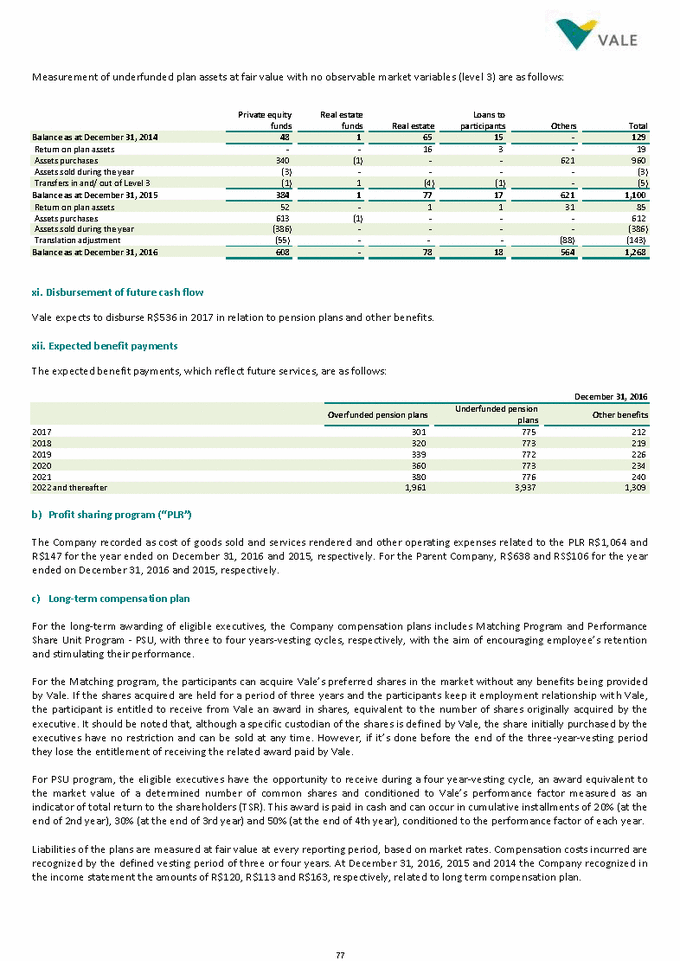
Accounting policy Employee benefits i. Current benefits – wages, vacations and related taxes Payments of benefits such as wages or accrued vacation, as well the related social security taxes over those benefits are rec ognized monthly in income, on an accruals basis. ii. Current benefits – profit sharing program The Company has the Annual Incentive Program (AIP) based on Team and business units contribution and Company -wide performance through operational cash generation. The Company makes an accrual based on evaluation periodic of goals achieve d and Company result, using the accrual basis and recognition of present obligation arising from past events in the estimated outflow of resources in the future. The accrual is recorded as cost of goods sold and services rendered or operating expenses in acco rdance with the activity of each employee. iii. Non-current benefits – long-term incentive programs The Company has established a procedure for awarding certain eligible executives (Matching and Virtual Shares Programs) with the goal of encouraging employee retention and optimum performance. Plan liabilities are measured at each reporting date, at their fair values, based on market prices. Obligations are measured at each reporting date, at fair values based on market prices. The compensation costs incurred are recognized in income during the vesting period as defined. iv. Non-current benefits – pension costs and other post-retirement benefits The Company has several retirement plans for its employees. For defined contribution plans, the Company's obligations are limited to a monthly contribution linked to a pre-defined percentage of the remuneration of employees enrolled in to these plans. For defined benefit plans, actuarial calculations are periodically obtained for liabilities determined in accordance with the Projected Unit Credit Method in order to estimate the Company’s obligation. The liability recognized in the balance sheet represents th e present value of the defined benefit obligation as at that date, less the fair value of plan assets. The Company recog nized in the income statement the costs of services, the interest expense of the obligations and the interest income of the plan assets. T he remeasurement of gains and losses, return on plan assets (excluding the amount of interest on return of assets, whi ch is recognized in income for the year) and changes in the effect of the ceiling of the active and onerous liabilities are recognized in comp rehensive income for the year. For overfunded plans, the Company does not recognize any assets or benefits in th e balance sheet or income statement until such time as the use of the surplus is clearly defined. For underfunded plans, the Company recognizes actuarial liabilities and re sults arising from the actuarial valuation. Critical accounting estimates and judgments Post-retirement benefits for employees The amount recognized and disclosed depend on a number of factors that are determined based on actuarial calculations using various assumptions in order to determine costs and liabilities. One of these assumptions is selection and use of the discount rate. Any changes to these assumptions will affect the amount recognized. At the end of each year the Company and external actuaries review the assumptions that will be used for the following year. T hese assumptions are used in determining the fair values of assets and liabilities, costs and expenses and the future values of es timated cash outflows, which are recorded in the plan obligations. 78
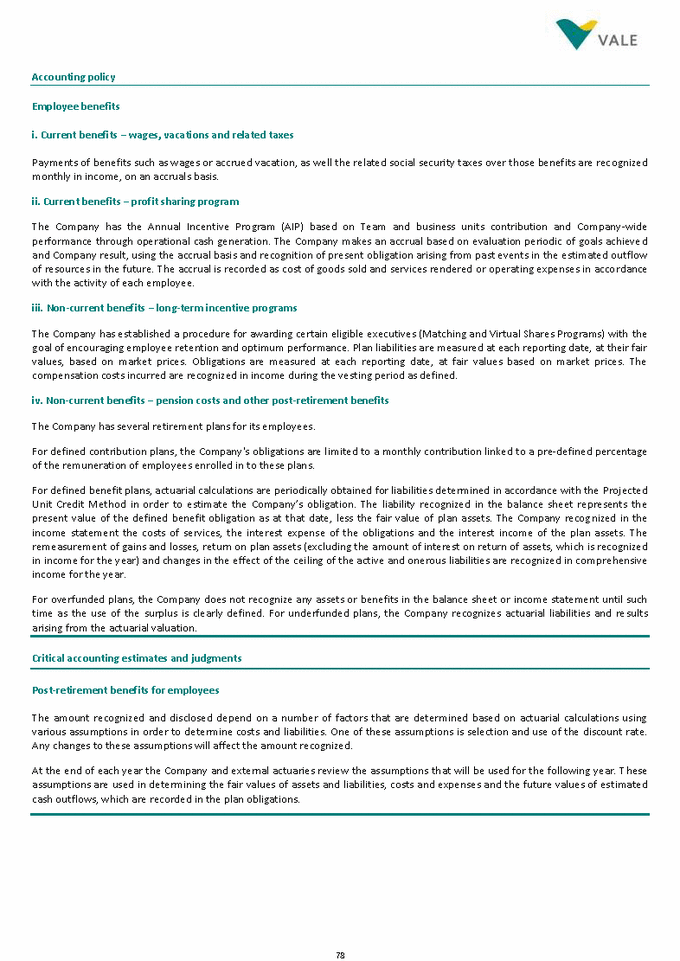
30. Stockholders’ equity a) Share capital Stockholders’ equity is represented by common shares (“ON”) and preferred non-redeemable shares (“PNA”) without par value. Preferred shares have the same rights as common shares, with the exception of voting rights to elect members of the Board of Directors. The Board of Directors may, regardless of changes to bylaws, issue new shares (authorized capital), including the capitalization of profits and reserves to the extent authorized. The Company repurchases its shares to hold in treasury for future sale or cancellation. These shares are recorded in a specific account as a reduction of stockholders´ equity at their acquisition value and carried at cost. These programs are approved by the Board of Directors with a determined terms and numbers of type of shares. Incremental costs directly attributable to the issue of new shares or options are recognized in stockholders’ equity as a ded uction from the amount raised, net of taxes At December 31, 2016 and 2015, share capital was R$77,300 corresponding to 5,244,316,120 shares issued and fully paid without par value. December 31, 2016 Valepar S.A. 1,716,435,045 20,340,000 1,736,775,045 Foreign investors - ADRs 786,067,634 610,880,671 1,396,948,305 PIBB - BNDES 741,730 1,171,101 1,912,831 Foreign institutional investors in local market 262,868,264 825,753,408 1,088,621,672 Retail investors in Brazil 37,988,150 309,895,202 347,883,352 Shares in treasury 31,535,402 59,405,792 90,941,194 b) Profit reserves The amount of profit reserves are distributed as follows: Balance as at December 31, 2014 44,611 8,131 343 - 53,085 Allocation of loss (39,585) (4,285) (343) - (44,213) Allocation of income 5,894 665 1,228 2,065 9,852 Investment reserve - aims to ensure the maintenance and development of activities that comprise the Company’s operations in an amount not exceeding 50% of distributable annual net income, limited to the share capital amount. Legal reserve - is a legal requirement for Brazilian public companies to retain 5% of the annual net income up to 20% of the capital. The reserve can only be used to compensate losses or to increase capital. Tax incentive reserve - results from the option to designate a portion of the income tax for investments in projects approved by the Brazilian Government as well as tax incentives. Additional remuneration reserve - Results from the portion of management proposed remuneration that exceeds the mandatory minimum remuneration of 25% of the adjusted net income as presented below established in the Company's by -laws. 79 Balance as at December 31, 2016 5,894 4,511 1,228 2,065 13,698 Balance as at December 31, 2015 - 3,846 - - 3,846 Dividends and interest on capital of Vale's stockholders (5,026) - - - (5,026) Total of profit reserves Additional Remuneration reserve Investments reserve Tax incentive reserve Legal reserve 3,600,000,000 7,200,000,000 10,800,000,000 Total authorized shares 47,421 29,879 77,300 Amounts per class of shares (in millions) Total issued shares 3,217,188,402 2,027,127,718 5,244,316,120 Shares outstanding 3,185,653,000 1,967,721,926 5,153,374,926 238,006,809 133,496,260 104,510,549 Institutional investors 272,564,154 66,185,272 206,378,882 BNDESPar 70,662,746 - 70,662,746 FMP - FGTS 12 12 - Brazilian Government (Golden Share) Stockholders ON PNA Total
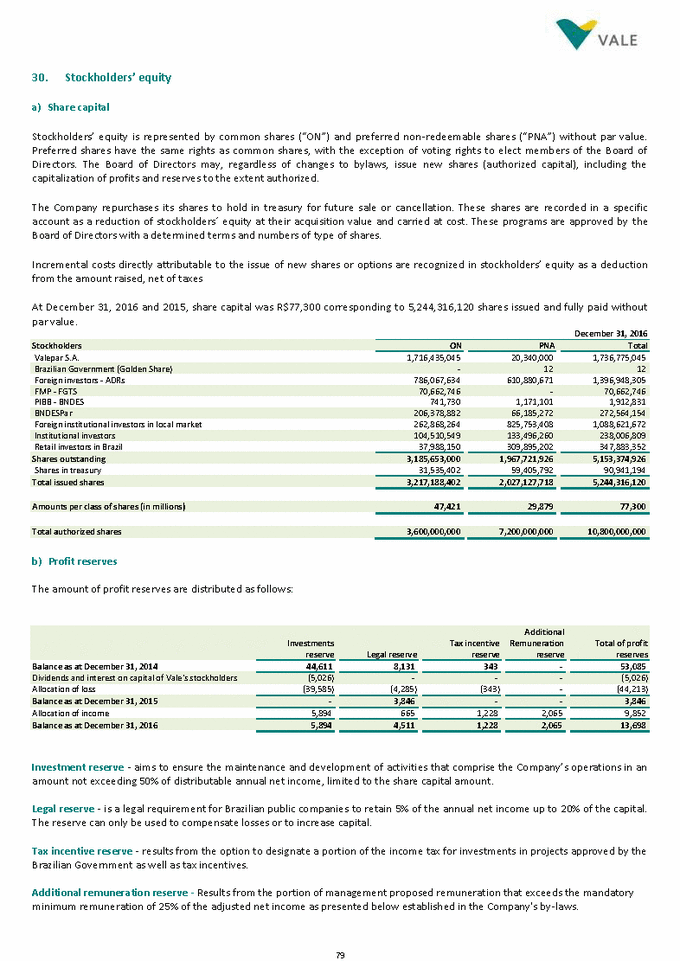
c) Unrealized fair value gain (losses) Available-for-sale financial instruments Retirement benefit obligations Cash flow hedge Conversion shares Total gain (losses) Other comprehensive income 260 1,458 2 - 1,720 (279) Balance as at December 31, 2015 (2,743) (25) (4) (1,101) (3,873) Translation adjustment 368 (1) - - 367 d) Remuneration to the Company’s stockholders Vale's by-laws determine the minimum remuneration to stockholders of 25% of net income, after adjustments from Brazil’s legal requirements which based on our adjusted net income as shown below resulted in R$3,459. In December, 2016 R$857 was anticipated and the remaining balance of R$2,602 was accounted for in short term liability as “Dividends and interest on capital”. Additionally, in our by-laws preferred shares class A are entitled to receive priority dividends corresponding to (i) at least 3% (three percent) of the shareholders’ equity share value, calculated based on the financial statements used as reference for the paym ent of dividends or (ii) 6% (six percent) calculated over the part of capital represented by this class of shares, whichever is the higher among them. Accordingly, management proposed and the Board of Directors approved the proposal for additional dividends payments of R$2,065 to equalize preferred and common share remuneration. The amount was classified as “ Additional Remuneration reserve” until it is approved in the annual general meeting. All remuneration paid and proposed during the year was based on interest on equity. The proposal of stockholders' remuneration was calculated as follows: 2016 Legal reserve (665) Adjusted net income 11,761 5,524 Mandatory minimum 3,459 5,524 Interest on capital 5,524 The amounts paid to stockholders, by nature of remuneration, are as follows: Dividends Interest on capital Total Amount per share First installment - April - 4,632 4,632 0.898904129 Total 1,752 7,987 9,739 Amounts paid in 2015 Second installment - October 1,925 - 1,925 0.373609533 First installment - December - 857 857 0.166293936 80 Total - 857 857 Amounts paid in 2016 Total 1,925 3,101 5,026 0.601760991 3,101 3,101 - First installment - April 0.990876867 5,107 3,355 1,752 Second installment - October Amounts paid in 2014 1.071865625 Total remuneration per share 5,524 Remuneration by nature: 2,065 Additional remuneration Remuneration: (6,237) Allocation of net income (885) Tax incentive reserve Net income of the year 13,311 Balance as at December 31, 2016 (2,638) - - (1,101) (3,739) Other comprehensive income (263) 26 4 - (233) (1,040) (1) (2) (758) Translation adjustment Balance as at December 31, 2014 (2,245) (1,204) (4) (1,100) (4,553)
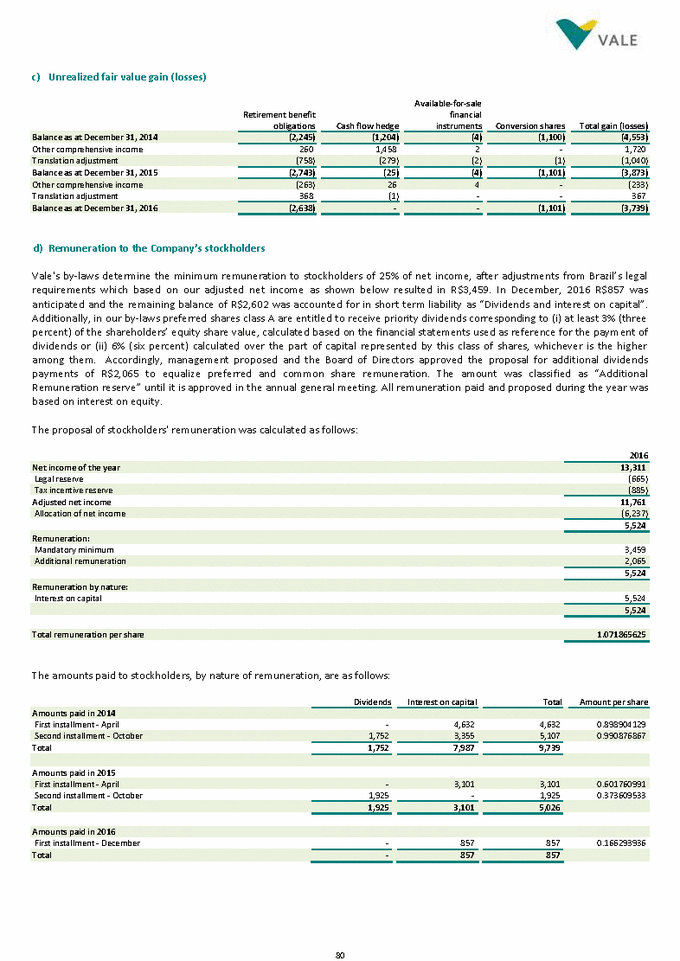
e) New shareholders' agreement – Subsequent event On February 20, 2017 the Company announced that a new shareholders’ agreement was filed at the Company’s headquarters, executed by Litel Participações S.A., Litela Participações S.A., Bradespar S.A., Mitsui & Co., Ltd. and BNDES Participações S.A. – BNDESPAR (“Valepar Agreement”), as shareholders of Valepar S.A. (“Valepar”), jointly referred to as “Shareholders”, which sha ll enter into force after the expiration of Valepar’s current Shareholders’ Agreement on May 10, 2017. The Valepar Agreement, along with the standard provisions in connection with voting rights and right of first refusal for the acquisition of the Shareholders’ shares, provides for the submission to the Company of a proposal for the p urpose of enabling the listing of Vale on BM&FBOVESPA’s Novo Mercado special segment (Brazil) and making Vale a company without defined control (“Proposal”). The Proposal is binding on the Shareholders, and it is subject to approval by the Company’s corpor ate bodies. The Valepar Agreement will have a term of 6 months, counting from the date it takes effect. The transaction envisaged by the Proposal is composed of a series of indivisible and interdependent steps, whose effectivenes s is subject to the successful performance of the other steps. The Proposal comprises, beyond the performance of all acts and procedures imposed by the applicable legal provisions and rules: (i) Voluntary conversion of Vale class A preferred shares into common shares, based on t he conversion rate of 0.9342 common shares for each Vale class A preferred share, based on the average closing price of the common shares and preferred shares ov er the last 30 trading sessions on the BM&FBOVESPA prior to February 17, 2017 (inclusive), weighted by the volume of shares traded in such trading sessions; (ii) Amendment of Vale’s bylaws, so as to adjust it, as much as possible, to BM&FBOVESPA’s Novo Mercado special segment rules so Vale may be effectively listed on such special segment; (iii) The merger of Valepar into Vale at an exchange ratio that contemplates a 10% increase in the number of shares held by the shareholders of Valepar compared to Valepar’s current shareholding interest, and represents a dilution of approximately 3% of the shareholding interest held by the other shareholders in Vale. In line with the provisions of item “iii” above, Valepar’s shareholders will receive 1.2065 Vale common shares for each Valep ar share held by them. As a result, Vale will issue 173,543,667 new common shares, all registered and without par value, in favor of Valepar’s shareholders. Consequently, Valepar’s shareholders will own a total of 1,908,980,340 Vale common shares after the merger of Valepar. The goodwill balance carried on Valepar’s financial statements and its potential tax benefit use by Vale will not be subject to capitalization in favor of Valepar’s shareholders, but will be for the benefit of all Vale’s shareholders. Valepar will hold at the time of the merger enough cash and cash equivalents to fully settle its liabilities. The implementation of the Proposal is subject to (i) the approval of the Proposal, including the merger of Valepar into Vale, by Valepar’s and Vale’s corporate bodies; and (ii) the acceptance by at least 54.09% of class A preferred shares of the voluntary conversion, as mentioned in item “i” above, within the maximum term of 45 days from the shareholders’ meeting decision on the matter, resulting in a combined shareholding interest held by the Shareholders of less than 50% of Vale’s total common shares. Valepar and the Shareholders will not exercise their voting right at Vale’s shareholders’ meetings that consider the voluntar y conversion of the Vale class A preferred shares into common shares and the merger of Valepar. The holders of American Depositary Shares representing class A preferred shares of Vale will be able to elect voluntary conve rsion into American Depositary Shares representing common shares of Vale, on the same terms available to holders of class A preferred shares. Class A preferred shares, and preferred ADSs, that do not elect voluntary conversion will remain outstanding. On the date of effectiveness of the merger of Valepar into Vale, if the merger is approved, the Shareholders will execute a new shareholders’ agreement (“Vale Agreement”) that will bind only 20% of the totality of Vale’s common shares, and will be in fo rce until November 9, 2020, with no provision for renewal. For 6 months from the date of entry into force of the Vale Agreement, the Shareholders will be obligated not to transfer, by any means, either directly or indirectly, Vale shares they receive as a result of the implementation of the Proposal (“Lock -Up”), except for (i) the transfer of Vale’s shares by the Shareholders to their affiliates and their current shareholders, provided that s uch transferred shares shall remain subject to the Lock-Up, and (ii) the transfer of shares held by the Shareholders prior to the merger of Valepar. 81
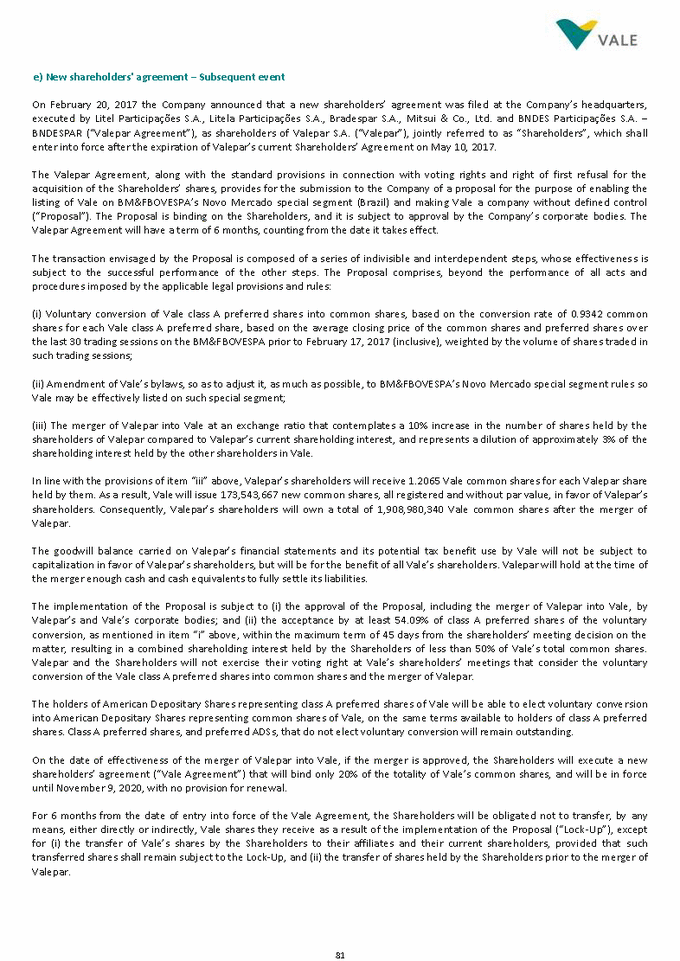
Accounting policy The stockholder’s remuneration is paid on dividends and interest on capital. This remuneration is recognized as a liability i n the financial statements of the Company based on bylaws. Any amount above the minimum compulsory remuneration approved by the bylaws shall only be recognized in current liabilities on the date that is approved by stockholders. The Company is permitted to distribute interest attributable to stockholders’ equity. The calculation is b ased on the stockholders’ equity amounts as stated in the statutory accounting records and the interest rate applied may not exceed the Brazilian Government Long-term Interest Rate (“TJLP”) determined by the Central Bank of Brazil. Also, such interest may not exceed 50% of the net income for the year or 50% of retained earnings plus profit reserves as determined by Brazilian corporate law. The benefit to the Company, as opposed to making a dividend payment, is a reduction in the income tax burden because t his interest charge is tax deductible in Brazil. Income tax of 15% is withheld on behalf of the stockholders relative to the inte rest distribution. Under Brazilian law, interest attributed to stockholders’ equity is considered as part of the annual minimum mandatory dividend. This notional interest distribution is treated for accounting purposes as a deduction from stockholders' equity in a manner similar to a dividend and the tax deductibility recorded in the income statement. 31. Related parties Transactions with related parties are made by the Company at arm´s-length, observing the price and usual market conditions and therefore do not generate any undue benefit to their counterparties or loss to the Company. In the normal course of operations, Vale enters into contracts with related parties (associates, joint ventures and stockholders), related to the sale and purchase of products and services, loans, derivatives, leasing of assets, sale of raw material and ra ilway transportation services. The balances of these related party transactions and their effects on the financial statements are as follows: Consolidated Derivative financial instruments Derivative financial instruments Cash and cash equivalents Accounts receivable Related parties Cash and cash equivalents Accounts receivable Related parties Banco do Brasil S.A. 186 111 - - 1,544 62 - - Companhia Hispano-Brasileira de Pelotização - - 2 - - - 3 14 Companhia Nipo-Brasileira de Pelotização - - - 48 - - - 35 Consórcio Rebocadores da Baia de São Marcos - - 32 - - - 60 - MRS Logística S.A. - - - 78 - - - 65 Others - - 155 32 - - 103 70 82 Total 1,887 1,167 349 238 1,688 320 306 278 39 135 - - 38 27 - - VLI - 5 - - - 11 - - Mitsui & Co., Ltd. - - - - - 122 - - Companhia Siderúrgica do Pecem 33 - - - 27 - - - Companhia Ítalo-Brasileira de Pelotização 22 - - - 15 - - - Companhia Coreano-Brasileira de Pelotização Banco Bradesco S.A. 1,701 1,056 - - 144 258 - - December 31, 2016 December 31, 2015 Assets

Consolidated Derivative financial instruments Derivative financial instruments Others liabilities Related parties Loans and borrowings Others liabilities Related parties Loans and borrowings Banco Bradesco S.A. 815 - - 20 800 - - 1,445 BNDES 236 - - 14,444 152 - - 15,877 Companhia Coreano-Brasileira de Pelotização - 10 192 - - 15 273 - Companhia Ítalo-Brasileira de Pelotização - - 323 - - 12 252 - Consórcio Rebocadores da Baía de São Marcos - - - - - 30 - - Mitsui & Co., Ltd. - 56 - - - 41 - - Sumic Nickel Netherland B.V - - 1,149 - - - 1,374 - Others - 130 22 - - 122 59 - Parent Company Cash and cash equivalents Derivative financial instruments Cash and cash equivalents Derivative financial instruments Accounts receivable Related parties Accounts receivable Related parties Banco do Brasil S.A. 8 111 - - 217 62 - - Companhia Coreano-Brasileira de Pelotização - - - 15 - - - 22 Companhia Ítalo-Brasileira de Pelotização - - - 27 - - - 33 Companhia Portuária Baía de Sepetiba - - 1 80 - - - 119 115 - - - - - Consórcio Rebocadores da Baia de São Marcos - - 32 - - - - - Empreendimentos Brasileiros de Mineração S.A. - - - 292 - - - - Mineração Brasileiras Reunidas S.A. - - 1 14 - - - 161 Mineração Corumbaense Reunidas S.A. - - 52 - - - 51 - MRS Logística S.A. - - - 30 - - - 27 Salobo Metais S.A. - - 16 104 - - 22 155 Vale International S.A. - - 27,387 - - - 36,518 331 VLI - - 27 38 - - 135 39 Others - - 172 36 - - 230 6 Total 75 1,167 27,806 1,649 261 320 36,956 2,302 83 - - Companhia Siderúrgica do Pecem 35 - - - 48 - - - Companhia Nipo-Brasileira de Pelotização 14 - - - - 2 - - Companhia Hispano-Brasileira de Pelotização 1,360 - - - 965 1 - - Biopalma da Amazônia S.A. Banco Bradesco S.A. 67 1,056 - - 44 258 --December 31, 2016 December 31, 2015 Assets Total 1,198 473 2,605 24,181 1,928 531 2,686 29,021 - - - - - - 8 - VLI - - 91 - - - 82 - MRS Logística S.A. - 266 - - - 270 - - Ferrovia Centro-Atlântica S.A. - 436 34 - - 477 10 - Companhia Nipo-Brasileira de Pelotização - 26 143 - - 47 126 - Companhia Hispano-Brasileira de Pelotização 1,449 - - - 1,348 - - - BNDES Participações S.A. 10,250 - - 976 8,369 - - 147 Banco do Brasil S.A. Aliança Geração de Energia S.A. - 51 125 - - 43 - - December 31, 2016 December 31, 2015 Liabilities
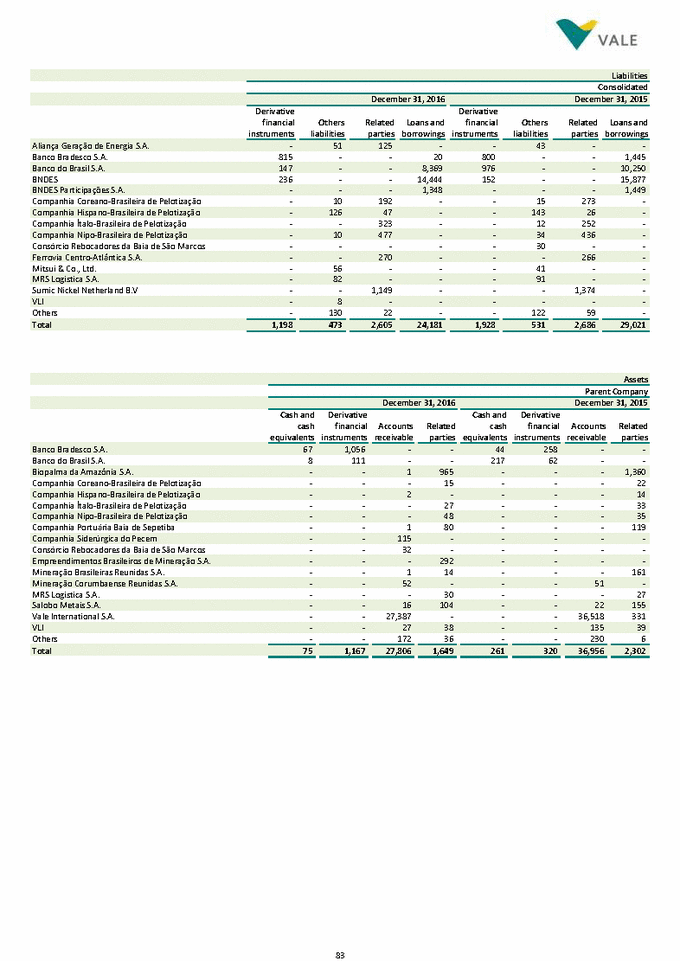
Parent Company Derivative financial instruments Derivative financial instruments Others liabilities Related parties Loans and borrowings Others liabilities Related parties Loans and borrowings Banco Bradesco S.A. 815 - - 20 800 - - 1,445 BNDES 236 - - 13,039 152 - - 14,405 Companhia Coreano-Brasileira de Pelotização - 10 - - - 15 - - Companhia Ítalo-Brasileira de Pelotização - - - - - 12 - - Companhia Portuária baía de Sepetiba - 285 - - - 484 - - Empreendimentos Brasileiros de Mineração S.A. - - 7 - - - - - Mineração Brasileiras Reunidas S.A. - 505 3,131 - - 510 3,172 - Vale Internatinal S.A. - 4 59,715 - - 5 66,814 - Others - 163 292 - - 256 359 - Year ended December 31 2016 2015 2014 Aliança Geração de Energia S.A. - (422) - 44 - - - - - Banco do Brasil S.A. (i) - - (1,537) - - (1,390) - - (155) BNDES (i) - - (1,871) - - (1,331) - - (470) - (244) - - (178) - - (95) California Steel Industries, Inc. 38 - - - - - 420 - - Companhia Coreano-Brasileira de Pelotização - (220) (20) - (270) - - (230) - Companhia Hispano-Brasileira de Pelotização - (150) (14) - (168) - - (108) - Companhia Ítalo-Brasileira de Pelotização - (170) (25) - (224) - - (115) - Companhia Nipo-Brasileira de Pelotização - (400) (36) - (365) - - (369) - Companhia Siderúrgica do Atlântico - (21) - - - - - (495) - Companhia Siderúrgica do Pecem 445 (96) - - - - - - - Consórcio Rebocadores da Baía de São Marcos 14 - - - - - - - - Ferrovia Centro Atlântica S.A. 125 (97) (7) 156 (128) (5) 140 - - Ferrovia Norte Sul S.A. 55 - - - - - - - - Mitsui & Co., Ltd. 482 (120) - 612 - - 260 (93) - MRS Logística S.A. - (1,586) - - (1,620) - - (1,407) - Samarco Mineração S.A. 74 - 3 407 - - 491 - - VLI 953 (72) - 835 - - 825 - 18 Others 52 (12) 2 183 (149) 30 246 (209) 46 Total 2,238 (3,423) (3,090) 2,237 (3,002) (3,092) 2,382 (3,073) (711) 84 - BNDES Participações S.A. (i) - (47) - - (78) - - (57) - Baovale Mineração S.A. (55) - - (218) - - 659 - - Banco Bradesco S.A. (i) Net operating revenue Net operating revenue Net operating revenue Costs and expenses Financial result Costs and expenses Financial result Costs and expenses Financial result Consolidated Total 1,198 1,244 63,540 22,776 1,928 1,623 70,611 27,549 - - - - - - 8 - VLI - - 91 - - - 82 - MRS Logística S.A. - 266 - - - 270 - - Ferrovia Centro-Atlântica S.A. - - 30 - - - - - Consórcio Rebocadores da Baía de São Marcos - - 34 - - - 10 - Companhia Nipo-Brasileira de Pelotização - - 143 - - - 126 - Companhia Hispano-Brasileira de Pelotização 1,449 - - - 1,348 - - - BNDES Participações S.A. 10,250 - - 976 8,369 - - 147 Banco do Brasil S.A. Aliança Geração de Energia S.A. - 51 125 - - 43 - - December 31, 2016 December 31, 2015 Liabilities
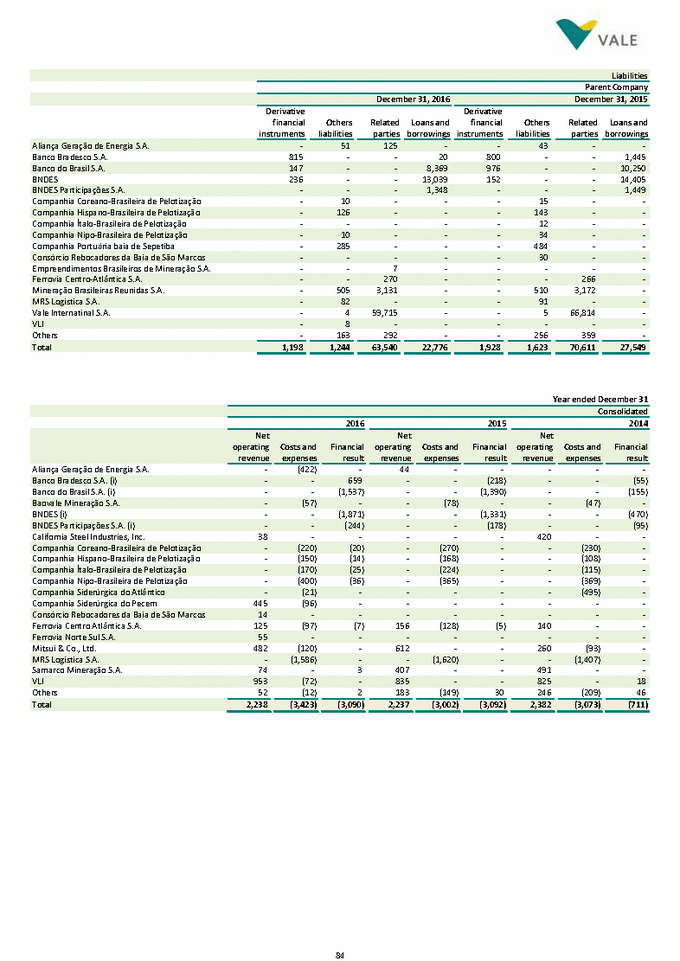
Parent Company Net operating revenue Costs and expenses Financial result Net operating revenue Costs and expenses Financial result Banco Bradesco S.A. (i) - - 645 - - (219) Baovale Mineração S.A. - (57) - - (78) - BNDES Participações S.A. (i) - - (244) - - (178) Companhia Coreano-Brasileira de Pelotização - (220) - - (270) - Companhia Ítalo-Brasileira de Pelotização - (170) - - (234) - Companhia Portuária Baía de Sepetiba - (663) - - (892) - Companhia Siderúrgica do Pecem 420 - - - - - Ferrovia Centro Atlântica S.A. 125 (97) (7) 156 (128) - Mineração Brasileiras Reunidas S.A. - (1,540) (404) - (1,133) (172) Samarco Mineração S.A. 74 - 3 408 - - Vale Energia S.A. - (14) - - (242) - Others 94 (1) (355) 146 (21) (14) (i) Does not include exchange rate variation. The key management personnel remuneration is as follows: Year ended December 31 Short-term benefits Direct and indirect benefits 15 19 17 44 68 70 Shares based 3 2 2 Termination of position 15 19 - 85 62 89 72 Long-term benefits 28 24 - Bonus 25 25 29 Wages or pro-labor 2016 2015 2014 Total 42,337 (5,413) (1,391) 38,920 (5,151) (17,772) - - 959 - (72) 953 VLI (15,021) - 37,251 2,535 - 40,601 Vale International S.A. - (1,620) - - (1,586) - MRS Logística S.A. - - - - - 55 Ferrovia Norte Sul S.A. - - - - - 14 Consórcio Rebocadores da Baía de São Marcos - (365) - - (21) - Companhia Siderúrgica do Atlântico - - - - (400) - Companhia Nipo-Brasileira de Pelotização - (168) - - (150) - Companhia Hispano-Brasileira de Pelotização 517 - - (161) - 1 Biopalma do Amazônia S.A. (1,295) - - (1,860) - - BNDES (i) (1,390) - - (1,543) - - Banco do Brasil S.A. (i) Aliança Geração de Energia S.A. - (422) - - - - 2016 2015 Year ended December 31
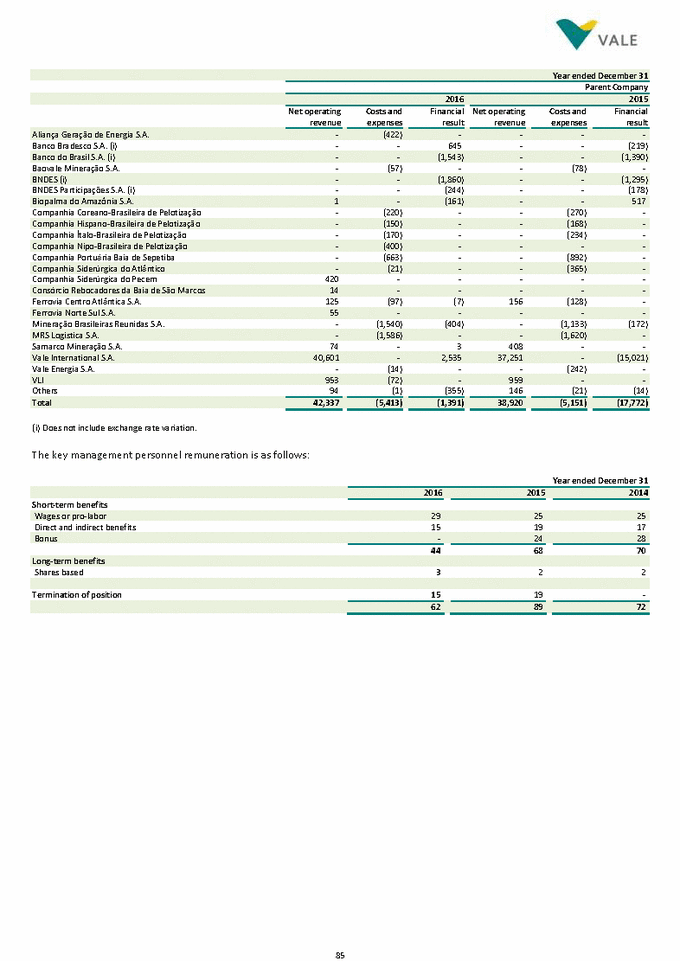
32. Commitments a) Base metals operations i) Nickel Operations – New Caledonia In regards to the construction and installation of the nickel plant in New Caledonia, Vale Canada Limited (“Vale Canada”) provided guarantees in respect of a special financing arrangement, structured under French tax law, to BNP Paribas (agent for the benefit of certain French institutional tax investors). The guarantees relate to lease finance payments due from Vale Nouvelle-Calédonie S.A.S. (“VNC”) to a special purpose company held by the French tax investors in respect of certain assets of the plant. Consistent with VNC’s commitments under the financing structure, these assets were substantially complete as at December 31, 2012. Vale Canada has committed that these assets will operate for a five year period following substantial completion. Vale Canada believes the likelihood of the guarantees being called upon is remote. ii) Nickel Operations – Indonesia In October 2014, Vale subsidiary PT Vale Indonesia Tbk (“PTVI”), a public company in Indonesia, renegotiated its agreement with the Government to operate (known as the Contract of Work (“CoW”)). The renegotiation included an undertaking by PTVI to further divest 20% of its shares to Indonesian participants (approximately 20% of PTVI’s shares already being registered on the Indonesian stock exchange) within five years. This undertaking will be fulfilled by PTVI’s existing major shareholders, being Vale Canada and Sumitomo Metal Mining, Co., Ltd., on a pro rata basis. iii) Nickel Operations – Canada The subsidiaries Vale Canada, Vale Newfoundland & Labrador Limited (“VNLL”) and the Province of Newfoundland and Labrador (the “Province”) signed a Development Agreement with respect to the development and operation of the Voisey’s Bay mine along with certain other obligations with respect to processing in the Province and the export of nickel and copper concentrate. On December 19, 2014, the Sixth Amendment to the Development Agreement was executed. The Sixth Amendment includes operational and other key commitments in the Development Agreement. As such, under the Development Agreement, as amended, VNLL has a potential obligation secured by letters of credit and other security, which may become due and payable in the event that certain commitments in relation to the construction of the underground mine are delayed or not met. iv) Other In the course of the operations the Company has provided other letters of credit, guarantees and surety bonds in the amount of R$3.6 billion (US$1.1 billion) that are associated with items such as environment reclamation, asset retirement obligation commitments, insurance, electricity commitments, post-retirement benefits, community service commitments and import and export duties. b) Participative stockholders’ debentures At the time of its privatization in 1997, Vale issued debentures to then-existing stockholders, including the Brazilian Government. The debentures’ terms were set to ensure that pre-privatization stockholders would participate in potential future benefits that might be obtained from exploiting mineral resources. A total of 388,559,056 debentures were issued with a par value of R$0.01 (one cent of Brazilian Real), whose value will be inflation-indexed the General Market Price Index (“IGP-M”), as set out in the Issue Deed. The Company paid as semiannual remuneration the amount of R$268 and R$209, respectively, for the year ended December 31, 2016 and 2015. c) Others commitments The table below sets forth the annual minimum, required obligations assumed by the Company as of December 31. and non-cancelable, future payments related to the contractual 2021 and thereafter 2017 2018 2019 2020 Purchase obligations 8,959 1,266 647 487 3,927 86 Total minimum payments required 9,476 1,731 1,104 942 5,616 Operating lease 517 465 457 455 1,689
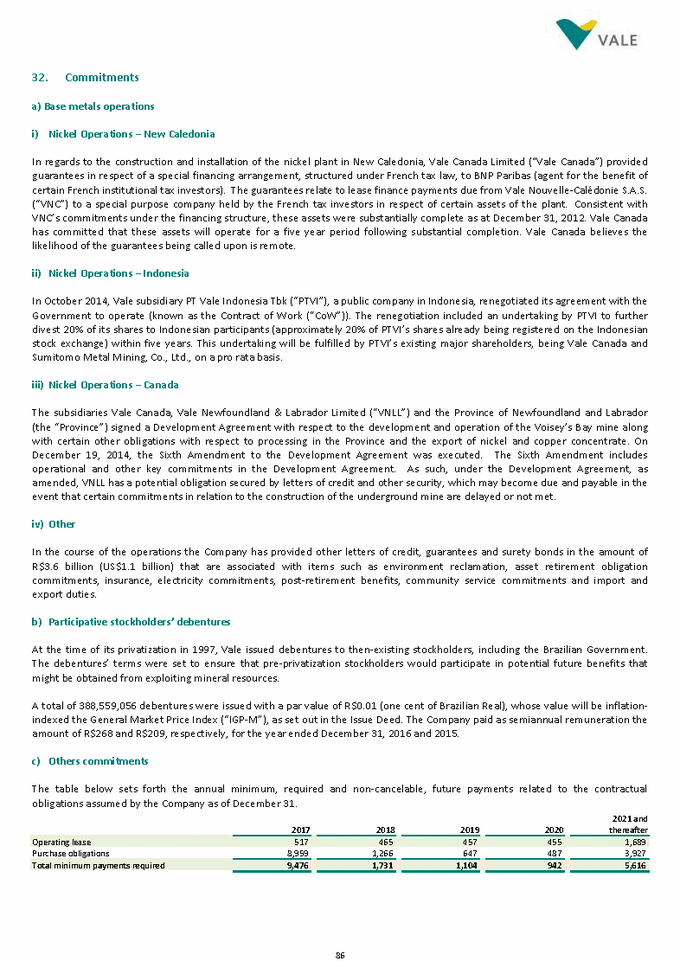
Operating lease - Vale has operating lease agreements with its joint ventures Companhia Coreano-Brasileira de Pelotização, Companhia Hispano-Brasileira de Pelotização, Companhia Ítalo-Brasileira de Pelotização and Companhia Nipo-Brasileira de Pelotização (together “pelletizing companies”), in which Vale leases their pelletizing plants. These renewable operating lease agreements have last between 3 and 10 years. The minimum future payments have been calculated co nsidering that all contracts will be renewed automatically. The Company also has operating leases for the exploration and processing of iron ore with joint ventures, port operations wit h third parties and property leases for its operational facilities with third parties. The total amount of operational leasing expenses for the year ended on December 31, 2016, 2015 and 2014 were R$940, R$1,033 and R$822, respectively. Purchase obligations - The purchase obligations derive mainly from take or pay contracts, contracts for the acquisition of fuel and the acquisition of raw materials and services. d) Guarantees provided As of December 31, 2016, corporate guarantees provided by Vale (within the limit of its direct or indirect interest) for the companies Norte Energia S.A. and Companhia Siderúrgica do Pecém S.A. totaled R$1,176 and R$4,725 respectively. 87
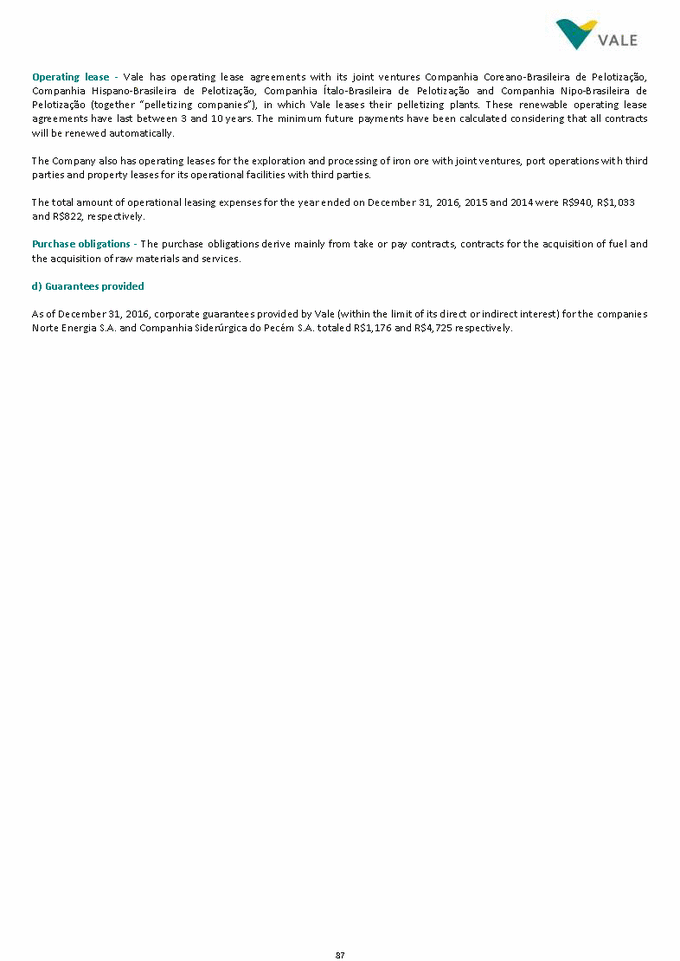
33. Additional information about derivatives financial instruments a) Sensitivity analysis of derivative financial instruments The following tables present the potential value of the instruments given hypothetical stress scenarios for the main market risk factors that impact the derivatives positions. The scenarios were defined as follows: - - - Scenario I: fair value calculation considering market prices as of December 31, 2016 Scenario II: fair value estimated considering a 25% deterioration in the associated risk variables Scenario III: fair value estimated considering a 50% deterioration in the associated risk variables 88
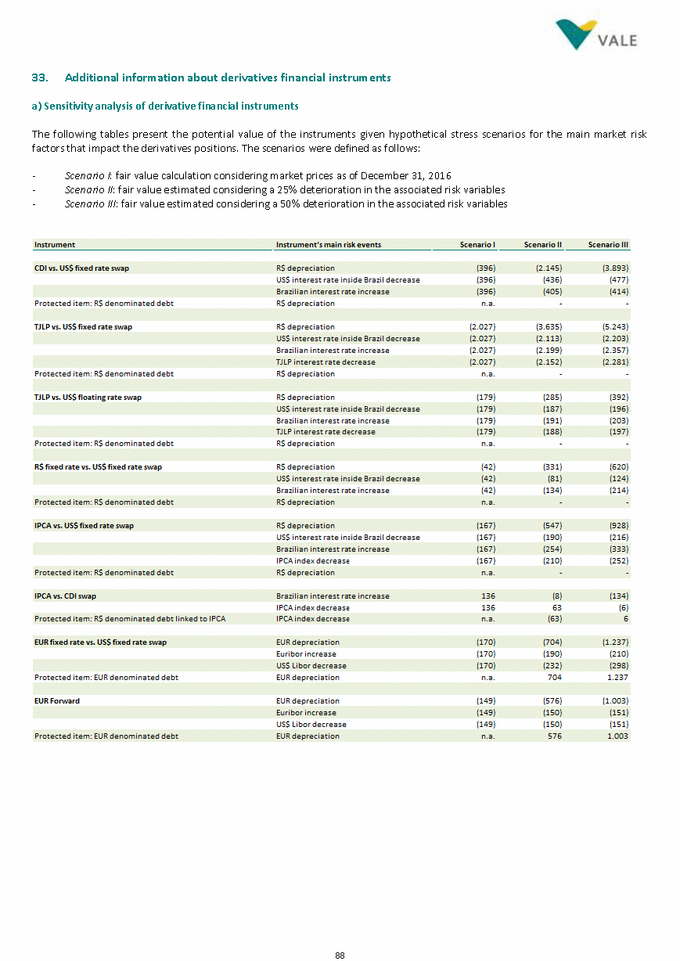
b) Financial counterparties’ ratings The transactions of derivative instruments, cash and cash equivalents as well as investments are held with financial institut ions whose exposure limits are periodically reviewed and approved by the delegated authority. The financial institu tions credit risk is performed through a methodology that considers, among other information, ratings provided by international rating agencies. The table below presents the ratings in foreign currency published by agencies Moody’s and S&P regarding the main financial institutions that we had outstanding positions as of December 31, 2016. 89
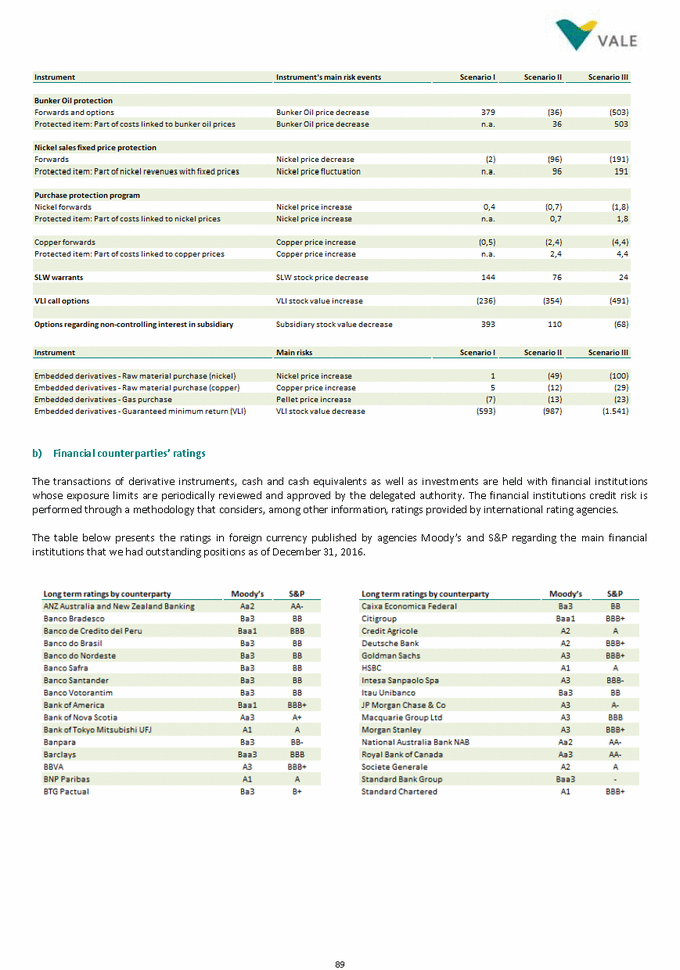
c)Market curves The curves used on the pricing of derivatives instruments were developed based on data from BM& F, Central Bank of Brazil, London Metals Exchange and Bloomberg. (i) Products (ii) Foreign exchange and interest rates 90
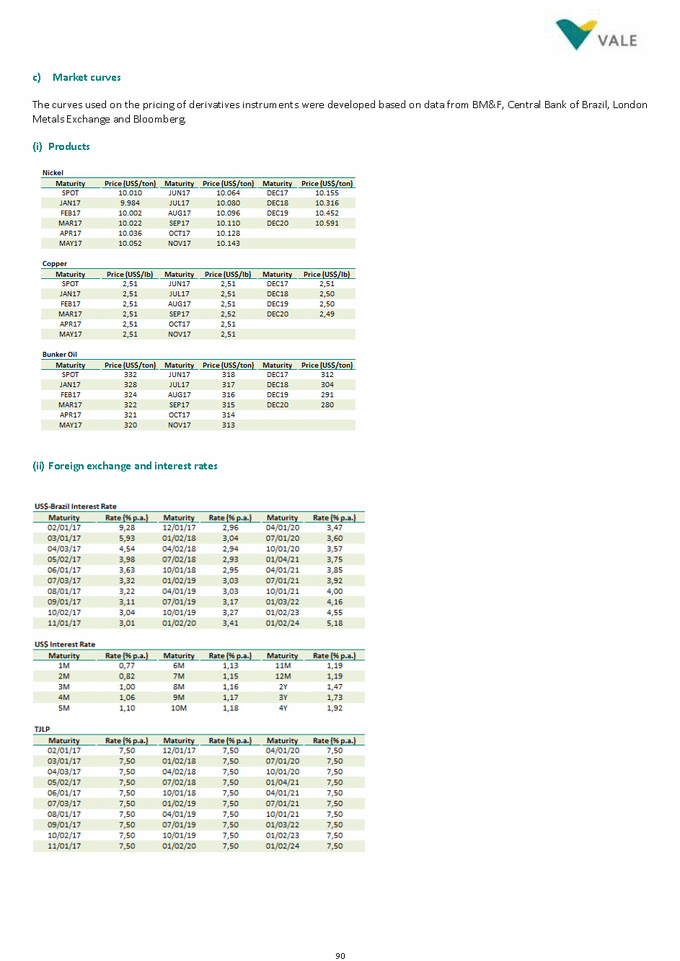
[LOGO]
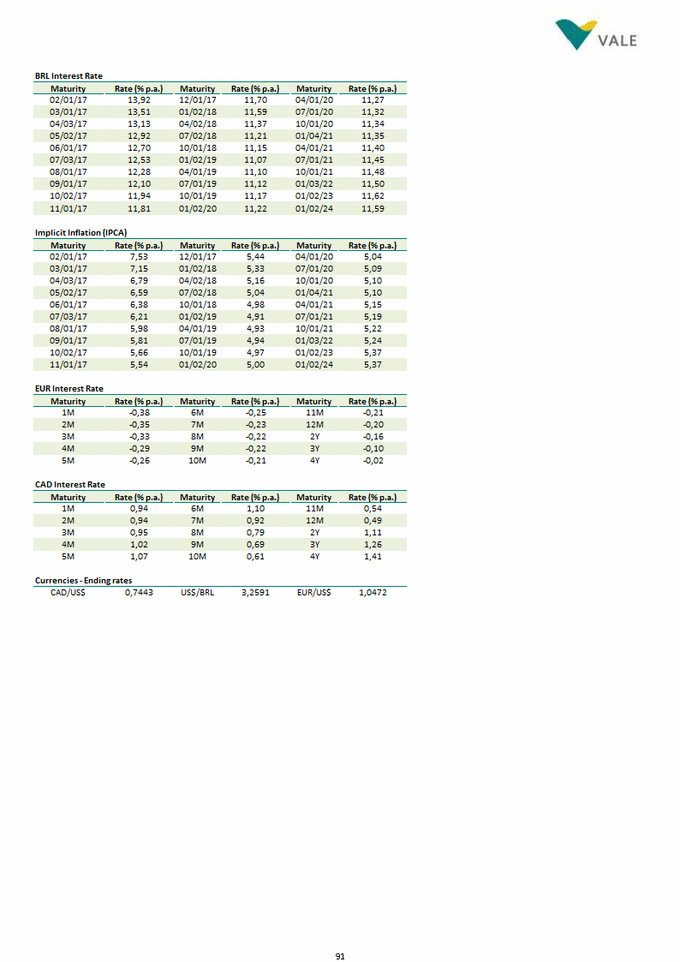
Members of the Board of Directors, Fiscal Council, Advisory Committees and Executive Officers Board of Directors Gueitiro Matsuo Genso Governance and Sustainability Committee Fernando Santos do Nascimento Vice-President Priscila Valle Costa de Oliveira Dan Antonio Marinho Conrado Eduardo Refinetti Guardia Oscar Augusto de Camargo Filho Chairman Lucio Azevedo Paulo José dos Reis Souza Aníbal Moreira dos Santos Alternate Moacir Nachbar Junior Alternate Francisco Ferreira Alexandre Sergio Mamede Rosa do Nascimento Luiz Mauricio Leuzinger Julio Sergio de Souza Cardozo Eduardo de Oliveira Rodrigues Filho Executive Officers Carlos Roberto de Assis Ferreira Murilo Pinto de Oliveira Ferreira Executive Officer (Human Resources, Health & Safety, Sustainability, Energy, Mergers and Acquisitions, Governance, Corporate Integrity, Legal and Tax) Advisory Committees of the Board of Directors Controlling Committee Luciano Siani Pires Moacir Nachbar Junior Executive Officer (Fertilizers, Coal and Strategy) Executive Development Committee Gerd Peter Poppinga Marcel Juviniano Barros Tatiana Boavista Barros Heil Executive Officer (Logistics and Mineral Research) Strategic Committee Jennifer Anne Maki Gueitiro Matsuo Genso Oscar Augusto de Camargo Filho Investors Relations and Controller Director Gilmar Dalilo Cezar Wanderley Murilo Muller Eduardo de Oliveira Rodrigues Filho Accounting Manager 92 TC-CRC-RJ 083305/O-8 Dioni Brasil Marcelo Marcolino Controllership Executive Manager Fernando Jorge Buso Gomes Finance Committee Rogerio Nogueira Eduardo de Salles Bartolomeo Luiz Carlos Trabuco Cappi Executive Officer (Base Metals) Murilo Pinto de Oliveira Ferreira Humberto Ramos de Freitas Fernando Jorge Buso Gomes Executive Officer (Ferrous) Oscar Augusto de Camargo Filho Roger Allan Downey Oswaldo Mário Pego de Amorim Azevedo Executive Officer (Finance and Investors Relations) Eduardo Cesar Pasa Clovis Torres Junior Chief Executive Officer Marcelo Gasparino Marcelo Marcolino Yoshitomo Nishimitsu Oswaldo Mário Pego de Amorim Azevedo Robson Rocha Paula Bicudo de Castro Magalhães Arthur Prado Silva Gilberto Antonio Vieira Raphael Manhães Martins Sandro Kohler Marcondes Alberto Guth Eduardo de Salles Bartolomeo Marcelo Amaral Moraes Motomu Takahashi Fiscal Council Marcel Juviniano Barros Ricardo Simonsen Eduardo de Oliveira Rodrigues Filho Fernando Jorge Buso Gomes Fernando Jorge Buso Gomes Chairman
